
CHENIERE ENERGY, INC.
April 19, 2017 ANALYST DAY
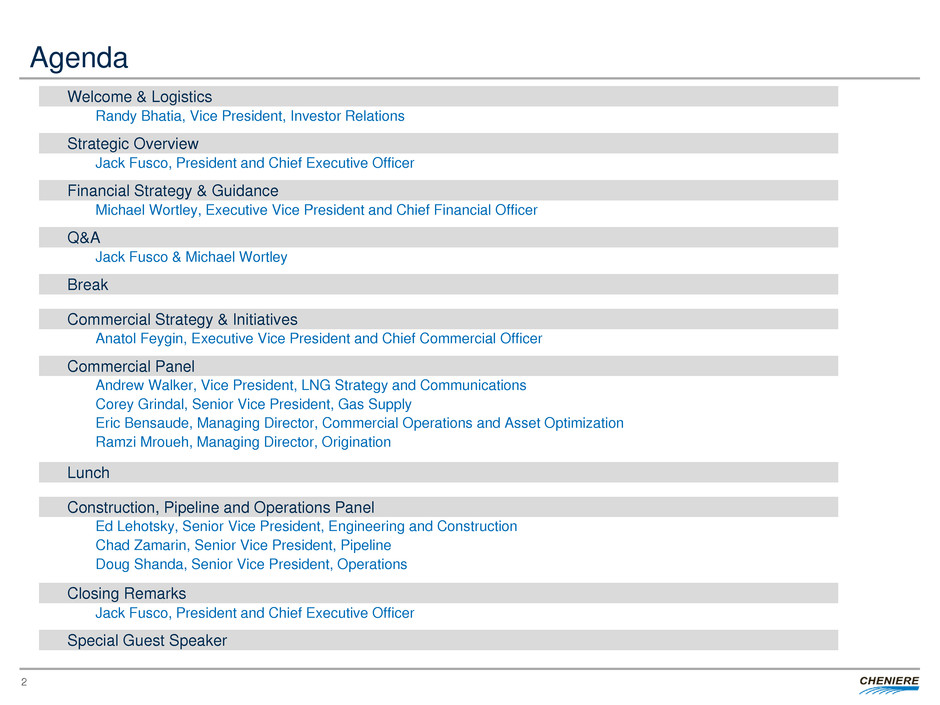
Agenda
Strategic Overview
Financial Strategy & Guidance
Welcome & Logistics
Q&A
Commercial Strategy & Initiatives
Construction, Pipeline and Operations Panel
Closing Remarks
Commercial Panel
Special Guest Speaker
Randy Bhatia, Vice President, Investor Relations
Jack Fusco, President and Chief Executive Officer
Michael Wortley, Executive Vice President and Chief Financial Officer
Jack Fusco & Michael Wortley
Anatol Feygin, Executive Vice President and Chief Commercial Officer
Andrew Walker, Vice President, LNG Strategy and Communications
Corey Grindal, Senior Vice President, Gas Supply
Eric Bensaude, Managing Director, Commercial Operations and Asset Optimization
Ramzi Mroueh, Managing Director, Origination
Ed Lehotsky, Senior Vice President, Engineering and Construction
Chad Zamarin, Senior Vice President, Pipeline
Doug Shanda, Senior Vice President, Operations
2
Break
Lunch
Jack Fusco, President and Chief Executive Officer

Safe Harbor Statements
Forward-Looking Statements
This presentation contains certain statements that are, or may be deemed to be, “forward-looking statements” within the meaning of Section 27A of the Securities Act of 1933, as amended, and Section 21E of the Securities
Exchange Act of 1934, as amended. All statements, other than statements of historical or present facts or conditions, included or incorporated by reference herein are “forward-looking statements.” Included among
“forward-looking statements” are, among other things:
• statements regarding the ability of Cheniere Energy Partners, L.P. to pay distributions to its unitholders or Cheniere Energy Partners LP Holdings, LLC or Cheniere Energy, Inc. to pay dividends to its
shareholders or participate in share or unit buybacks;
• statements regarding Cheniere Energy, Inc.’s, Cheniere Energy Partners LP Holdings, LLC’s or Cheniere Energy Partners, L.P.’s expected receipt of cash distributions from their respective subsidiaries;
• statements that Cheniere Energy Partners, L.P. expects to commence or complete construction of its proposed liquefied natural gas (“LNG”) terminals, liquefaction facilities, pipeline facilities or other projects,
or any expansions or portions thereof, by certain dates or at all;
• statements that Cheniere Energy, Inc. expects to commence or complete construction of its proposed LNG terminals, liquefaction facilities, pipeline facilities or other projects, or any expansions or portions then
of, by certain dates or at all;
• statements regarding future levels of domestic and international natural gas production, supply or consumption or future levels of LNG imports into or exports from North America and other countries worldwide,
or purchases of natural gas, regardless of the source of such information, or the transportation or other infrastructure, or demand for and prices related to natural gas, LNG or other hydrocarbon products;
• statements regarding any financing transactions or arrangements, or ability to enter into such transactions;
• statements relating to the construction of our proposed liquefaction facilities and natural gas liquefaction trains (“Trains”) and the construction of the Corpus Christi Pipeline, including statements concerning the
engagement of any engineering, procurement and construction ("EPC") contractor or other contractor and the anticipated terms and provisions of any agreement with any EPC or other contractor, and
anticipated costs related thereto;
• statements regarding any agreement to be entered into or performed substantially in the future, including any revenues anticipated to be received and the anticipated timing thereof, and statements regarding
the amounts of total LNG regasification, natural gas, liquefaction or storage capacities that are, or may become, subject to contracts;
• statements regarding counterparties to our commercial contracts, construction contracts and other contracts;
• statements regarding our planned development and construction of additional Trains or pipelines, including the financing of such Trains or pipelines;
• statements that our Trains, when completed, will have certain characteristics, including amounts of liquefaction capacities;
• statements regarding our business strategy, our strengths, our business and operation plans or any other plans, forecasts, projections or objectives, including anticipated revenues, capital expenditures,
maintenance and operating costs, run-rate SG&A estimates, cash flows, EBITDA, Adjusted EBITDA, run-rate EBITDA, contracted EBITDA, free cash flow, distributable cash flow, distributable cash flow per
share, Net Loss, As Adjusted, and Net Loss Per Share, As Adjusted, any or all of which are subject to change;
• statements regarding projections of revenues, expenses, earnings or losses, working capital or other financial items;
• statements regarding legislative, governmental, regulatory, administrative or other public body actions, approvals, requirements, permits, applications, filings, investigations, proceedings or decisions;
• statements regarding our anticipated LNG and natural gas marketing activities; and
• any other statements that relate to non-historical or future information.
These forward-looking statements are often identified by the use of terms and phrases such as “achieve,” “anticipate,” “believe,” “contemplate,” “develop,” “estimate,” “example,” “expect,” “forecast,” “goals,” “opportunities,”
“plan,” “potential,” “project,” “propose,” “subject to,” “strategy,” “target,” and similar terms and phrases, or by use of future tense. Although we believe that the expectations reflected in these forward-looking statements are
reasonable, they do involve assumptions, risks and uncertainties, and these expectations may prove to be incorrect. You should not place undue reliance on these forward-looking statements, which speak only as of the
date of this presentation. Our actual results could differ materially from those anticipated in these forward-looking statements as a result of a variety of factors, including those discussed in “Risk Factors” in the Cheniere
Energy, Inc., Cheniere Energy Partners, L.P. and Cheniere Energy Partners LP Holdings, LLC Annual Reports on Form 10-K filed with the SEC on February 24, 2017, which are incorporated by reference into this
presentation. All forward-looking statements attributable to us or persons acting on our behalf are expressly qualified in their entirety by these ”Risk Factors.” These forward-looking statements are made as of the date of
this presentation, and other than as required by law, we undertake no obligation to update or revise any forward-looking statement or provide reasons why actual results may differ, whether as a result of new information,
future events or otherwise.
Reconciliation to U.S. GAAP Financial Information
The following presentation includes certain “non-GAAP financial measures” as defined in Regulation G under the Securities Exchange Act of 1934, as amended. Schedules are included in the appendix hereto that reconcile
the non-GAAP financial measures included in the following presentation to the most directly comparable financial measures calculated and presented in accordance with U.S. GAAP.
3
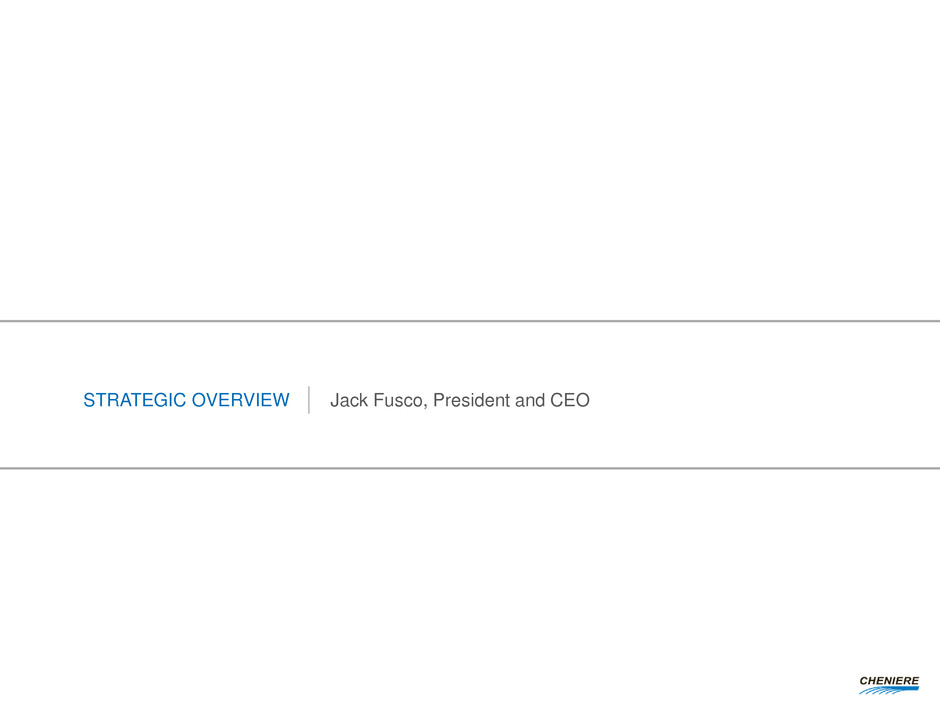
STRATEGIC OVERVIEW Jack Fusco, President and CEO

Key
Jack Fusco
President & Chief
Executive Officer
Michael
Wortley
EVP & Chief
Financial
Officer
Anatol
Feygin
EVP & Chief
Commercial
Officer
Doug
Shanda
SVP,
Operations
Ed
Lehotsky
SVP,
Engineering &
Construction
Chad
Zamarin
SVP, Pipeline
Tom Bullis
EVP & Chief
Administrative
Officer
Robert Fee
Chief of Staff &
(Acting) SVP,
External Affairs
Randy
Bhatia
VP, Investor
Relations
Andrew
Walker
VP, LNG
Strategy &
Comm.
Corey
Grindal
SVP, Gas
Supply
Eric
Bensaude
Managing
Director,
Commercial
Operations
Ramzi
Mroueh
Managing
Director,
Origination
Analyst Day Presenter
Sean
Markowitz
General
Counsel &
Corporate
Secretary
Analyst Day Participant
Organizational Chart - Analyst Day Participants
5
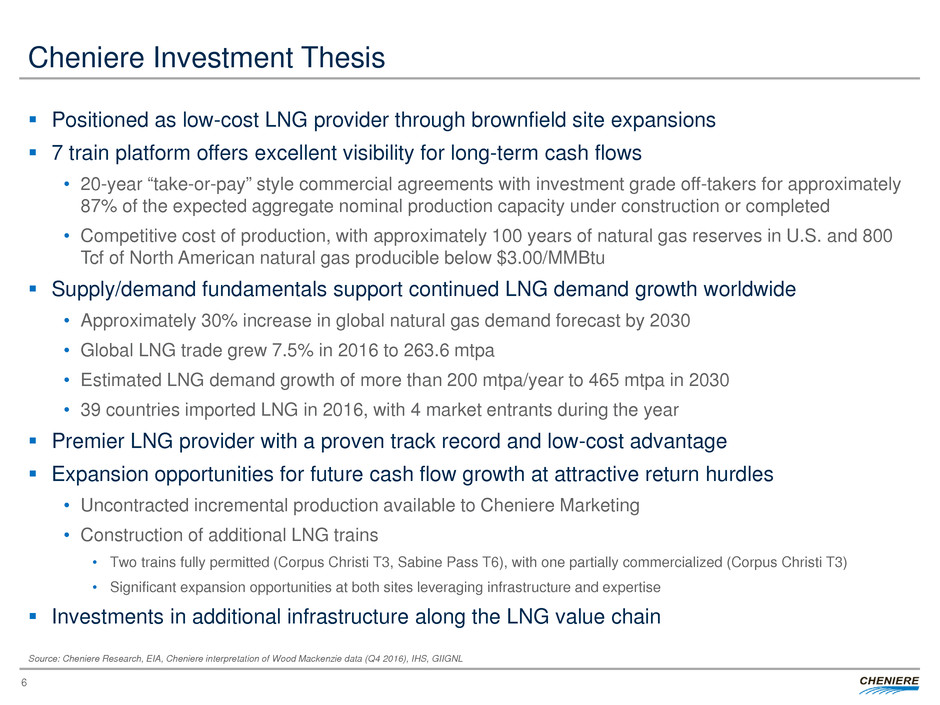
Cheniere Investment Thesis
Positioned as low-cost LNG provider through brownfield site expansions
7 train platform offers excellent visibility for long-term cash flows
• 20-year “take-or-pay” style commercial agreements with investment grade off-takers for approximately
87% of the expected aggregate nominal production capacity under construction or completed
• Competitive cost of production, with approximately 100 years of natural gas reserves in U.S. and 800
Tcf of North American natural gas producible below $3.00/MMBtu
Supply/demand fundamentals support continued LNG demand growth worldwide
• Approximately 30% increase in global natural gas demand forecast by 2030
• Global LNG trade grew 7.5% in 2016 to 263.6 mtpa
• Estimated LNG demand growth of more than 200 mtpa/year to 465 mtpa in 2030
• 39 countries imported LNG in 2016, with 4 market entrants during the year
Premier LNG provider with a proven track record and low-cost advantage
Expansion opportunities for future cash flow growth at attractive return hurdles
• Uncontracted incremental production available to Cheniere Marketing
• Construction of additional LNG trains
• Two trains fully permitted (Corpus Christi T3, Sabine Pass T6), with one partially commercialized (Corpus Christi T3)
• Significant expansion opportunities at both sites leveraging infrastructure and expertise
Investments in additional infrastructure along the LNG value chain
Source: Cheniere Research, EIA, Cheniere interpretation of Wood Mackenzie data (Q4 2016), IHS, GIIGNL
6
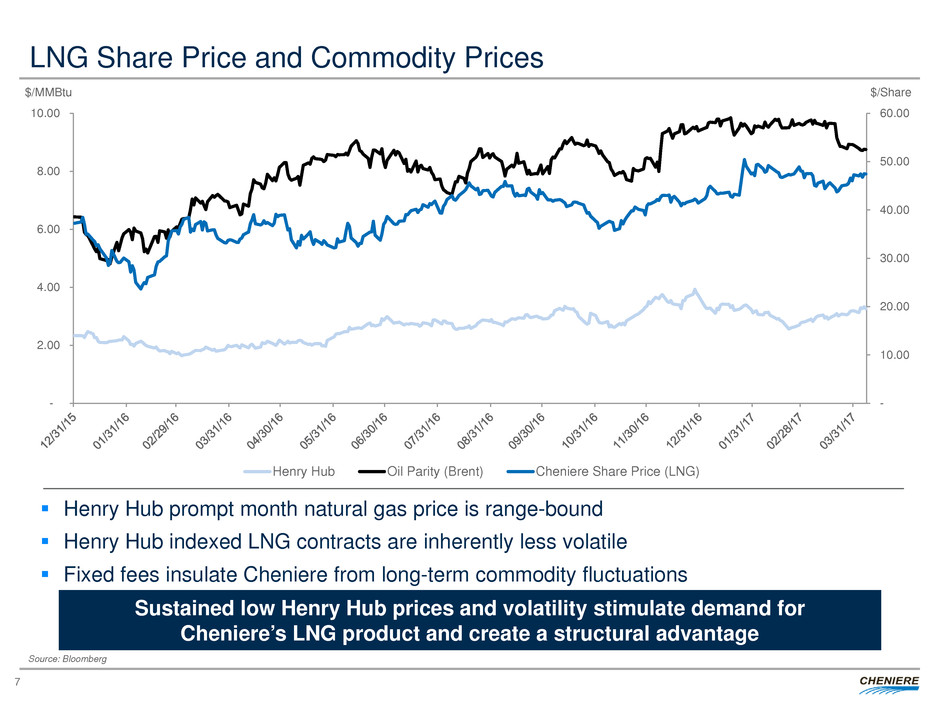
-
10.00
20.00
30.00
40.00
50.00
60.00
-
2.00
4.00
6.00
8.00
10.00
Henry Hub Oil Parity (Brent) Cheniere Share Price (LNG)
LNG Share Price and Commodity Prices
Henry Hub prompt month natural gas price is range-bound
Henry Hub indexed LNG contracts are inherently less volatile
Fixed fees insulate Cheniere from long-term commodity fluctuations
$/MMBtu $/Share
Sustained low Henry Hub prices and volatility stimulate demand for
Cheniere’s LNG product and create a structural advantage
7
Source: Bloomberg
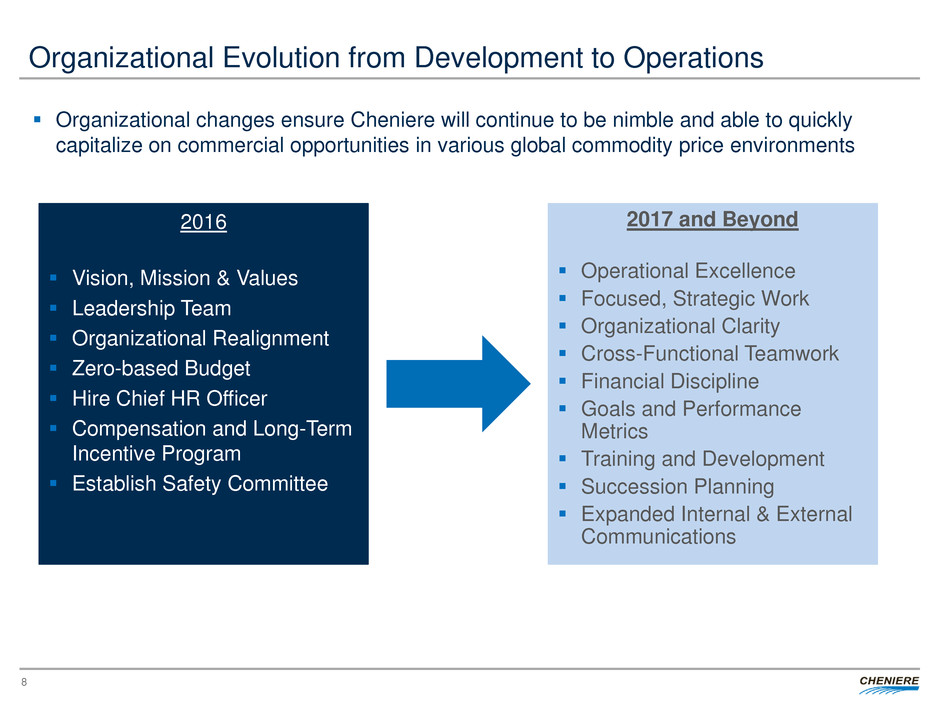
Organizational Evolution from Development to Operations
2016
Vision, Mission & Values
Leadership Team
Organizational Realignment
Zero-based Budget
Hire Chief HR Officer
Compensation and Long-Term
Incentive Program
Establish Safety Committee
2017 and Beyond
Operational Excellence
Focused, Strategic Work
Organizational Clarity
Cross-Functional Teamwork
Financial Discipline
Goals and Performance
Metrics
Training and Development
Succession Planning
Expanded Internal & External
Communications
Organizational changes ensure Cheniere will continue to be nimble and able to quickly
capitalize on commercial opportunities in various global commodity price environments
8
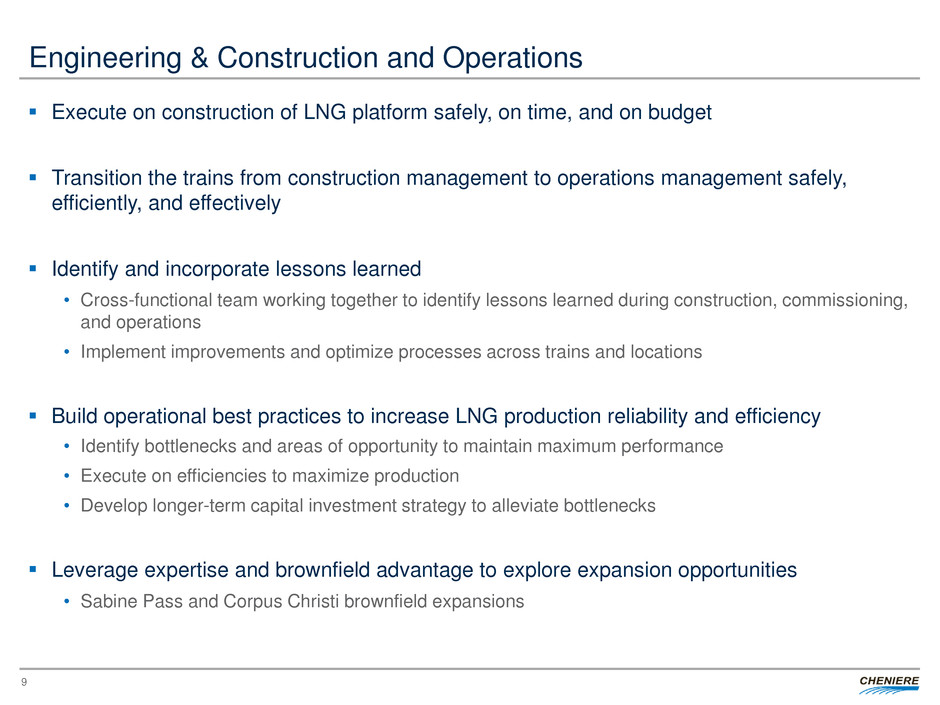
Engineering & Construction and Operations
Execute on construction of LNG platform safely, on time, and on budget
Transition the trains from construction management to operations management safely,
efficiently, and effectively
Identify and incorporate lessons learned
• Cross-functional team working together to identify lessons learned during construction, commissioning,
and operations
• Implement improvements and optimize processes across trains and locations
Build operational best practices to increase LNG production reliability and efficiency
• Identify bottlenecks and areas of opportunity to maintain maximum performance
• Execute on efficiencies to maximize production
• Develop longer-term capital investment strategy to alleviate bottlenecks
Leverage expertise and brownfield advantage to explore expansion opportunities
• Sabine Pass and Corpus Christi brownfield expansions
9
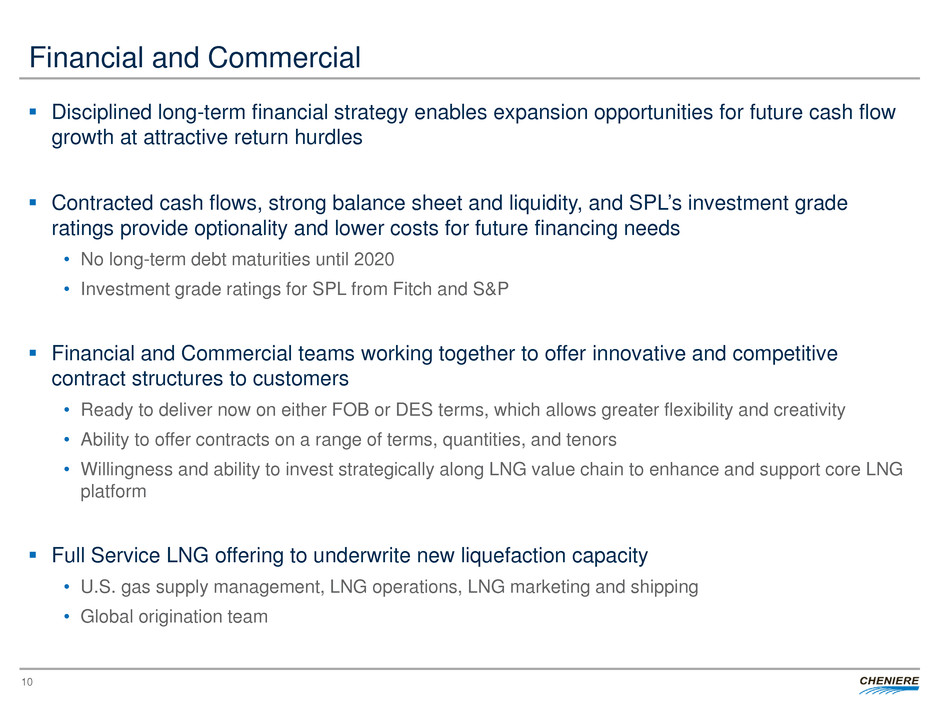
Financial and Commercial
Disciplined long-term financial strategy enables expansion opportunities for future cash flow
growth at attractive return hurdles
Contracted cash flows, strong balance sheet and liquidity, and SPL’s investment grade
ratings provide optionality and lower costs for future financing needs
• No long-term debt maturities until 2020
• Investment grade ratings for SPL from Fitch and S&P
Financial and Commercial teams working together to offer innovative and competitive
contract structures to customers
• Ready to deliver now on either FOB or DES terms, which allows greater flexibility and creativity
• Ability to offer contracts on a range of terms, quantities, and tenors
• Willingness and ability to invest strategically along LNG value chain to enhance and support core LNG
platform
Full Service LNG offering to underwrite new liquefaction capacity
• U.S. gas supply management, LNG operations, LNG marketing and shipping
• Global origination team
10

Existing Capacity
Newly Operational
Under Construction
0
50
100
150
200
250
300
350
400
450
500
2013 2014 2015 2016 2017 2018 2019 2020 2021 2022 2023 2024 2025 2026 2027 2028 2029 2030
Market tightening
Cheniere Ideally Positioned to Capitalize on Tightening LNG Market
The global LNG market is expected to need new competitive supplies to fill the approaching
supply/demand gap
LNG projects under construction are not expected to be sufficient to satisfy demand and ensure
stability of prices; insufficient FIDs starting in 2015 present a risk to LNG buyers and an
opportunity for Cheniere
With significant fully-permitted LNG capacity backed by construction and operating credibility,
Cheniere is positioned to provide incremental low-cost supply of LNG
11
Source: Cheniere Research estimates; Wood Mackenzie historical figures.
Projected Additional ~130 mtpa of LNG Supply Needed by 2030
New
Supply
Required

Leveraging Infrastructure and Expertise: A Key Competitive Advantage
Leverage Existing Infrastructure to Enable Competitive, Incremental Liquefaction Capacity
Able to leverage existing network to supply
incremental gas to feed additional trains
• Significant investment in infrastructure – one of largest
firm pipeline transportation capacity holders in U.S. with
more than 5 Bcf/d of firm capacity on 8 pipeline
systems
• Early mover advantage – difficult and costly to replicate
Control of significant gas infrastructure
• Supply diversity through access to key basins
• Procurement redundancy to ensure plant reliability
• Access to gas storage to manage varying production
levels and unplanned outages
Premier LNG provider with proven track record and
economies of scale
• ~$30 billion of project capital raised
• Project execution ahead of schedule and within budget
• Experienced workforce
Uniquely able to leverage existing infrastructure and add
incremental liquefaction capacity
• Site
• Utilities
• Marine Facilities
• Pipeline
• O&M Infrastructure
12
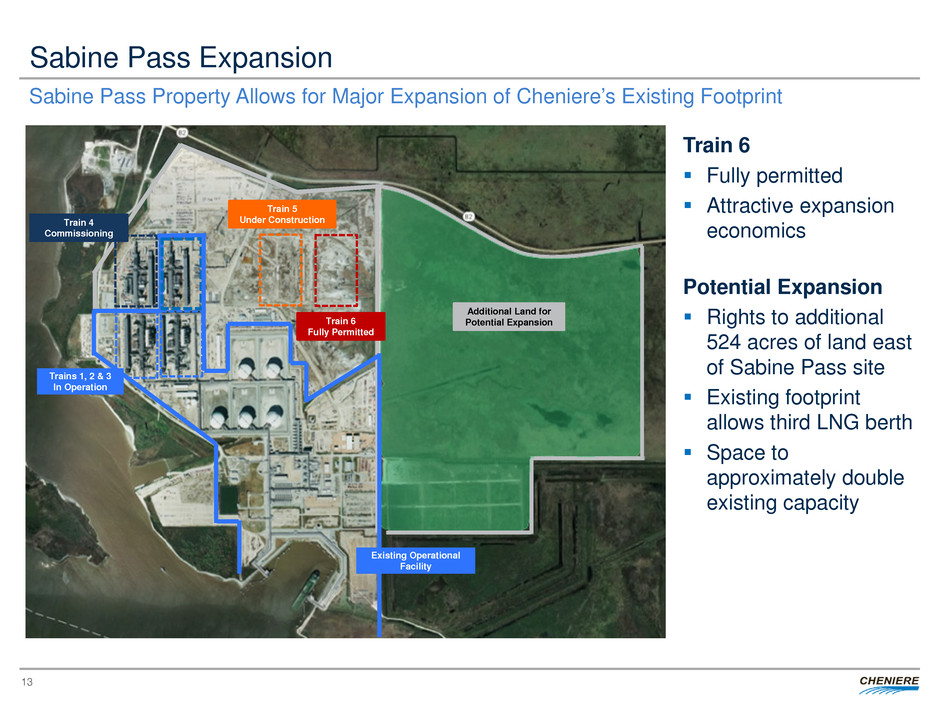
Sabine Pass Expansion
Sabine Pass Property Allows for Major Expansion of Cheniere’s Existing Footprint
Artist’s
rendition
Train 6
Fully permitted
Attractive expansion
economics
Potential Expansion
Rights to additional
524 acres of land east
of Sabine Pass site
Existing footprint
allows third LNG berth
Space to
approximately double
existing capacity
13
TBU
Trains 1, 2 & 3
In Operation
Train 4
Commissioning
Train 5
Under Construction
Additional Land for
Potential Expansion Train 6
Fully Permitted
Existing Operational
Facility
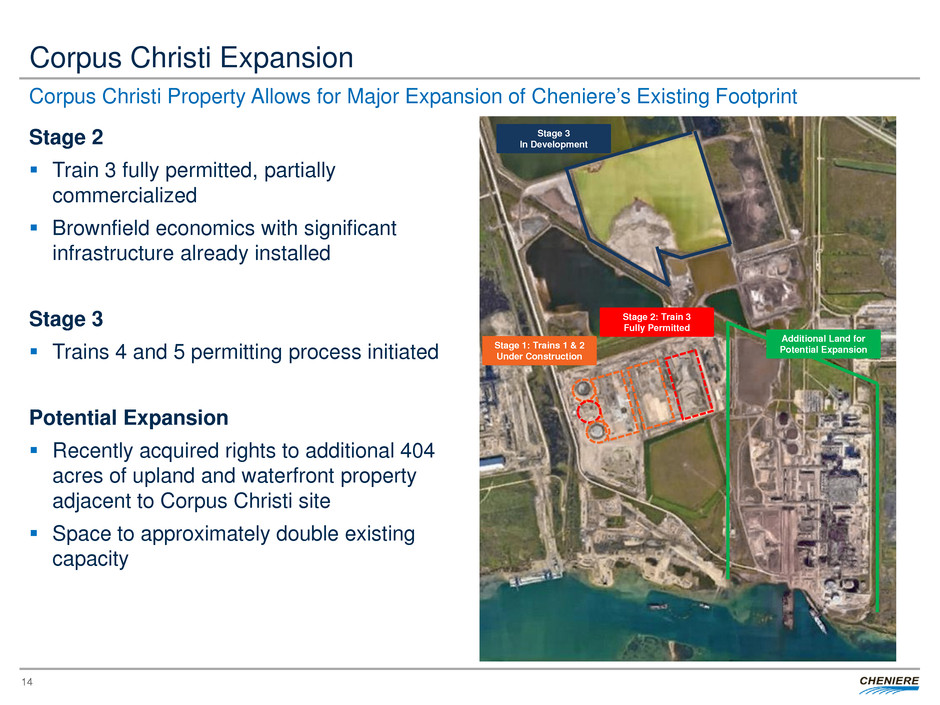
Additional Land for
Potential Expansion
Stage 3
In Development
Stage 2: Train 3
Fully Permitted
Stage 1: Trains 1 & 2
Under Construction
Corpus Christi Expansion
Corpus Christi Property Allows for Major Expansion of Cheniere’s Existing Footprint
Stage 2
Train 3 fully permitted, partially
commercialized
Brownfield economics with significant
infrastructure already installed
Stage 3
Trains 4 and 5 permitting process initiated
Potential Expansion
Recently acquired rights to additional 404
acres of upland and waterfront property
adjacent to Corpus Christi site
Space to approximately double existing
capacity
14
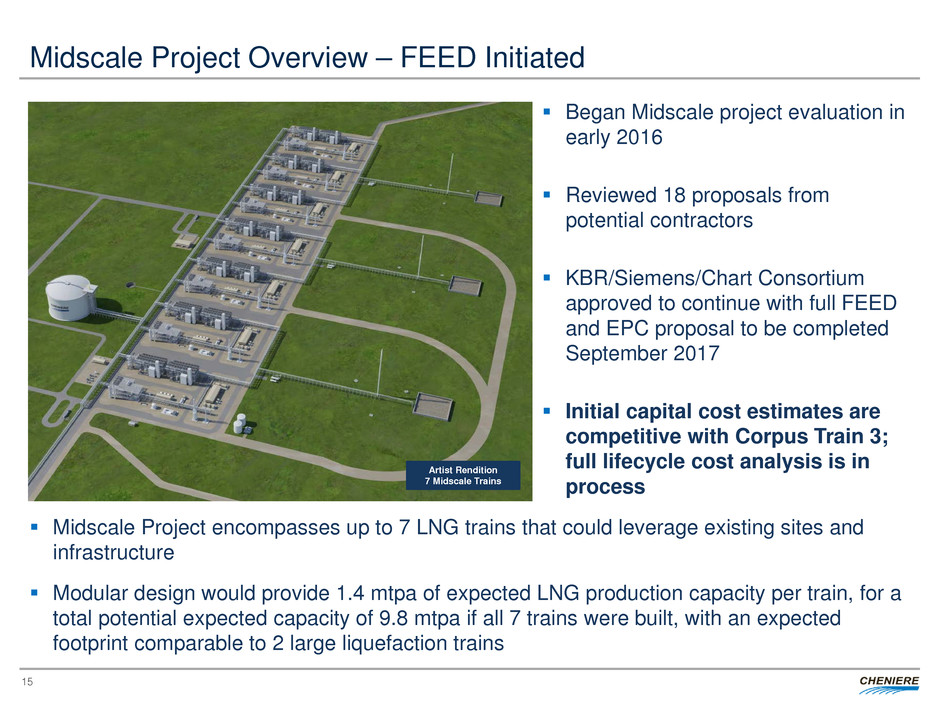
15
Midscale Project Overview – FEED Initiated
Began Midscale project evaluation in
early 2016
Reviewed 18 proposals from
potential contractors
KBR/Siemens/Chart Consortium
approved to continue with full FEED
and EPC proposal to be completed
September 2017
Initial capital cost estimates are
competitive with Corpus Train 3;
full lifecycle cost analysis is in
process
Midscale Project encompasses up to 7 LNG trains that could leverage existing sites and
infrastructure
Modular design would provide 1.4 mtpa of expected LNG production capacity per train, for a
total potential expected capacity of 9.8 mtpa if all 7 trains were built, with an expected
footprint comparable to 2 large liquefaction trains
Artist Rendition
7 Midscale Trains
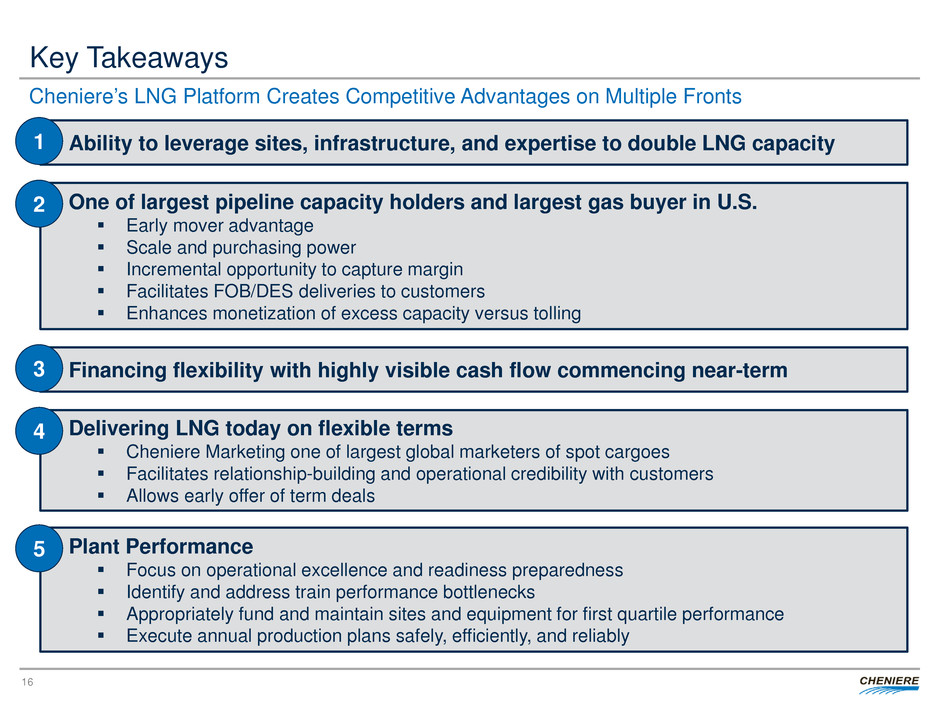
Key Takeaways
16
Ability to leverage sites, infrastructure, and expertise to double LNG capacity 1
One of largest pipeline capacity holders and largest gas buyer in U.S.
Early mover advantage
Scale and purchasing power
Incremental opportunity to capture margin
Facilitates FOB/DES deliveries to customers
Enhances monetization of excess capacity versus tolling
2
Delivering LNG today on flexible terms
Cheniere Marketing one of largest global marketers of spot cargoes
Facilitates relationship-building and operational credibility with customers
Allows early offer of term deals
4
Financing flexibility with highly visible cash flow commencing near-term 3
Plant Performance
Focus on operational excellence and readiness preparedness
Identify and address train performance bottlenecks
Appropriately fund and maintain sites and equipment for first quartile performance
Execute annual production plans safely, efficiently, and reliably
5
Cheniere’s LNG Platform Creates Competitive Advantages on Multiple Fronts

FINANCIAL STRATEGY
AND GUIDANCE Michael Wortley, EVP and CFO
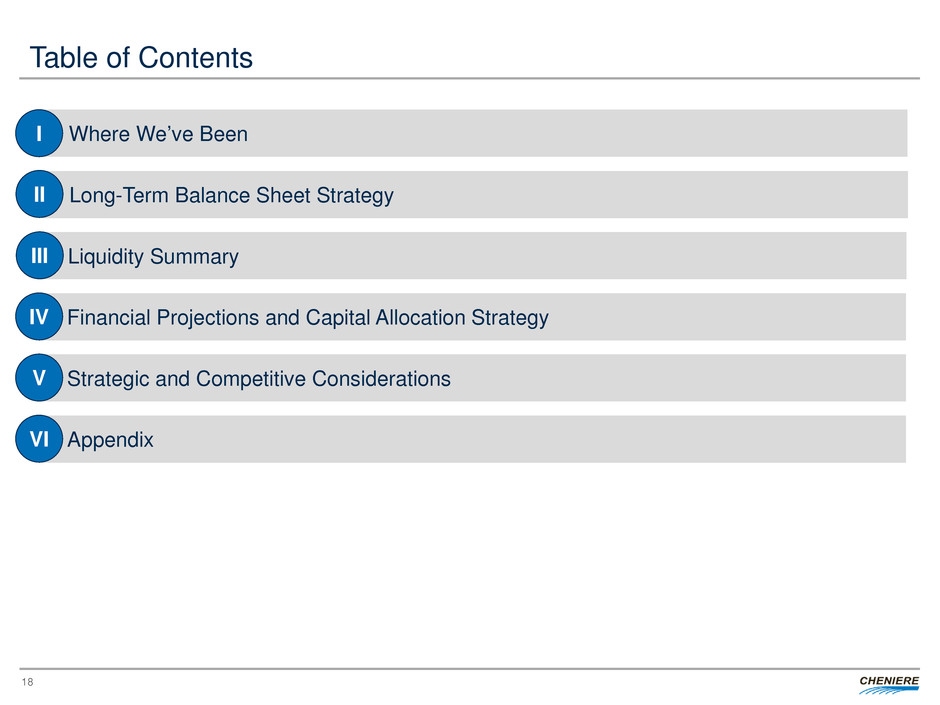
Table of Contents
18
Where We’ve Been I
Long-Term Balance Sheet Strategy II
Liquidity Summary III
Financial Projections and Capital Allocation Strategy IV
Strategic and Competitive Considerations V
Appendix VI

Current Cheniere Corporate Structure
19
Cheniere Energy, Inc.
(“CEI”)
(NYSE MKT: LNG)
Cheniere Energy
Partners, L.P.
(“CQP”)
(NYSE MKT: CQP)
Sabine Pass LNG,
L.P.
(“SPLNG”)
Sabine Pass
Liquefaction, LLC
(“SPL”)
Creole Trail Pipeline,
L.P.
(“CTPL”)
Cheniere Energy
Partners LP
Holdings, LLC
(“CQH”)
(NYSE MKT: CQH)
Corpus Christi
Liquefaction, LLC
(“CCL”)
Cheniere Corpus
Christi Holdings, LLC
(“CCH”)
Cheniere Corpus
Christi Pipeline, L.P. /
GP, LLC
(“CCPL”)
CQP GP
& IDRs
Cheniere Marketing,
LLC
(“CMI”)
SEC Filers
Note: This organizational chart is provided for illustrative purposes only, is not and does not purport to be a complete organizational chart of Cheniere
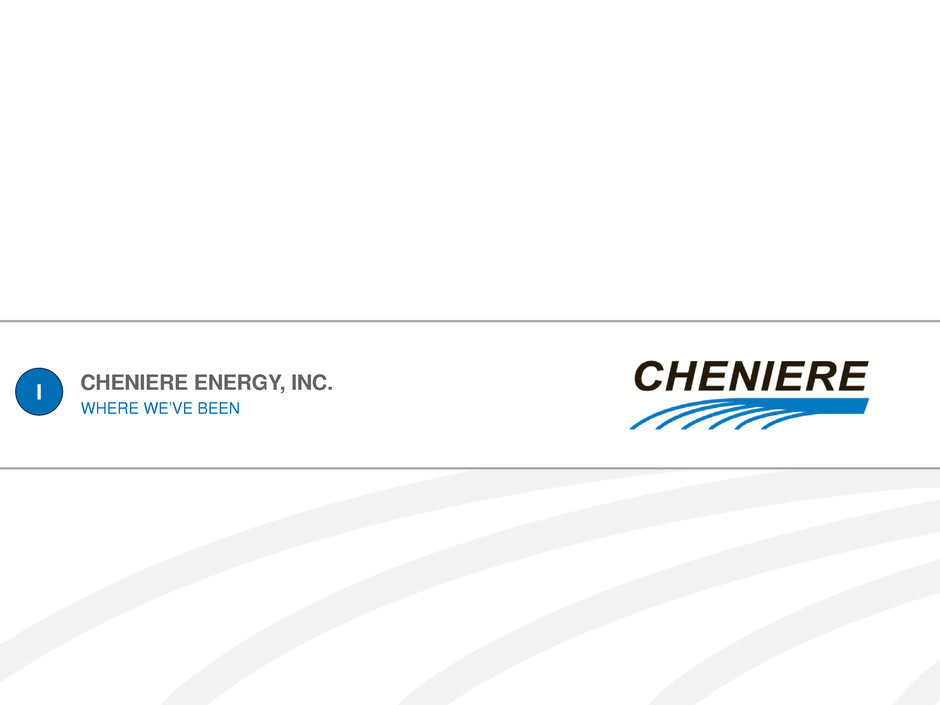
CHENIERE ENERGY, INC.
WHERE WE’VE BEEN
I
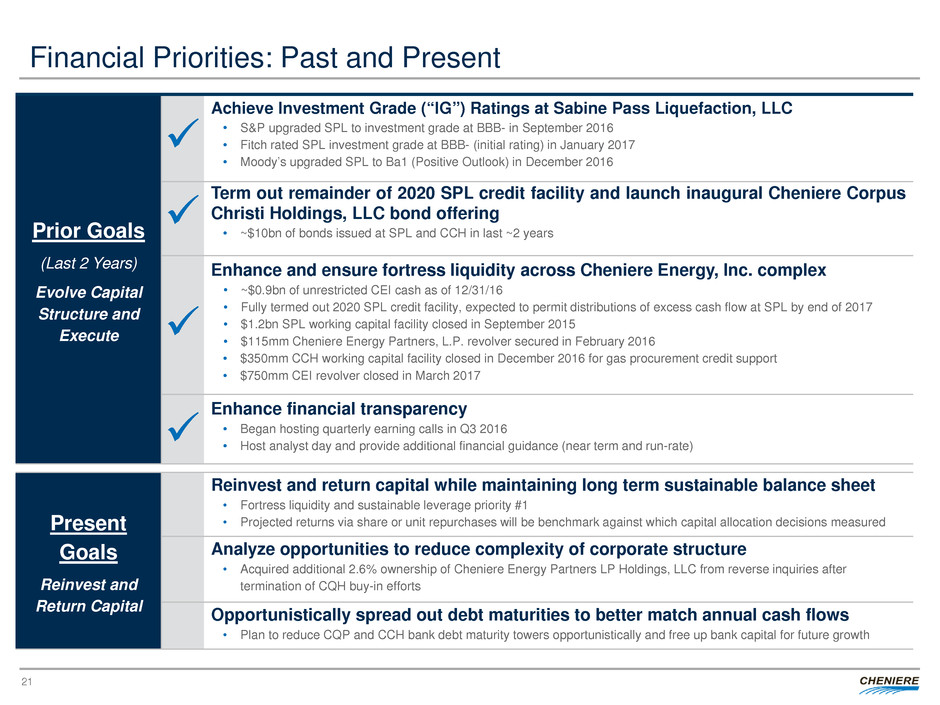
Financial Priorities: Past and Present
21
Prior Goals
(Last 2 Years)
Evolve Capital
Structure and
Execute
Achieve Investment Grade (“IG”) Ratings at Sabine Pass Liquefaction, LLC
• S&P upgraded SPL to investment grade at BBB- in September 2016
• Fitch rated SPL investment grade at BBB- (initial rating) in January 2017
• Moody’s upgraded SPL to Ba1 (Positive Outlook) in December 2016
Term out remainder of 2020 SPL credit facility and launch inaugural Cheniere Corpus
Christi Holdings, LLC bond offering
• ~$10bn of bonds issued at SPL and CCH in last ~2 years
Enhance and ensure fortress liquidity across Cheniere Energy, Inc. complex
• ~$0.9bn of unrestricted CEI cash as of 12/31/16
• Fully termed out 2020 SPL credit facility, expected to permit distributions of excess cash flow at SPL by end of 2017
• $1.2bn SPL working capital facility closed in September 2015
• $115mm Cheniere Energy Partners, L.P. revolver secured in February 2016
• $350mm CCH working capital facility closed in December 2016 for gas procurement credit support
• $750mm CEI revolver closed in March 2017
Enhance financial transparency
• Began hosting quarterly earning calls in Q3 2016
• Host analyst day and provide additional financial guidance (near term and run-rate)
Present
Goals
Reinvest and
Return Capital
Reinvest and return capital while maintaining long term sustainable balance sheet
• Fortress liquidity and sustainable leverage priority #1
• Projected returns via share or unit repurchases will be benchmark against which capital allocation decisions measured
Analyze opportunities to reduce complexity of corporate structure
• Acquired additional 2.6% ownership of Cheniere Energy Partners LP Holdings, LLC from reverse inquiries after
termination of CQH buy-in efforts
Opportunistically spread out debt maturities to better match annual cash flows
• Plan to reduce CQP and CCH bank debt maturity towers opportunistically and free up bank capital for future growth
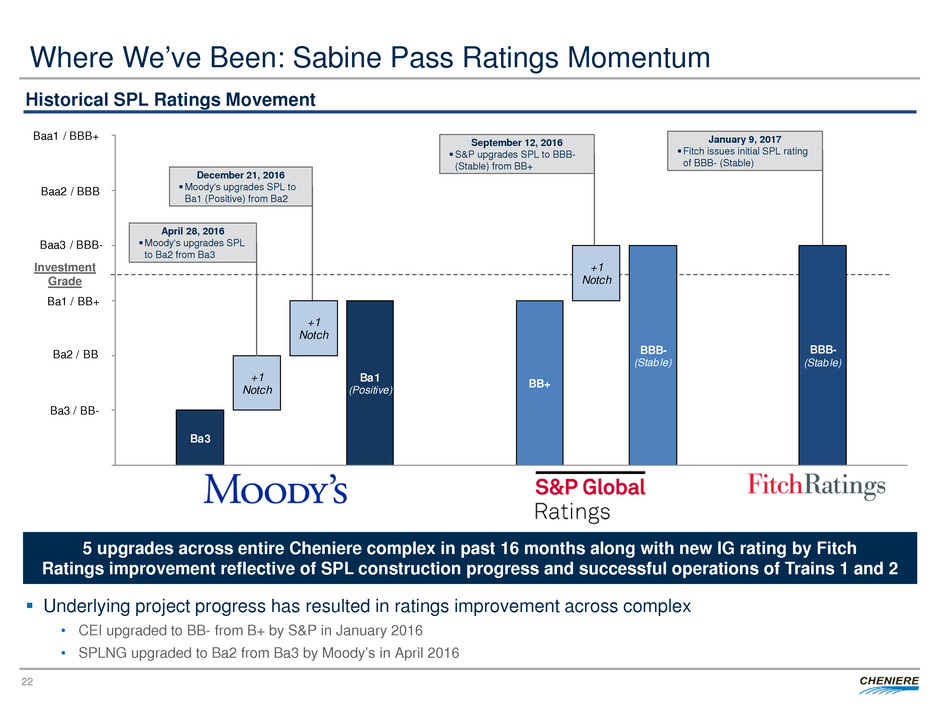
Ba3
BB++1Notch
BBB-
(Stab le)
+1
Notch
+1
Notch
Ba1
(Positive)
BBB-
(Stab le)
Ba3 / BB-
Ba2 / BB
Ba1 / BB+
Baa3 / BBB-
Investment
Grade
Baa2 / BBB
Baa1 / BBB+
Where We’ve Been: Sabine Pass Ratings Momentum
22
December 21, 2016
Moody's upgrades SPL to
Ba1 (Positive) from Ba2
September 12, 2016
S&P upgrades SPL to BBB-
(Stable) from BB+
January 9, 2017
Fitch issues initial SPL rating
of BBB- (Stable)
5 upgrades across entire Cheniere complex in past 16 months along with new IG rating by Fitch
Ratings improvement reflective of SPL construction progress and successful operations of Trains 1 and 2
April 28, 2016
Moody's upgrades SPL
to Ba2 from Ba3
Historical SPL Ratings Movement
Underlying project progress has resulted in ratings improvement across complex
• CEI upgraded to BB- from B+ by S&P in January 2016
• SPLNG upgraded to Ba2 from Ba3 by Moody’s in April 2016
Investment
Grade

5.875%
5.0% 5.0%
4.2%
7.0%
5.875%
418 bps
331 bps
235 bps
185 bps
529 bps
349 bps
0.0%
1.0%
2.0%
3.0%
4.0%
5.0%
6.0%
7.0%
8.0%
9.0%
SPL 2026s SPL 2027s SPL 2037s SPL 2028s – CCH 2024s CCH 2025s
Jun-16 Sep-16 Feb-17 Mar-17 – May-16 Dec-16
Coupon
G-Spread at Issue
Where We’ve Been: Spread Compression
23
Historical G-Spread(1) at Initial Issuance (Last 12 Months)
Strong performance against stated objectives and construction milestones has been rewarded
in the credit markets
Sabine Pass Liquefaction, LLC Corpus Christi Holdings, LLC
(1) Represents spread to 10-year U.S. Treasury note except for SPL 2037s, which represents spread to a Treasury yield based on weighted-average life
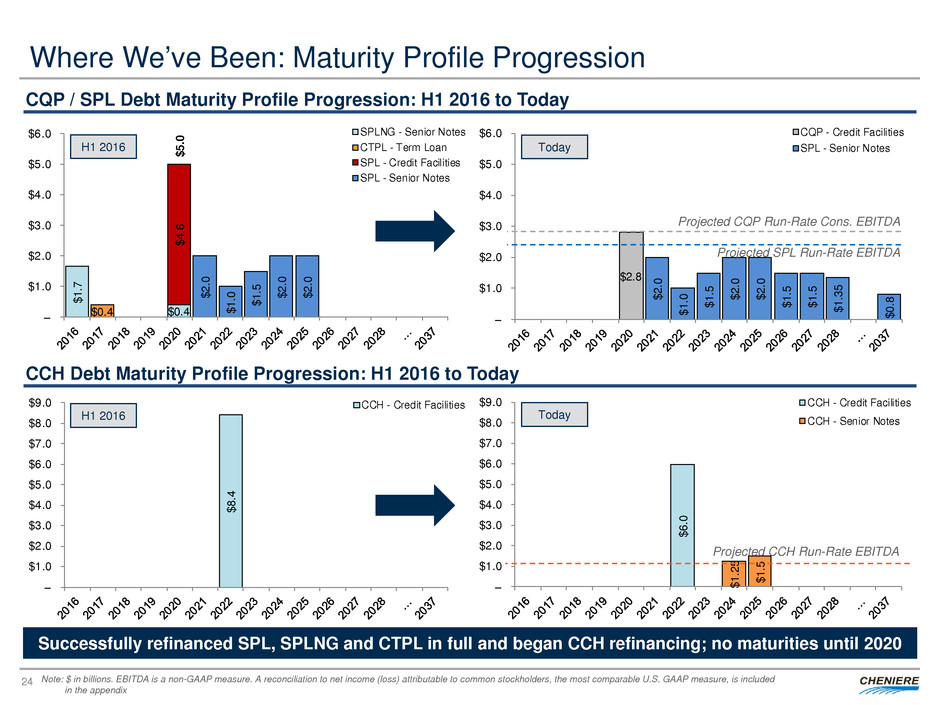
$8
.4
–
$1.0
$2.0
$3.0
$4.0
$5.0
$6.0
$7.0
$8.0
$9.0 CCH - Credit Facilities
$1
.2
5
$1
.5
$6
.0
–
$1.0
$2.0
$3.0
$4.0
$5.0
$6.0
$7.0
$8.0
$9.0 CCH - Credit Facilities
CCH - Senior Notes
$1
.7
$0.4 $0.4
$4
.6
$5
.0
$2
.0
$1
.0
$1
.5
$2
.0
$2
.0
–
$1.0
$2.0
$3.0
$4.0
$5.0
$6.0 SPLNG - Senior Notes
CTPL - Term Loan
SPL - Credit Facilities
SPL - Senior Notes
$2.8
$2
.0
$1
.0
$1
.5
$2
.0
$2
.0
$1
.5
$1
.5
$1
.3
5
$0
.8
–
$1.0
$2.0
$3.0
$4.0
$5.0
$6.0 CQP - Credit Facilities
SPL - Senior Notes
Where We’ve Been: Maturity Profile Progression
24
CQP / SPL Debt Maturity Profile Progression: H1 2016 to Today
Today
Successfully refinanced SPL, SPLNG and CTPL in full and began CCH refinancing; no maturities until 2020
H1 2016
Today
CCH Debt Maturity Profile Progression: H1 2016 to Today
H1 2016
Projected SPL Run-Rate EBITDA
Projected CQP Run-Rate Cons. EBITDA
Projected CCH Run-Rate EBITDA
Note: $ in billions. EBITDA is a non-GAAP measure. A reconciliation to net income (loss) attributable to common stockholders, the most comparable U.S. GAAP measure, is included
in the appendix
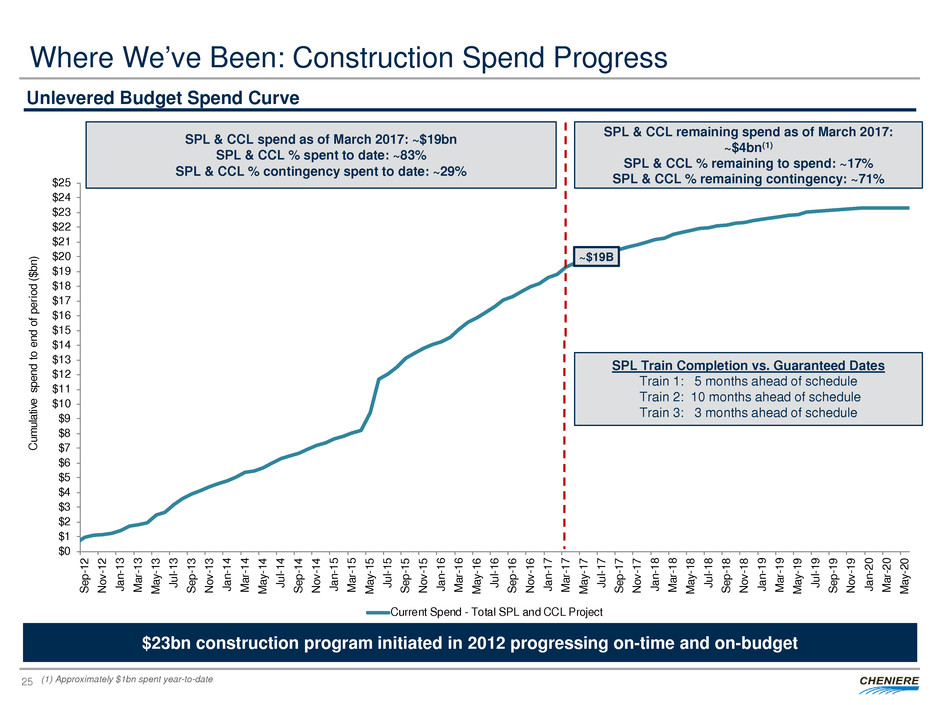
$0
$1
$2
$3
$4
$5
$6
$7
$8
$9
$10
$11
$12
$13
$14
$15
$16
$17
$18
$19
$20
$21
$22
$23
$24
$25
S
ep
-1
2
N
ov
-1
2
Ja
n-
13
M
ar
-1
3
M
ay
-1
3
Ju
l-1
3
S
ep
-1
3
N
ov
-1
3
Ja
n-
14
M
ar
-1
4
M
ay
-1
4
Ju
l-1
4
S
ep
-1
4
N
ov
-1
4
Ja
n-
15
M
ar
-1
5
M
ay
-1
5
Ju
l-1
5
S
ep
-1
5
N
ov
-1
5
Ja
n-
16
M
ar
-1
6
M
ay
-1
6
Ju
l-1
6
S
ep
-1
6
N
ov
-1
6
Ja
n-
17
M
ar
-1
7
M
ay
-1
7
Ju
l-1
7
S
ep
-1
7
N
ov
-1
7
Ja
n-
18
M
ar
-1
8
M
ay
-1
8
Ju
l-1
8
S
ep
-1
8
N
ov
-1
8
Ja
n-
19
M
ar
-1
9
M
ay
-1
9
Ju
l-1
9
S
ep
-1
9
N
ov
-1
9
Ja
n-
20
M
ar
-2
0
M
ay
-2
0
C
um
ul
at
iv
e
sp
en
d
to
e
nd
o
f p
er
io
d
($
bn
)
Current Spend - Total SPL and CCL Project
Where We’ve Been: Construction Spend Progress
25
$23bn construction program initiated in 2012 progressing on-time and on-budget
Unlevered Budget Spend Curve
SPL & CCL spend as of March 2017: ~$19bn
SPL & CCL % spent to date: ~83%
SPL & CCL % contingency spent to date: ~29%
SPL & CCL remaining spend as of March 2017:
~$4bn(1)
SPL & CCL % remaining to spend: ~17%
SPL & CCL % remaining contingency: ~71%
SPL Train Completion vs. Guaranteed Dates
Train 1: 5 months ahead of schedule
Train 2: 10 months ahead of schedule
Train 3: 3 months ahead of schedule
~$19B
(1) Approximately $1bn spent year-to-date
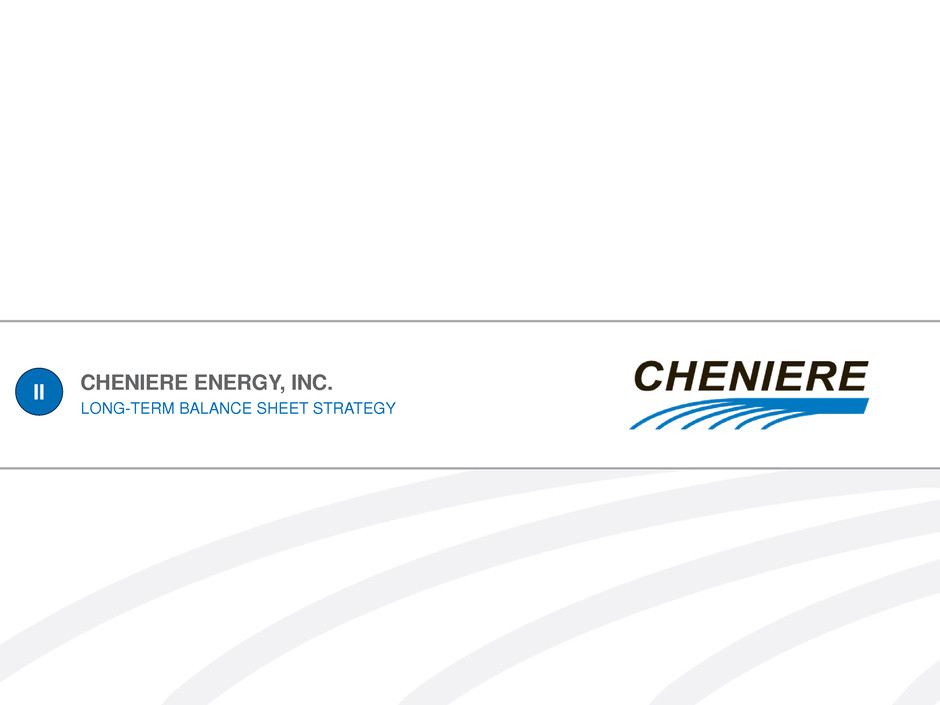
CHENIERE ENERGY, INC.
LONG-TERM BALANCE SHEET STRATEGY
II
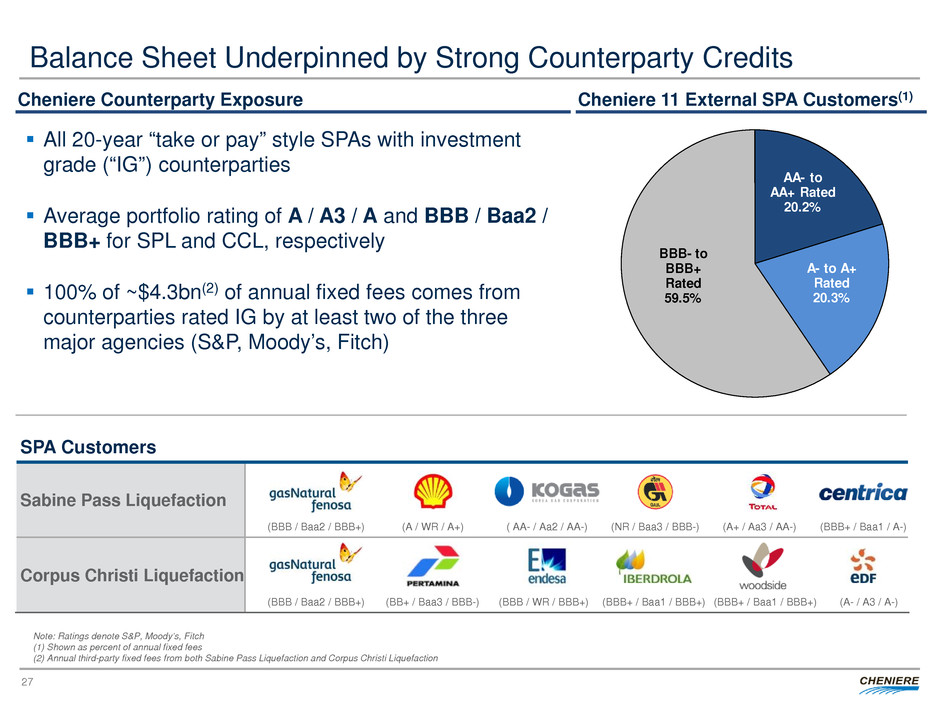
AA- to
AA+ Rated
20.2%
A- to A+
Rated
20.3%
BBB- to
BBB+
Rated
59.5%
Balance Sheet Underpinned by Strong Counterparty Credits
27
Cheniere Counterparty Exposure
SPA Customers
Sabine Pass Liquefaction
Corpus Christi Liquefaction
Cheniere 11 External SPA Customers(1)
(BBB / Baa2 / BBB+) (NR / Baa3 / BBB-) ( AA- / Aa2 / AA-) (A+ / Aa3 / AA-) (BBB+ / Baa1 / A-) (A / WR / A+)
(BBB / Baa2 / BBB+) (BBB+ / Baa1 / BBB+) (BBB / WR / BBB+) (BBB+ / Baa1 / BBB+) (A- / A3 / A-) (BB+ / Baa3 / BBB-)
All 20-year “take or pay” style SPAs with investment
grade (“IG”) counterparties
Average portfolio rating of A / A3 / A and BBB / Baa2 /
BBB+ for SPL and CCL, respectively
100% of ~$4.3bn(2) of annual fixed fees comes from
counterparties rated IG by at least two of the three
major agencies (S&P, Moody’s, Fitch)
Note: Ratings denote S&P, Moody’s, Fitch
(1) Shown as percent of annual fixed fees
(2) Annual third-party fixed fees from both Sabine Pass Liquefaction and Corpus Christi Liquefaction
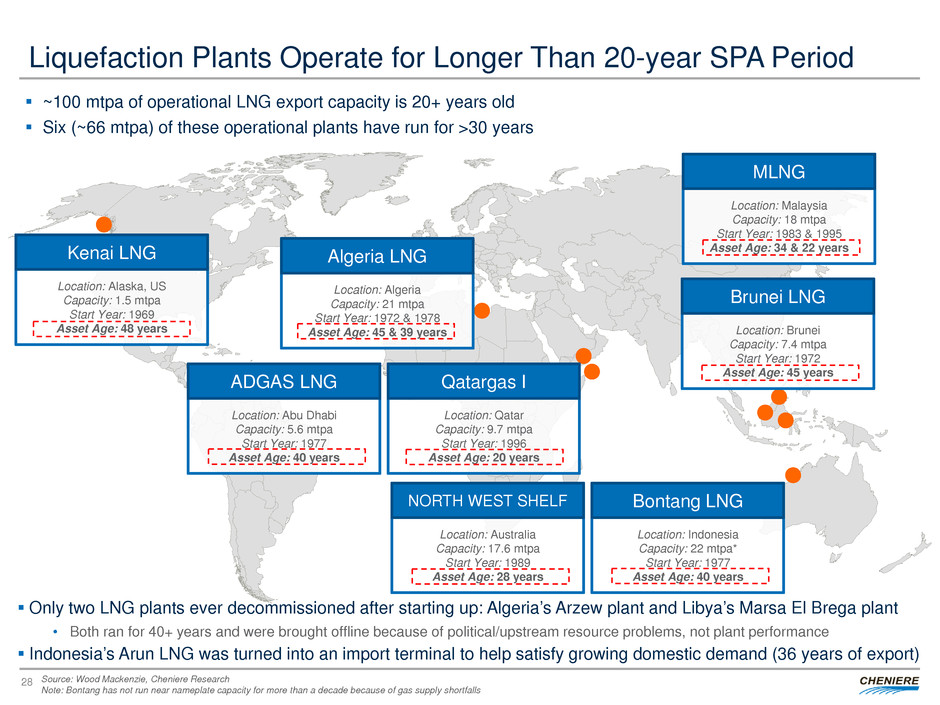
Liquefaction Plants Operate for Longer Than 20-year SPA Period
Location: Abu Dhabi
Capacity: 5.6 mtpa
Start Year: 1977
Asset Age: 40 years
ADGAS LNG
Location: Algeria
Capacity: 21 mtpa
Start Year: 1972 & 1978
Asset Age: 45 & 39 years
Algeria LNG
Location: Brunei
Capacity: 7.4 mtpa
Start Year: 1972
Asset Age: 45 years
Brunei LNG
Location: Malaysia
Capacity: 18 mtpa
Start Year: 1983 & 1995
Asset Age: 34 & 22 years
MLNG
Location: Alaska, US
Capacity: 1.5 mtpa
Start Year: 1969
Asset Age: 48 years
Kenai LNG
Only two LNG plants ever decommissioned after starting up: Algeria’s Arzew plant and Libya’s Marsa El Brega plant
• Both ran for 40+ years and were brought offline because of political/upstream resource problems, not plant performance
Indonesia’s Arun LNG was turned into an import terminal to help satisfy growing domestic demand (36 years of export)
Location: Qatar
Capacity: 9.7 mtpa
Start Year: 1996
Asset Age: 20 years
Qatargas I
Location: Australia
Capacity: 17.6 mtpa
Start Year: 1989
Asset Age: 28 years
NORTH WEST SHELF
Location: Indonesia
Capacity: 22 mtpa*
Start Year: 1977
Asset Age: 40 years
Bontang LNG
28
~100 mtpa of operational LNG export capacity is 20+ years old
Six (~66 mtpa) of these operational plants have run for >30 years
Source: Wood Mackenzie, Cheniere Research
Note: Bontang has not run near nameplate capacity for more than a decade because of gas supply shortfalls
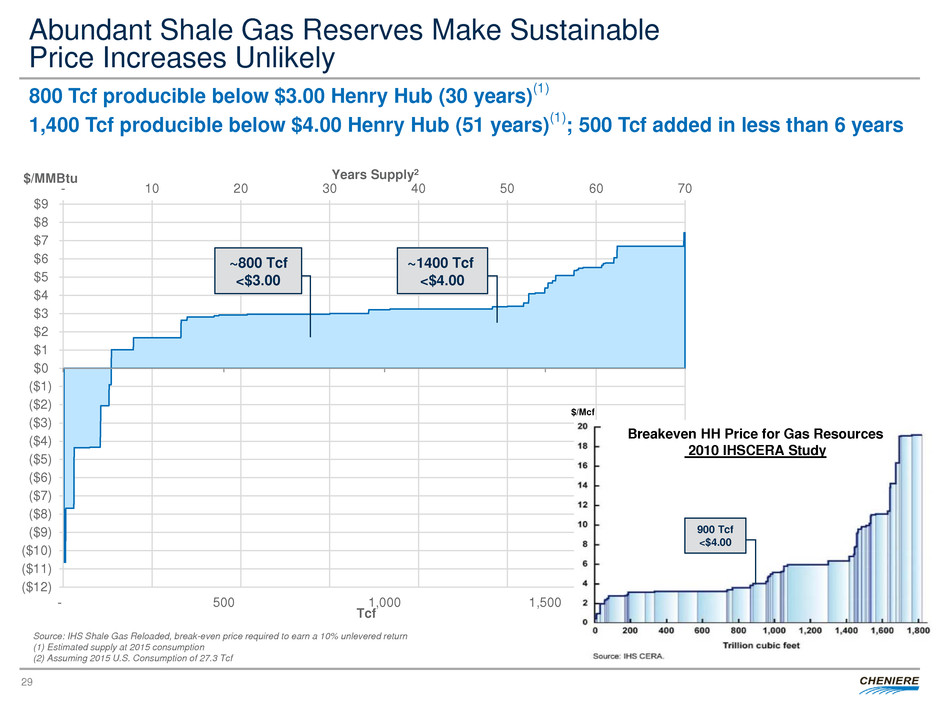
Abundant Shale Gas Reserves Make Sustainable
Price Increases Unlikely
- 10 20 30 40 50 60 70
($12)
($11)
($10)
($9)
($8)
($7)
($6)
($5)
($4)
($3)
($2)
($1)
$0
$1
$2
$3
$4
$5
$6
$7
$8
$9
- 500 1,000 1,500
Years Supply2 $/MMBtu
Tcf
29
800 Tcf producible below $3.00 Henry Hub (30 years)(1)
1,400 Tcf producible below $4.00 Henry Hub (51 years)(1); 500 Tcf added in less than 6 years
$/Mcf
Breakeven HH Price for Gas Resources
2010 IHSCERA Study
900 Tcf
<$4.00
Source: IHS Shale Gas Reloaded, break-even price required to earn a 10% unlevered return
(1) Estimated supply at 2015 consumption
(2) Assuming 2015 U.S. Consumption of 27.3 Tcf
~800 Tcf
<$3.00
~1400 Tcf
<$4.00
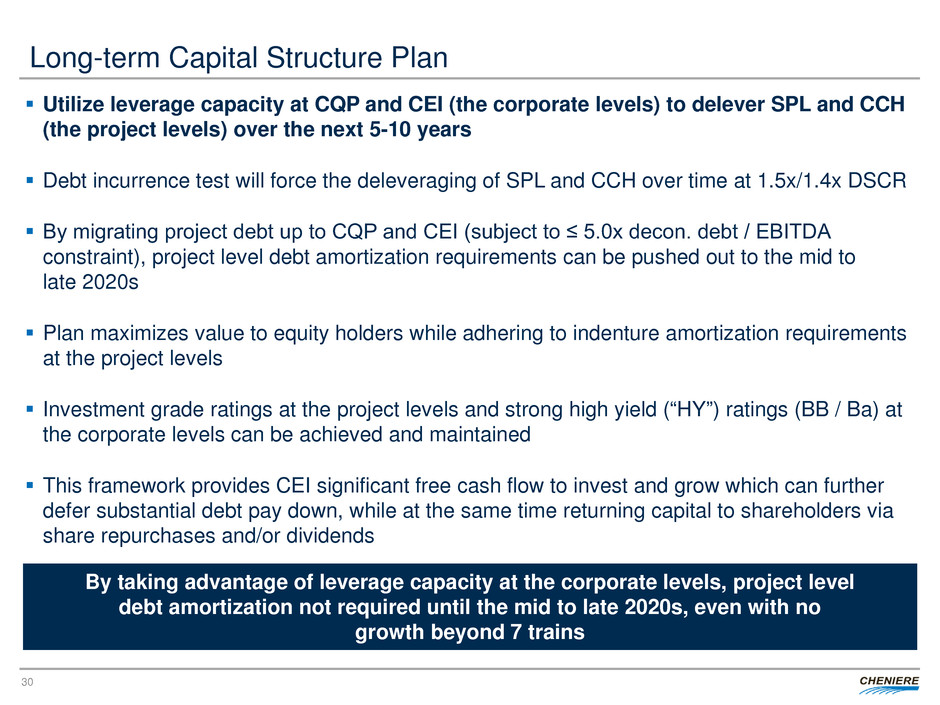
Long-term Capital Structure Plan
30
Utilize leverage capacity at CQP and CEI (the corporate levels) to delever SPL and CCH
(the project levels) over the next 5-10 years
Debt incurrence test will force the deleveraging of SPL and CCH over time at 1.5x/1.4x DSCR
By migrating project debt up to CQP and CEI (subject to ≤ 5.0x decon. debt / EBITDA
constraint), project level debt amortization requirements can be pushed out to the mid to
late 2020s
Plan maximizes value to equity holders while adhering to indenture amortization requirements
at the project levels
Investment grade ratings at the project levels and strong high yield (“HY”) ratings (BB / Ba) at
the corporate levels can be achieved and maintained
This framework provides CEI significant free cash flow to invest and grow which can further
defer substantial debt pay down, while at the same time returning capital to shareholders via
share repurchases and/or dividends
By taking advantage of leverage capacity at the corporate levels, project level
debt amortization not required until the mid to late 2020s, even with no
growth beyond 7 trains

Target Leverage for Projects and Corporates
31
Cheniere Energy Inc.
(NYSE MKT: LNG)
“BB” Ratings Profile
5.0x Target Debt / EBITDA
Cheniere Energy Partners, L.P.
(NYSE MKT: CQP)
“BB” Ratings Profile
5.0x Target Debt / EBITDA
Sabine Pass
Liquefaction, LLC
“BBB” Ratings Profile
1.5x avg. Target DSCR
Cheniere Corpus
Christi Holdings, LLC
“BBB” Ratings Profile
1.4x avg. Target DSCR
C
or
po
ra
te
s
P
ro
je
ct
s
CQP and CEI expected to have debt capacity to migrate up a portion of the project debt at leverage
consistent with BB / Ba ratings at the corporate levels and BBB / Baa project ratings at SPL and CCH
DSCR = Average Debt Service
Coverage Ratio:
Debt / EBITDA:
Scheduled Debt Service
(Principal Repayments +
Interest Payments)
Contracted EBITDA
Deconsolidated Debt Outstanding
Annual Deconsolidated
Contracted EBITDA
Note: Chart represents simplified organizational structure. Contracted EBITDA is a non-GAAP measure – a reconciliation of net income (loss) attributable to common stockholders, the most comparable
U.S. GAAP measure, is included in the appendix
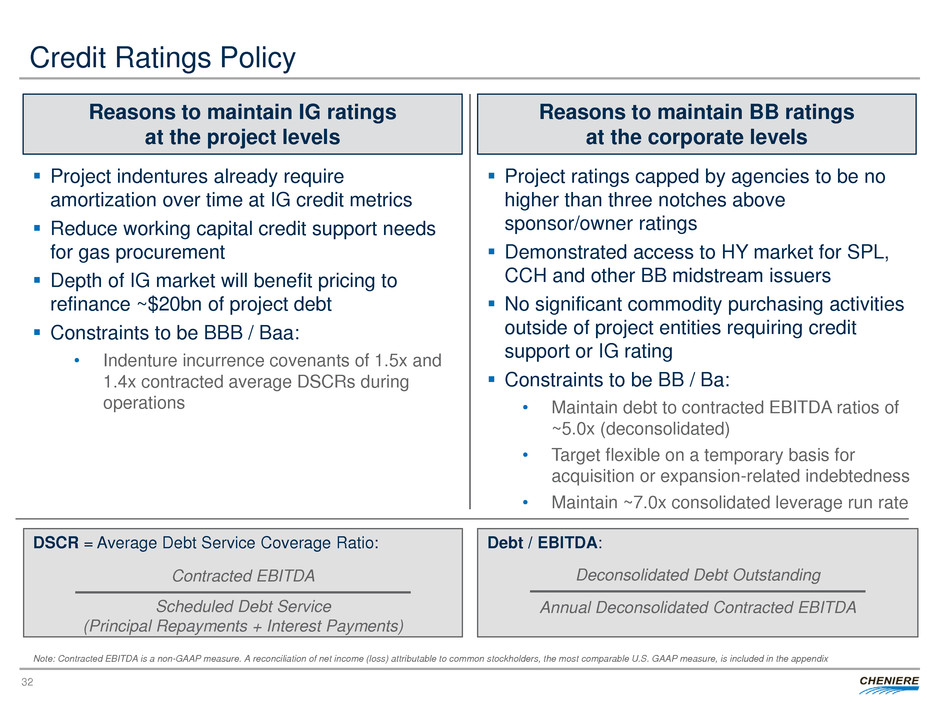
Credit Ratings Policy
32
Project ratings capped by agencies to be no
higher than three notches above
sponsor/owner ratings
Demonstrated access to HY market for SPL,
CCH and other BB midstream issuers
No significant commodity purchasing activities
outside of project entities requiring credit
support or IG rating
Constraints to be BB / Ba:
• Maintain debt to contracted EBITDA ratios of
~5.0x (deconsolidated)
• Target flexible on a temporary basis for
acquisition or expansion-related indebtedness
• Maintain ~7.0x consolidated leverage run rate
Project indentures already require
amortization over time at IG credit metrics
Reduce working capital credit support needs
for gas procurement
Depth of IG market will benefit pricing to
refinance ~$20bn of project debt
Constraints to be BBB / Baa:
• Indenture incurrence covenants of 1.5x and
1.4x contracted average DSCRs during
operations
Reasons to maintain IG ratings
at the project levels
Reasons to maintain BB ratings
at the corporate levels
DSCR = Average Debt Service Coverage Ratio: Debt / EBITDA:
Contracted EBITDA
Scheduled Debt Service
(Principal Repayments + Interest Payments)
Deconsolidated Debt Outstanding
Annual Deconsolidated Contracted EBITDA
Note: Contracted EBITDA is a non-GAAP measure. A reconciliation of net income (loss) attributable to common stockholders, the most comparable U.S. GAAP measure, is included in the appendix
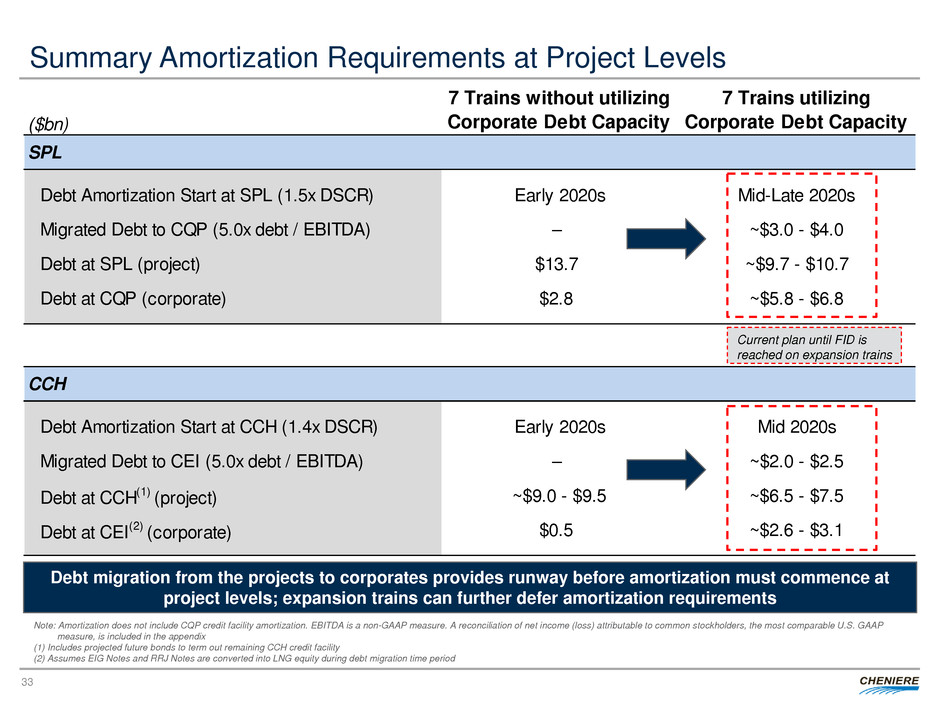
($bn)
7 Trains without utilizing
Corporate Debt Capacity
7 Trains utilizing
Corporate Debt Capacity
SPL
Debt Amortization Start at SPL (1.5x DSCR) Early 2020s Mid-Late 2020s
Migrated Debt to CQP (5.0x debt / EBITDA) – ~$3.0 - $4.0
Debt at SPL (project) $13.7 ~$9.7 - $10.7
Debt at CQP (corporate) $2.8 ~$5.8 - $6.8
CCH
Debt Amortization Start at CCH (1.4x DSCR) Early 2020s Mid 2020s
Migrated Debt to CEI (5.0x debt / EBITDA) – ~$2.0 - $2.5
Debt at CCH(1) (project) ~$9.0 - $9.5 ~$6.5 - $7.5
Debt at CEI(2) (corporate) $0.5 ~$2.6 - $3.1
Summary Amortization Requirements at Project Levels
33
Debt migration from the projects to corporates provides runway before amortization must commence at
project levels; expansion trains can further defer amortization requirements
Current plan until FID is
reached on expansion trains
Note: Amortization does not include CQP credit facility amortization. EBITDA is a non-GAAP measure. A reconciliation of net income (loss) attributable to common stockholders, the most comparable U.S. GAAP
measure, is included in the appendix
(1) Includes projected future bonds to term out remaining CCH credit facility
(2) Assumes EIG Notes and RRJ Notes are converted into LNG equity during debt migration time period
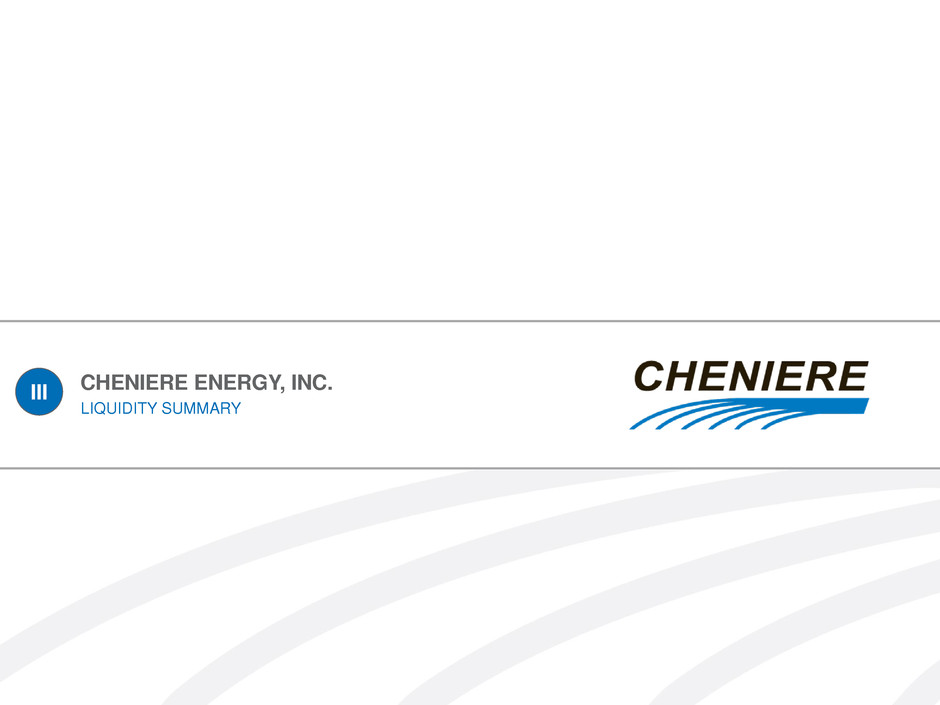
CHENIERE ENERGY, INC.
LIQUIDITY SUMMARY
III
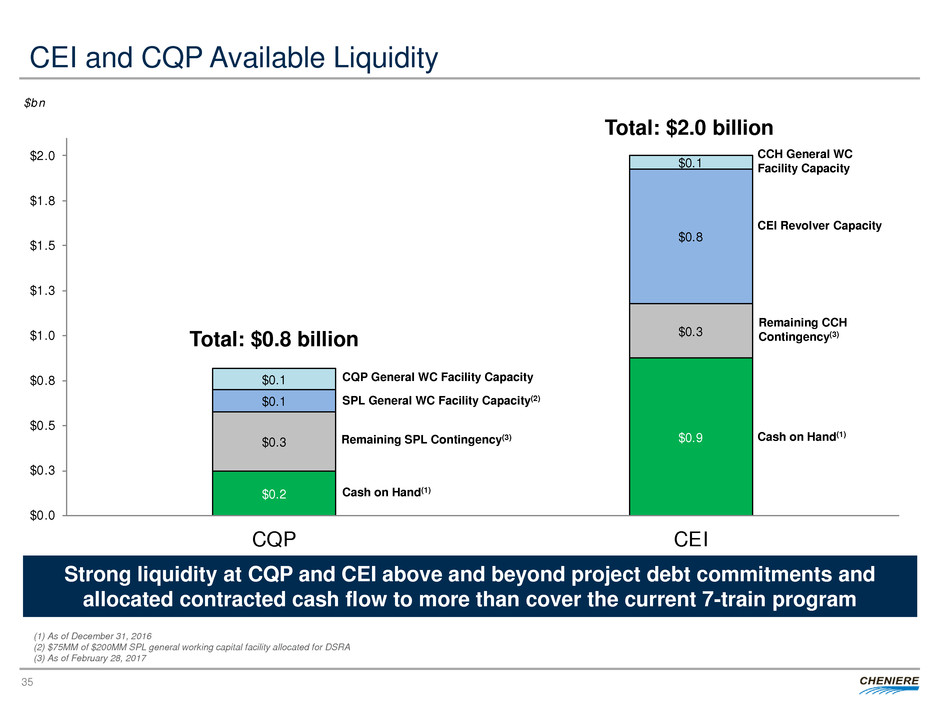
$0.2
$0.9 $0.3
$0.3
$0.1
$0.8
$0.1
$0.1
$0.0
$0.3
$0.5
$0.8
$1.0
$1.3
$1.5
$1.8
$2.0
CQP CEI
$bn
CEI and CQP Available Liquidity
35
Cash on Hand(1)
CEI Revolver Capacity
Remaining SPL Contingency(3)
Remaining CCH
Contingency(3)
Cash on Hand(1)
Total: $0.8 billion
Total: $2.0 billion
CQP General WC Facility Capacity
SPL General WC Facility Capacity(2)
CCH General WC
Facility Capacity
Strong liquidity at CQP and CEI above and beyond project debt commitments and
allocated contracted cash flow to more than cover the current 7-train program
(1) As of December 31, 2016
(2) $75MM of $200MM SPL general working capital facility allocated for DSRA
(3) As of February 28, 2017
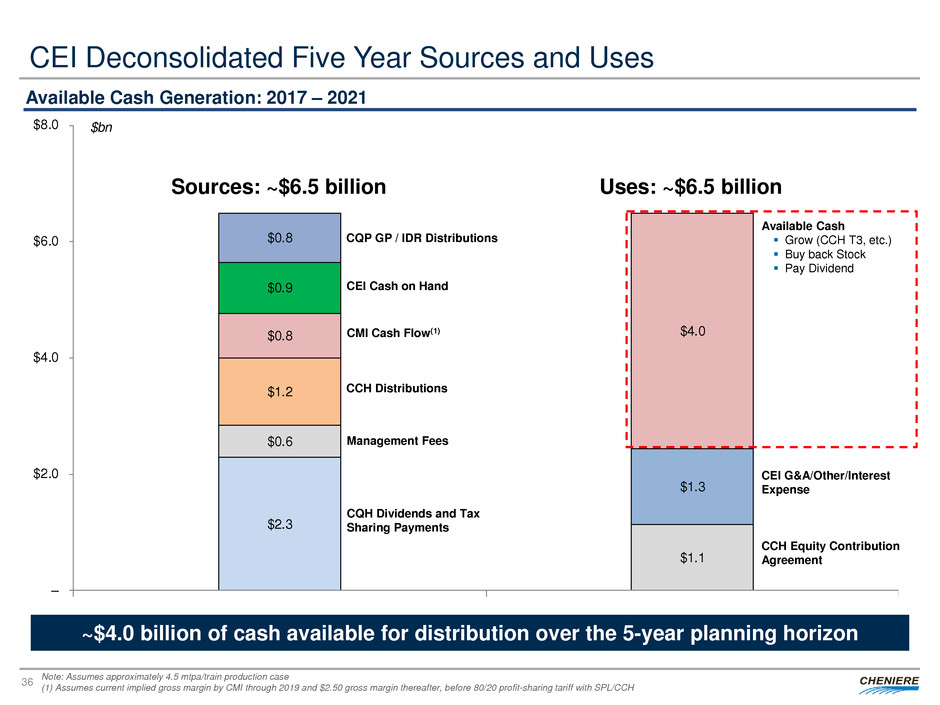
Note: Assumes approximately 4.5 mtpa/train production case
(1) Assumes current implied gross margin by CMI through 2019 and $2.50 gross margin thereafter, before 80/20 profit-sharing tariff with SPL/CCH
$2.3
$0.6
$1.1
$1.2
$0.8
$1.3
$0.9
$0.8
$4.0
–
$2.0
$4.0
$6.0
$8.0
Sources Uses
$bn
CEI Deconsolidated Five Year Sources and Uses
36
Available Cash Generation: 2017 – 2021
CEI G&A/Other/Interest
Expense
Management Fees
Available Cash
Grow (CCH T3, etc.)
Buy back Stock
Pay Dividend
CCH Distributions
Sources: ~$6.5 billion
CQP GP / IDR Distributions
CMI Cash Flow(1)
CEI Cash on Hand
CQH Dividends and Tax
Sharing Payments
CCH Equity Contribution
Agreement
Uses: ~$6.5 billion
~$4.0 billion of cash available for distribution over the 5-year planning horizon
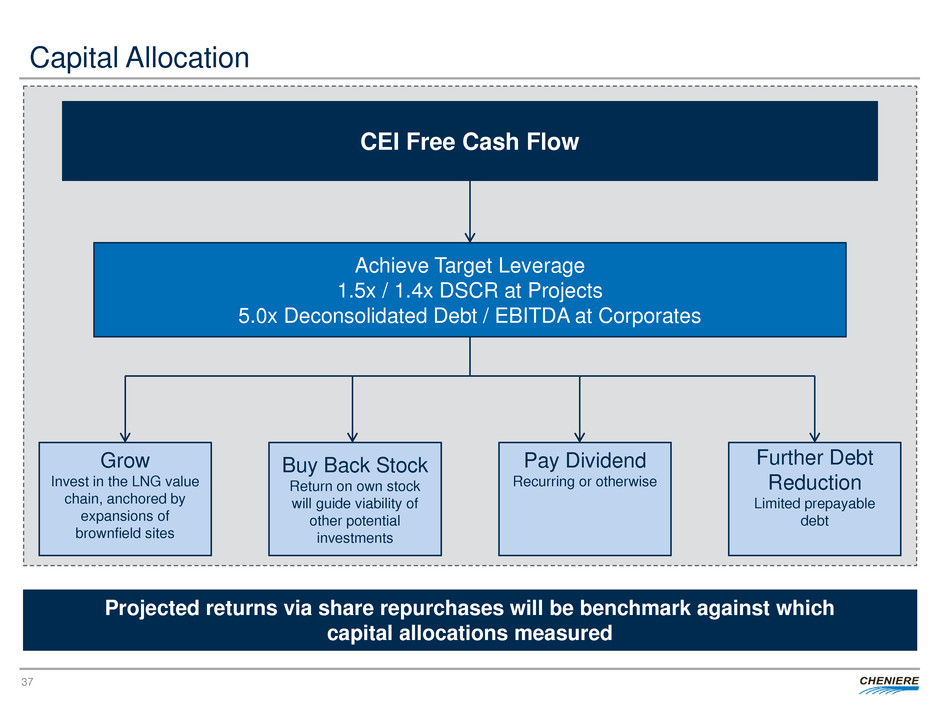
Capital Allocation
37
CEI Free Cash Flow
Achieve Target Leverage
1.5x / 1.4x DSCR at Projects
5.0x Deconsolidated Debt / EBITDA at Corporates
Grow
Invest in the LNG value
chain, anchored by
expansions of
brownfield sites
Buy Back Stock
Return on own stock
will guide viability of
other potential
investments
Pay Dividend
Recurring or otherwise
Projected returns via share repurchases will be benchmark against which
capital allocations measured
Further Debt
Reduction
Limited prepayable
debt
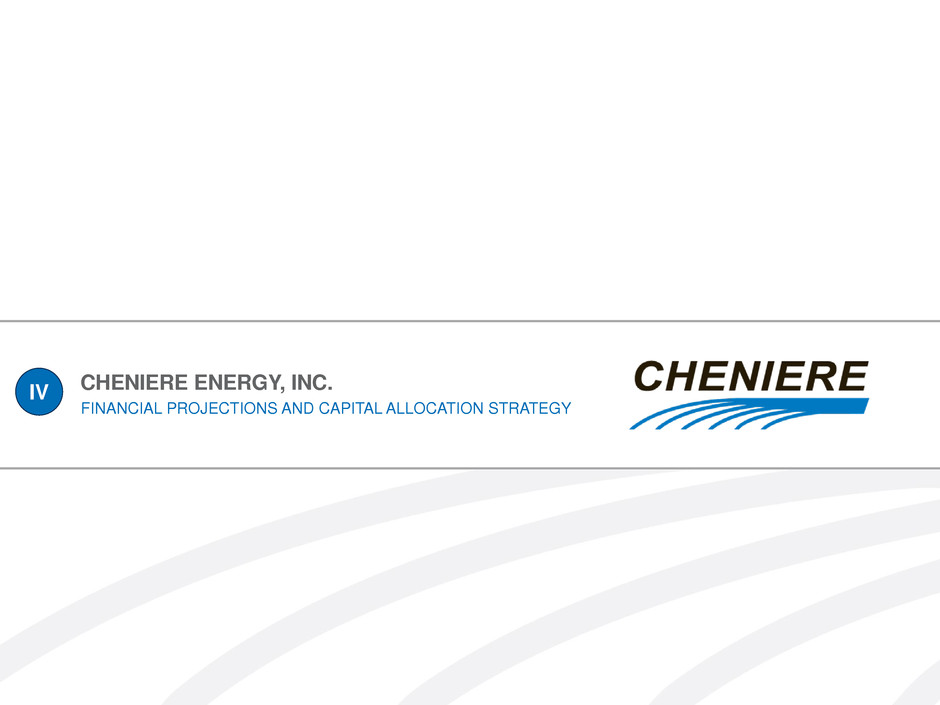
CHENIERE ENERGY, INC.
FINANCIAL PROJECTIONS AND CAPITAL ALLOCATION STRATEGY
IV

Consolidated vs. Deconsolidated
39
CEI
CCH
Consolidated
Deconsolidated
SPL
CQP and CQH
SPLNG CTPL
CMI
CCPL CCL
Minority
Interest
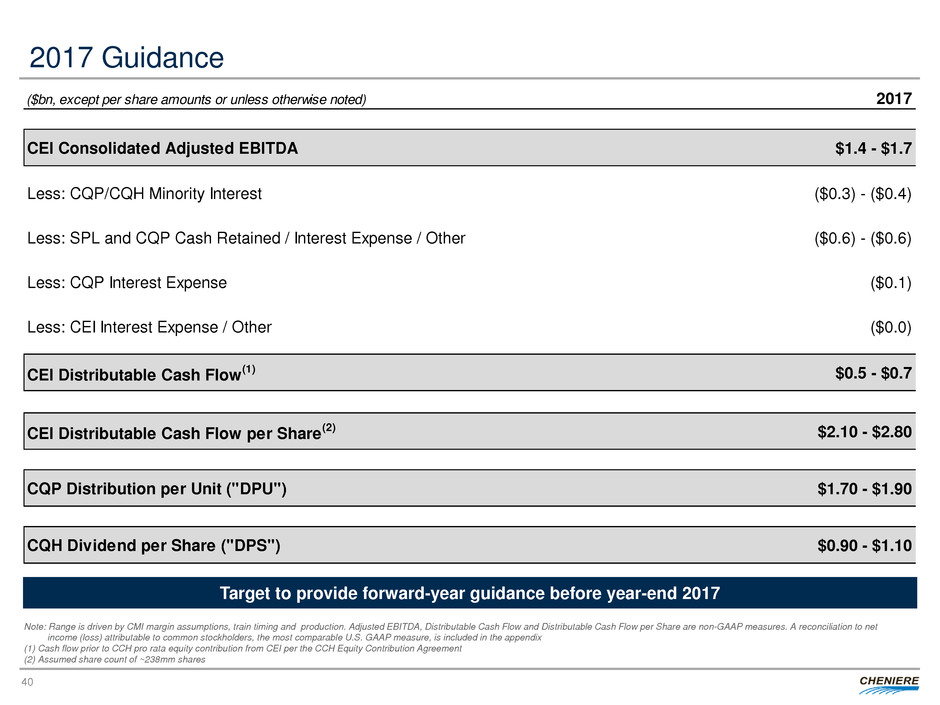
2017 Guidance
40
Note: Range is driven by CMI margin assumptions, train timing and production. Adjusted EBITDA, Distributable Cash Flow and Distributable Cash Flow per Share are non-GAAP measures. A reconciliation to net
income (loss) attributable to common stockholders, the most comparable U.S. GAAP measure, is included in the appendix
(1) Cash flow prior to CCH pro rata equity contribution from CEI per the CCH Equity Contribution Agreement
(2) Assumed share count of ~238mm shares
Target to provide forward-year guidance before year-end 2017
($bn, except per share amounts or unless otherwise noted) 2017
CEI Consolidated Adjusted EBITDA $1.4 - $1.7
Less: CQP/CQH Minority Interest ($0.3) - ($0.4)
Less: SPL and CQP Cash Retained / Interest Expense / Other ($0.6) - ($0.6)
Less: CQP Interest Expense ($0.1)
Less: CEI Interest Expense / Other ($0.0)
CEI Distributable Cash Flow(1) $0.5 - $0.7
CEI Distributable Cash Flow per Share(2) $2.10 - $2.80
CQP Distribution per Unit ("DPU") $1.70 - $1.90
CQH Dividend per Share ("DPS") $0.90 - $1.10
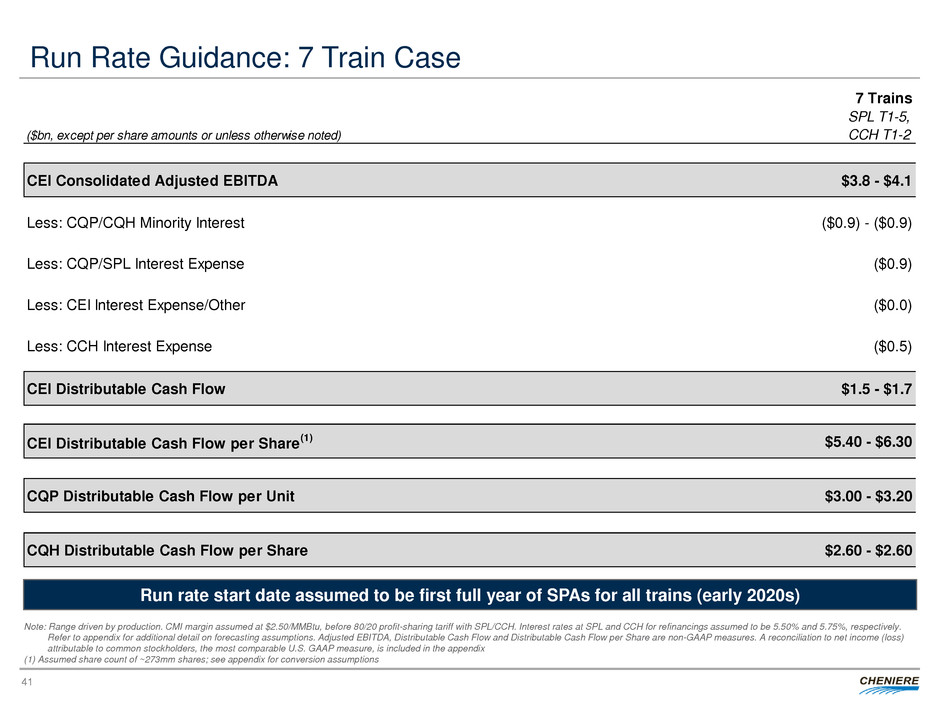
7 Trains
($bn, except per share amounts or unless otherwise noted)
SPL T1-5,
CCH T1-2
CEI Consolidated Adjusted EBITDA $3.8 - $4.1
Less: CQP/CQH Minority Interest ($0.9) - ($0.9)
Less: CQP/SPL Interest Expense ($0.9)
Less: CEI Interest Expense/Other ($0.0)
Less: CCH Interest Expense ($0.5)
CEI Distributable Cash Flow $1.5 - $1.7
CEI Distributable Cash Flow per Share(1) $5.40 - $6.30
CQP Distributable Cash Flow per Unit $3.00 - $3.20
CQH Distributable Cash Flow per Share $2.60 - $2.60
Run Rate Guidance: 7 Train Case
41
Run rate start date assumed to be first full year of SPAs for all trains (early 2020s)
Note: Range driven by production. CMI margin assumed at $2.50/MMBtu, before 80/20 profit-sharing tariff with SPL/CCH. Interest rates at SPL and CCH for refinancings assumed to be 5.50% and 5.75%, respectively.
Refer to appendix for additional detail on forecasting assumptions. Adjusted EBITDA, Distributable Cash Flow and Distributable Cash Flow per Share are non-GAAP measures. A reconciliation to net income (loss)
attributable to common stockholders, the most comparable U.S. GAAP measure, is included in the appendix
(1) Assumed share count of ~273mm shares; see appendix for conversion assumptions
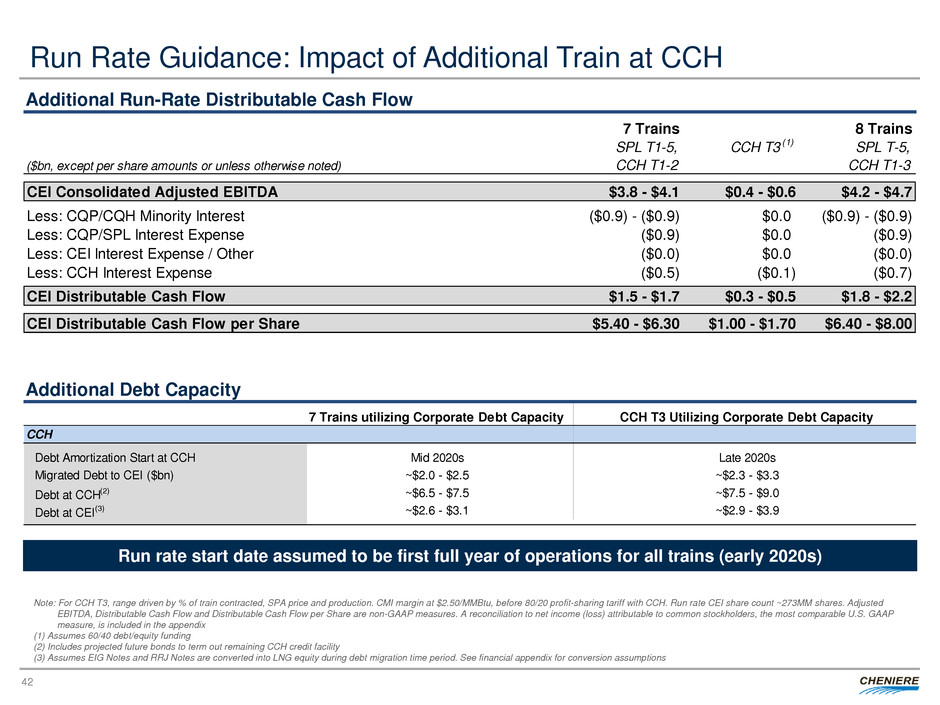
7 Trains utilizing Corporate Debt Capacity CCH T3 Utilizing Corporate Debt Capacity
CCH
Debt Amortization Start at CCH Mid 2020s Late 2020s
Migrated Debt to CEI ($bn) ~$2.0 - $2.5 ~$2.3 - $3.3
Debt at CCH(2) ~$6.5 - $7.5 ~$7.5 - $9.0
Debt at CEI(3) ~$2.6 - $3.1 ~$2.9 - $3.9
7 Trains 8 Trains
($bn, except per share amounts or unless otherwise noted)
SPL T1-5,
CCH T1-2
SPL T-5,
CCH T1-3
CEI Consolidated Adjusted EBITDA $3.8 - $4.1 $0.4 - $0.6 $4.2 - $4.7
Less: CQP/CQH Minority Interest ($0.9) - ($0.9) $0.0 ($0.9) - ($0.9)
Less: CQP/SPL Interest Expense ($0.9) $0.0 ($0.9)
Less: CEI Interest Expense / Other ($0.0) $0.0 ($0.0)
Less: CCH Interest Expense ($0.5) ($0.1) ($0.7)
CEI Distributable Cash Flow $1.5 - $1.7 $0.3 - $0.5 $1.8 - $2.2
CEI Distributable Cash Flow per Share $5.40 - $6.30 $1.00 - $1.70 $6.40 - $8.00
CCH T3 (1)
Run Rate Guidance: Impact of Additional Train at CCH
42
Additional Run-Rate Distributable Cash Flow
Run rate start date assumed to be first full year of operations for all trains (early 2020s)
Additional Debt Capacity
Note: For CCH T3, range driven by % of train contracted, SPA price and production. CMI margin at $2.50/MMBtu, before 80/20 profit-sharing tariff with CCH. Run rate CEI share count ~273MM shares. Adjusted
EBITDA, Distributable Cash Flow and Distributable Cash Flow per Share are non-GAAP measures. A reconciliation to net income (loss) attributable to common stockholders, the most comparable U.S. GAAP
measure, is included in the appendix
(1) Assumes 60/40 debt/equity funding
(2) Includes projected future bonds to term out remaining CCH credit facility
(3) Assumes EIG Notes and RRJ Notes are converted into LNG equity during debt migration time period. See financial appendix for conversion assumptions

CQP Distribution Philosophy
43
CQP Class B units expected to convert and receive the Q3 distribution since Train 3
Substantial Completion has occurred
SPL and CQP to retain cash to ensure adequate SPL project funding and debt service
during construction (~$2.5bn of cash required to complete 5 train project)
Increase in expected distribution within next 12 months, then plan to hold steady until run-
rate period
Pre-Completion of SPL T1-5
Contracted cash flows: target distribution coverage of approximately 1.0x
CMI margins: will vary over time, target distribution coverage greater than 1.0x to steadily
smooth out distributions
CQP will aim to achieve a run-rate steady distribution in the early 2020s
May retain cash to fund additional SPL growth
Post-Completion of SPL T1-5
CQP to maintain robust coverage of SPL project costs, debt service and CMI margins
while facilitating ultimate goal of returning cash to unitholders
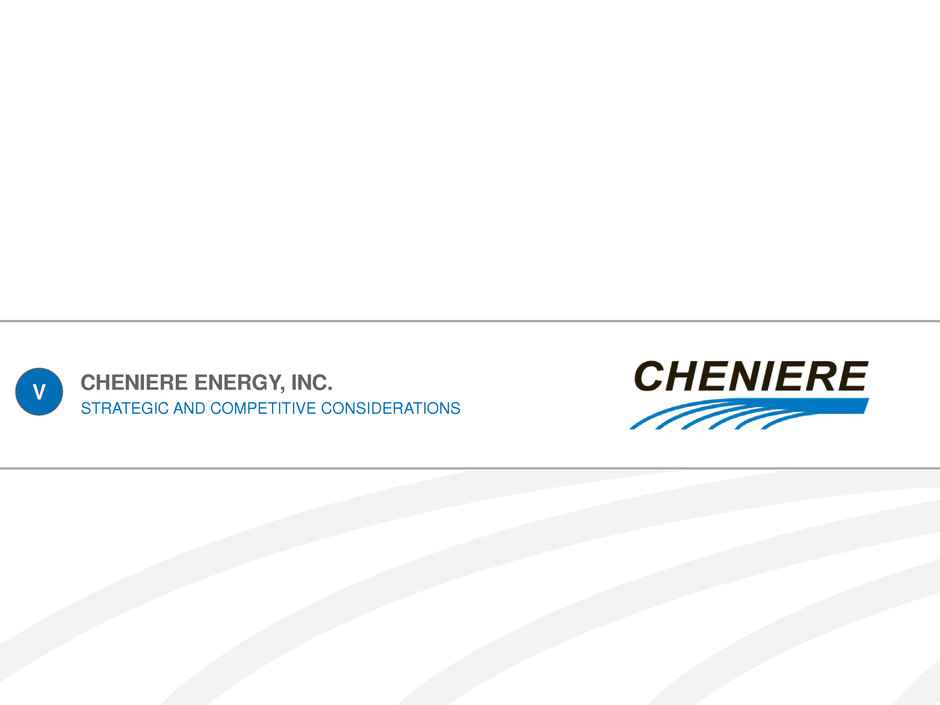
CHENIERE ENERGY, INC.
STRATEGIC AND COMPETITIVE CONSIDERATIONS
V
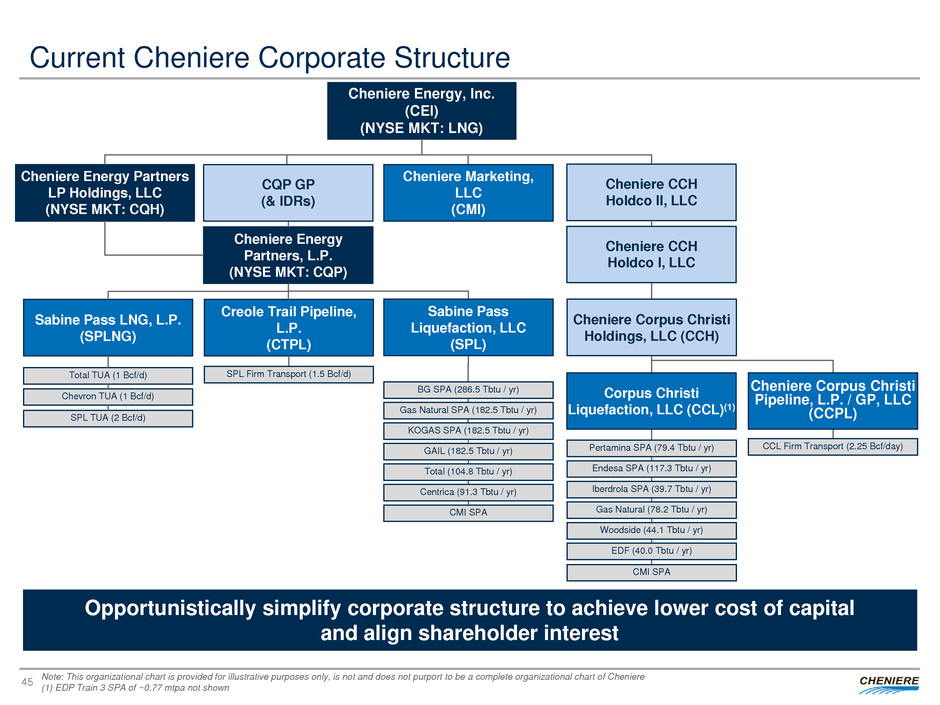
Current Cheniere Corporate Structure
45
Cheniere Energy, Inc.
(CEI)
(NYSE MKT: LNG)
Cheniere Energy
Partners, L.P.
(NYSE MKT: CQP)
Sabine Pass LNG, L.P.
(SPLNG)
Total TUA (1 Bcf/d)
Chevron TUA (1 Bcf/d)
SPL TUA (2 Bcf/d)
Sabine Pass
Liquefaction, LLC
(SPL)
Creole Trail Pipeline,
L.P.
(CTPL)
Cheniere Energy Partners
LP Holdings, LLC
(NYSE MKT: CQH)
Cheniere CCH
Holdco II, LLC
SPL Firm Transport (1.5 Bcf/d)
BG SPA (286.5 Tbtu / yr)
Gas Natural SPA (182.5 Tbtu / yr)
KOGAS SPA (182.5 Tbtu / yr)
GAIL (182.5 Tbtu / yr)
Total (104.8 Tbtu / yr)
Centrica (91.3 Tbtu / yr)
CMI SPA
Pertamina SPA (79.4 Tbtu / yr)
Endesa SPA (117.3 Tbtu / yr)
Iberdrola SPA (39.7 Tbtu / yr)
Gas Natural (78.2 Tbtu / yr)
Woodside (44.1 Tbtu / yr)
EDF (40.0 Tbtu / yr)
CMI SPA
Cheniere CCH
Holdco I, LLC
Corpus Christi
Liquefaction, LLC (CCL)(1)
Cheniere Corpus Christi
Holdings, LLC (CCH)
CCL Firm Transport (2.25 Bcf/day)
Cheniere Corpus Christi
Pipeline, L.P. / GP, LLC
(CCPL)
CQP GP
(& IDRs)
Cheniere Marketing,
LLC
(CMI)
Opportunistically simplify corporate structure to achieve lower cost of capital
and align shareholder interest
Note: This organizational chart is provided for illustrative purposes only, is not and does not purport to be a complete organizational chart of Cheniere
(1) EDP Train 3 SPA of ~0.77 mtpa not shown

New LNG Investment Considerations
46
Fundamentals that have evolved for Cheniere
Strong cash flows from first trains and corporate debt capacity enable flexibility
• Portfolio management with contract ladder versus long-term only
• Attractive foundation contracts with investment grade counterparties allow for initially higher
leverage levels
High performance levels and focus on first quartile operating performance allow CMI the
ability to optimize excess capacity
• Train FID conditions precedent not necessary for new firm contracts
• Marketing arm has flexibility to sell short, medium or long-term deals either FOB or DES
Investment parameters going forward
Investment grade at the asset level is important
Targeting a benefit to cost ratio of 1 within 10 years for discretionary capital investment on
a contractual basis
Assume conservative contracting levels for unsold capacity at FID to meet cost of capital
Retain flexibility to firm up / re-contract unsold capacity opportunistically to exceed cost of
capital
Target no more than ~20% and no less than ~5% of portfolio excess LNG capacity remains
open
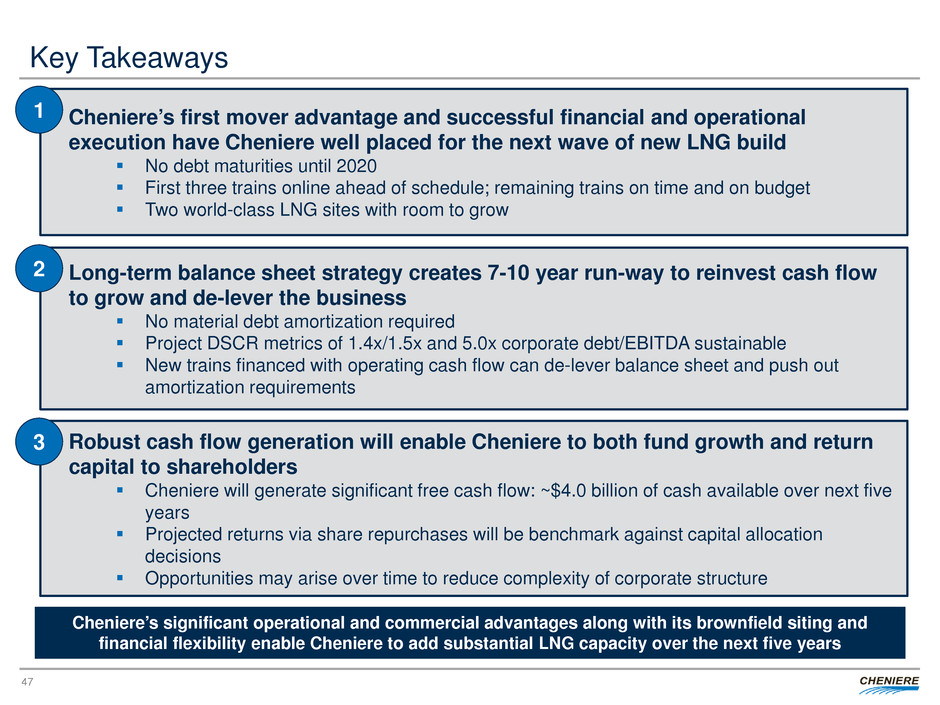
Key Takeaways
47
Cheniere’s first mover advantage and successful financial and operational
execution have Cheniere well placed for the next wave of new LNG build
No debt maturities until 2020
First three trains online ahead of schedule; remaining trains on time and on budget
Two world-class LNG sites with room to grow
1
Long-term balance sheet strategy creates 7-10 year run-way to reinvest cash flow
to grow and de-lever the business
No material debt amortization required
Project DSCR metrics of 1.4x/1.5x and 5.0x corporate debt/EBITDA sustainable
New trains financed with operating cash flow can de-lever balance sheet and push out
amortization requirements
2
Robust cash flow generation will enable Cheniere to both fund growth and return
capital to shareholders
Cheniere will generate significant free cash flow: ~$4.0 billion of cash available over next five
years
Projected returns via share repurchases will be benchmark against capital allocation
decisions
Opportunities may arise over time to reduce complexity of corporate structure
3
Cheniere’s significant operational and commercial advantages along with its brownfield siting and
financial flexibility enable Cheniere to add substantial LNG capacity over the next five years
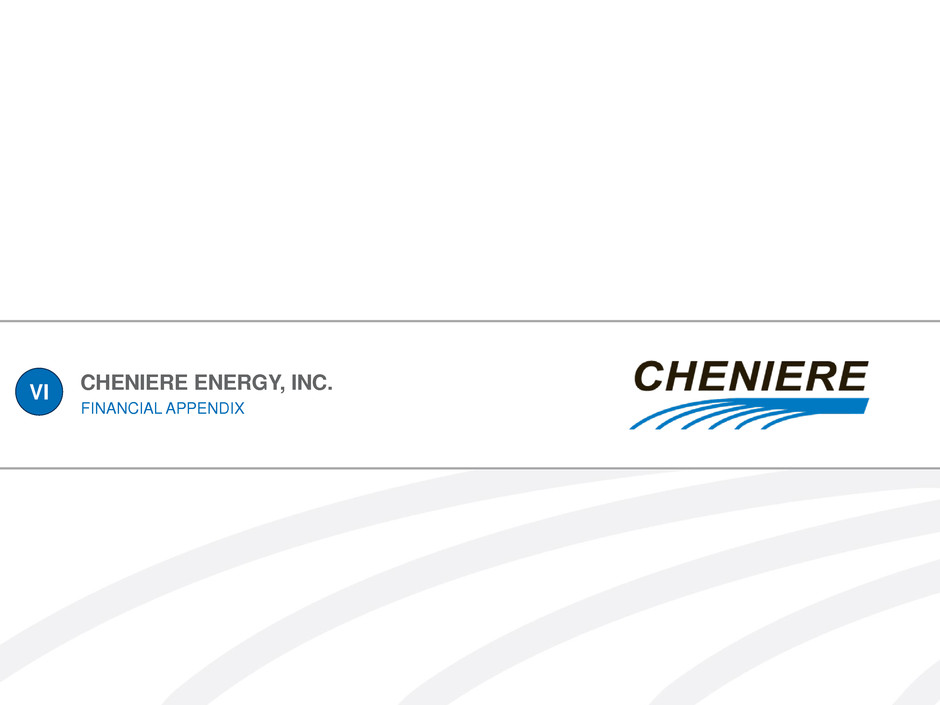
CHENIERE ENERGY, INC.
FINANCIAL APPENDIX
VI

Forecasting Points
49
EIG Notes Conversion
CCH Holdco II Notes (EIG Notes) convert into ~20mm LNG shares in 2020 at estimated $94 / share
(ultimate principal balance of ~$1.7bn)
• Conversion at a 10% discount to LNG’s share price
• Only 50% of the EIG Notes can be converted at initial conversion and subsequent conversions cannot occur for 90
days after conversion date
RRJ Notes Conversion
CEI Convertible Unsecured Notes (RRJ Notes) convert into ~15mm LNG shares in 2020 at estimated $94 /
share (ultimate principal balance of ~$1.4bn)
Class B Conversion
CQP Class B units owned by Blackstone convert to ~200mm common units in Q3 2017
CQP Class B units owned by CEI/CQH convert to ~90mm common units in Q3 2017
As of December 31, 2016, CEI’s and CQH’s federal NOL carryforwards are equal to $3.8 billion and $1.7
billion, respectively
CQH tax sharing payments to CEI occur prior to CEI-level taxes
• CQH’s NOL will be exhausted before CEI’s NOL which causes incremental free cash flow to CEI
General Assumptions
CEI Cash Tax Payments Begin Late 2020s
CQH Tax Sharing Payments Begin Early 2020s
2020 - 2040 Tax Rate Percentage of Pre-Tax Cash Flow
CEI High Teens
CQH Mid 20%s
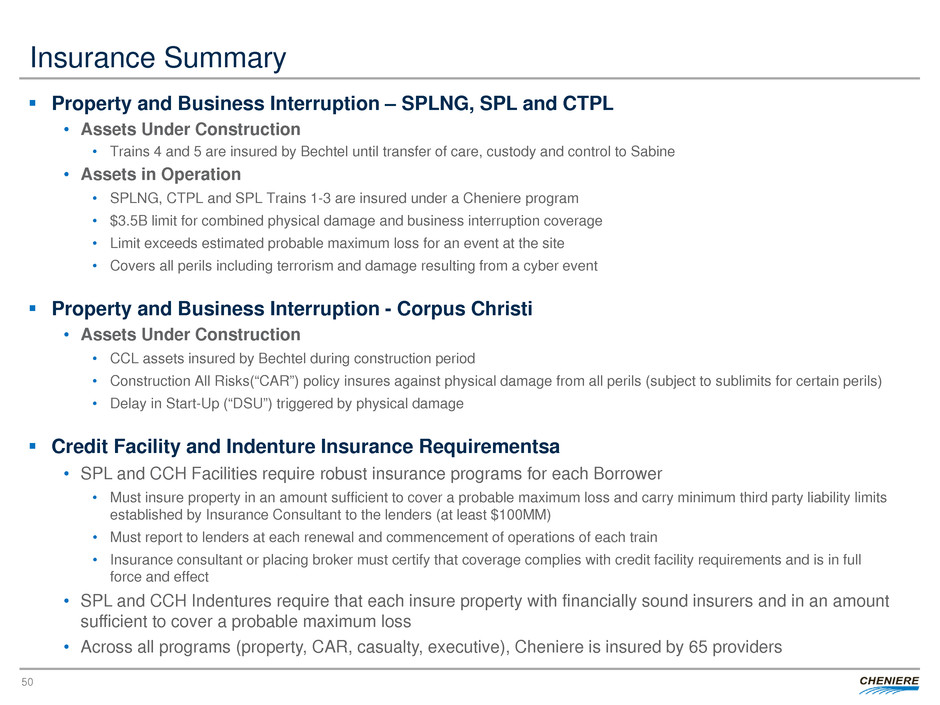
Insurance Summary
50
Property and Business Interruption – SPLNG, SPL and CTPL
• Assets Under Construction
• Trains 4 and 5 are insured by Bechtel until transfer of care, custody and control to Sabine
• Assets in Operation
• SPLNG, CTPL and SPL Trains 1-3 are insured under a Cheniere program
• $3.5B limit for combined physical damage and business interruption coverage
• Limit exceeds estimated probable maximum loss for an event at the site
• Covers all perils including terrorism and damage resulting from a cyber event
Property and Business Interruption - Corpus Christi
• Assets Under Construction
• CCL assets insured by Bechtel during construction period
• Construction All Risks(“CAR”) policy insures against physical damage from all perils (subject to sublimits for certain perils)
• Delay in Start-Up (“DSU”) triggered by physical damage
Credit Facility and Indenture Insurance Requirementsa
• SPL and CCH Facilities require robust insurance programs for each Borrower
• Must insure property in an amount sufficient to cover a probable maximum loss and carry minimum third party liability limits
established by Insurance Consultant to the lenders (at least $100MM)
• Must report to lenders at each renewal and commencement of operations of each train
• Insurance consultant or placing broker must certify that coverage complies with credit facility requirements and is in full
force and effect
• SPL and CCH Indentures require that each insure property with financially sound insurers and in an amount
sufficient to cover a probable maximum loss
• Across all programs (property, CAR, casualty, executive), Cheniere is insured by 65 providers
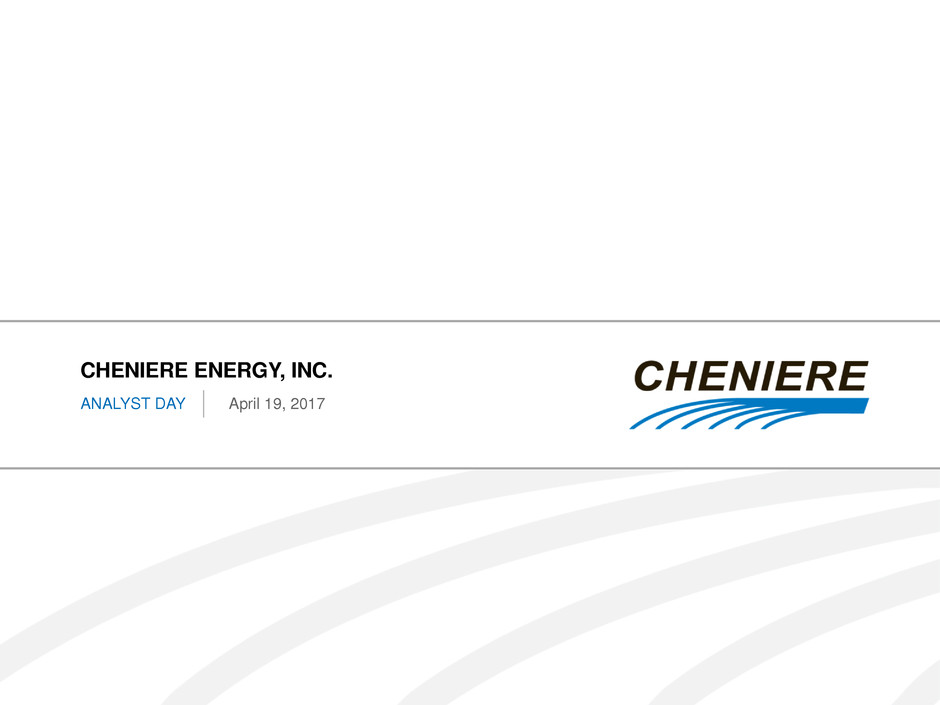
CHENIERE ENERGY, INC.
April 19, 2017 ANALYST DAY
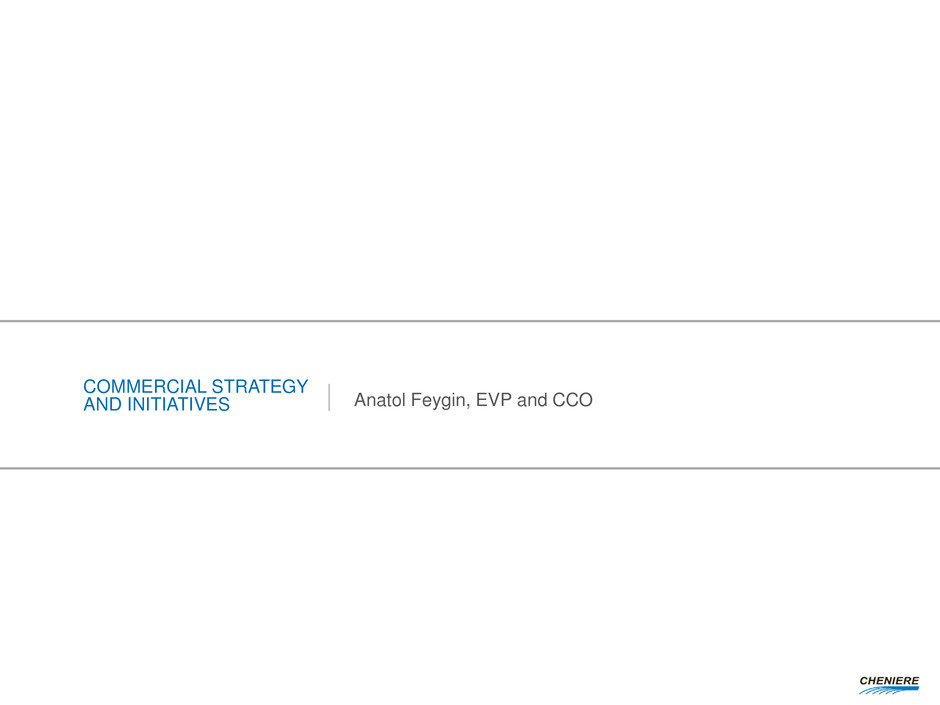
COMMERCIAL STRATEGY
AND INITIATIVES Anatol Feygin, EVP and CCO
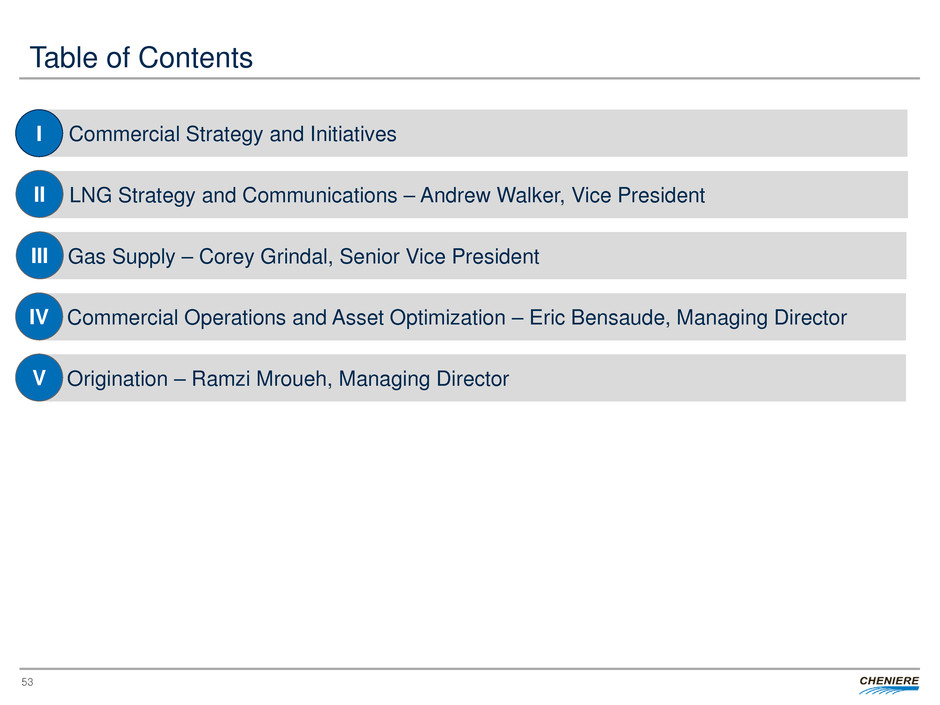
Table of Contents
53
Commercial Strategy and Initiatives I
LNG Strategy and Communications – Andrew Walker, Vice President II
Gas Supply – Corey Grindal, Senior Vice President III
Commercial Operations and Asset Optimization – Eric Bensaude, Managing Director IV
Origination – Ramzi Mroueh, Managing Director V
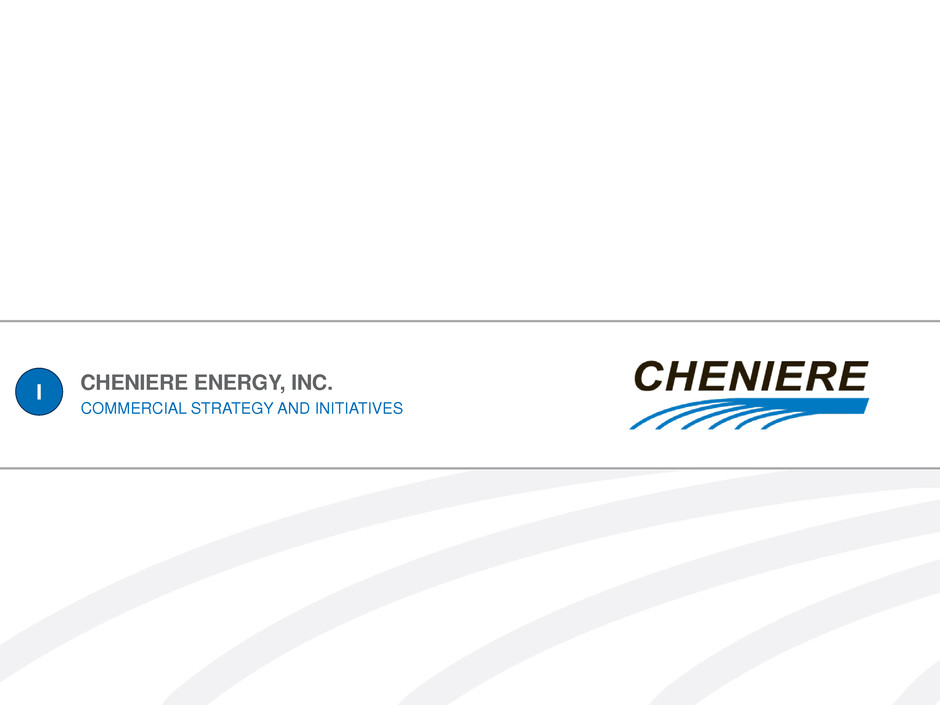
CHENIERE ENERGY, INC.
COMMERCIAL STRATEGY AND INITIATIVES
I
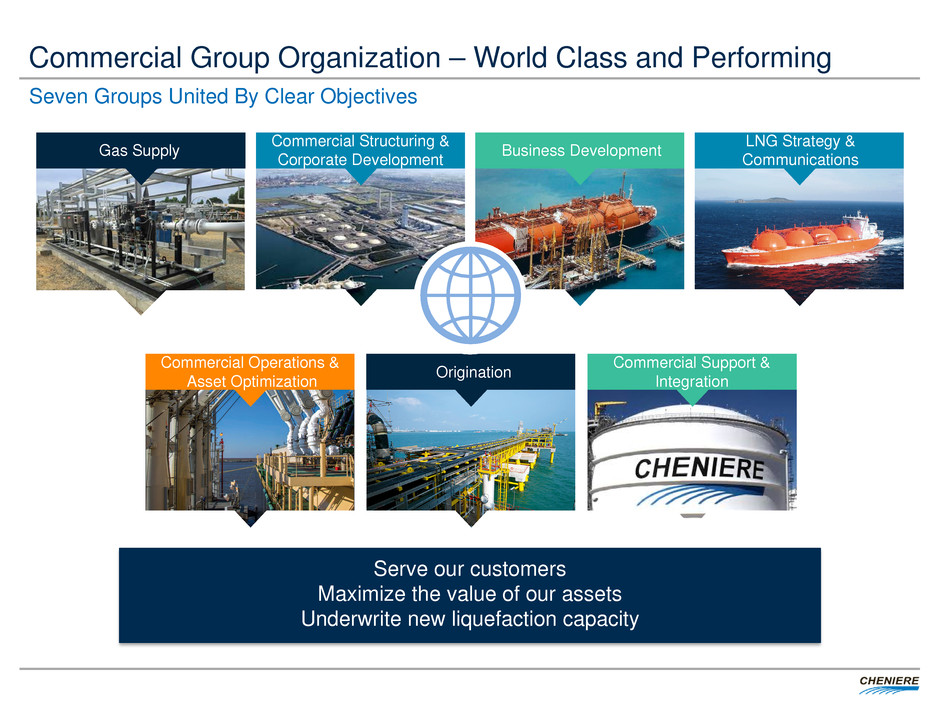
Commercial Group Organization – World Class and Performing
Seven Groups United By Clear Objectives
Serve our customers
Maximize the value of our assets
Underwrite new liquefaction capacity
Gas Supply Commercial Structuring & Corporate Development
Commercial Support &
Integration
Commercial Operations &
Asset Optimization Origination
LNG Strategy &
Communications Business Development
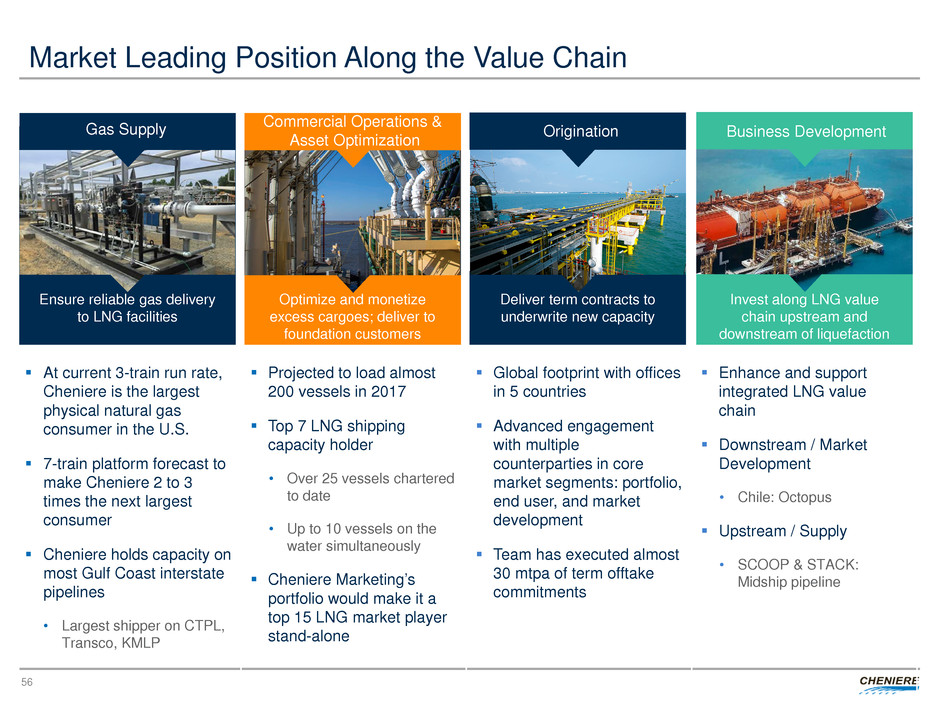
At current 3-train run rate,
Cheniere is the largest
physical natural gas
consumer in the U.S.
7-train platform forecast to
make Cheniere 2 to 3
times the next largest
consumer
Cheniere holds capacity on
most Gulf Coast interstate
pipelines
• Largest shipper on CTPL,
Transco, KMLP
Projected to load almost
200 vessels in 2017
Top 7 LNG shipping
capacity holder
• Over 25 vessels chartered
to date
• Up to 10 vessels on the
water simultaneously
Cheniere Marketing’s
portfolio would make it a
top 15 LNG market player
stand-alone
Global footprint with offices
in 5 countries
Advanced engagement
with multiple
counterparties in core
market segments: portfolio,
end user, and market
development
Team has executed almost
30 mtpa of term offtake
commitments
Enhance and support
integrated LNG value
chain
Downstream / Market
Development
• Chile: Octopus
Upstream / Supply
• SCOOP & STACK:
Midship pipeline
Market Leading Position Along the Value Chain
56
Gas Supply
Optimize and monetize
excess cargoes; deliver to
foundation customers
Deliver term contracts to
underwrite new capacity
Invest along LNG value
chain upstream and
downstream of liquefaction
Gas Supply
Ensure reliable gas delivery
to LNG facilities
Commercial Operations &
Asset Optimization Origination Business Development

Projected Company Ranking by LNG Sales in 2020
0
10
20
30
40
50
60
m
tp
a
Projected Top LNG Suppliers by Company - 2020
Source: Cheniere Research, Wood Mackenzie
Note: volumes include ‘equity’ LNG, third-party offtake and own project offtake. Tolling facility production reflected in offtaker volumes.
Volumes for Projects Existing and Under Construction
On Track to Be a Top-5 Seller Less Than 5 Years After First Cargo
57

U.S. LNG Expected to be Key in Satisfying Robust Global Gas Growth
58
Source: Cheniere Research, Global Data, World Bank, Wood Mackenzie
Note: Conversion from GW to Bcf/d assumes thermal efficiency of 61%
(1) China plans to grow share of gas to 15% by 2030; India in the next few years
0%
1%
2%
3%
4%
5%
6%
Emerging
Asia
Africa Central Asia MENA Canada &
US
Latam &
Caribbean
Europe Asia
Forecast GDP Growth Levels by Region
2015-2020
2021-2025
Emerging economies
drive global growth and
gas demand
China and India plan to
grow gas share
from 6% to 15% in
energy mix(1)
Creative LNG contracting
structures, competitive
supplies & technology
solutions alleviate risks
and cost burden
0.0
1.3
2.7
4.0
5.4
6.7
8.0
9.4
10.7
-
10
20
30
40
50
60
70
80
2017 2018 2019 2020 2021 2022 2023 2024 2025
B
cf
/d
G
W
Projected Gas-Fired Capacity Additions
by Region 2017-2025
Africa Asia Europe Latam & Caribbean MENA
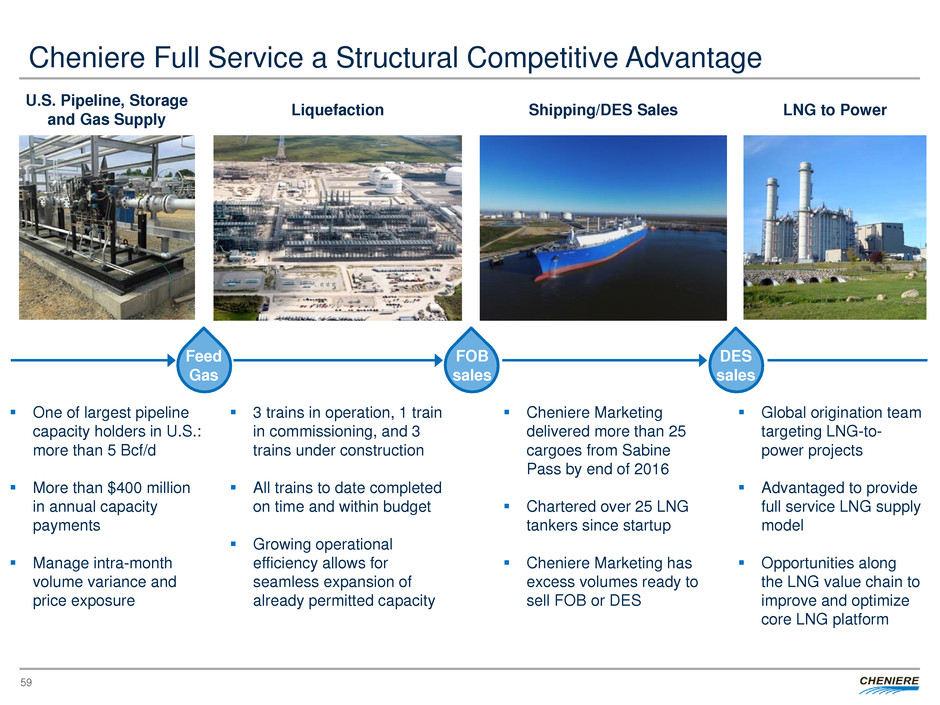
Cheniere Full Service a Structural Competitive Advantage
Liquefaction Shipping/DES Sales LNG to Power U.S. Pipeline, Storage and Gas Supply
One of largest pipeline
capacity holders in U.S.:
more than 5 Bcf/d
More than $400 million
in annual capacity
payments
Manage intra-month
volume variance and
price exposure
3 trains in operation, 1 train
in commissioning, and 3
trains under construction
All trains to date completed
on time and within budget
Growing operational
efficiency allows for
seamless expansion of
already permitted capacity
Cheniere Marketing
delivered more than 25
cargoes from Sabine
Pass by end of 2016
Chartered over 25 LNG
tankers since startup
Cheniere Marketing has
excess volumes ready to
sell FOB or DES
Global origination team
targeting LNG-to-
power projects
Advantaged to provide
full service LNG supply
model
Opportunities along
the LNG value chain to
improve and optimize
core LNG platform
Feed
Gas
FOB
sales
DES
sales
59
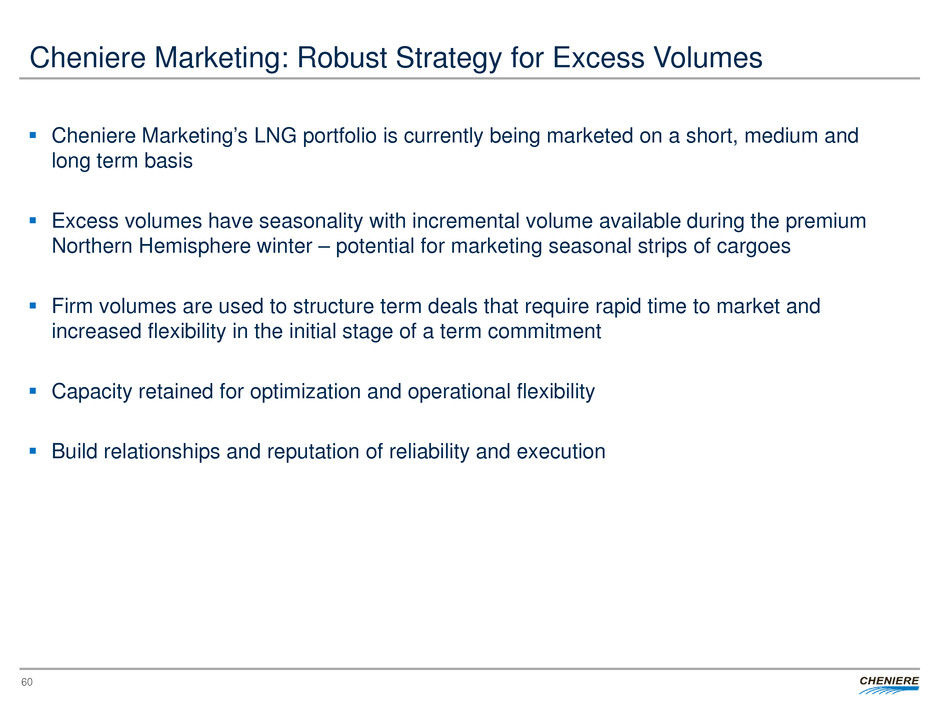
Cheniere Marketing’s LNG portfolio is currently being marketed on a short, medium and
long term basis
Excess volumes have seasonality with incremental volume available during the premium
Northern Hemisphere winter – potential for marketing seasonal strips of cargoes
Firm volumes are used to structure term deals that require rapid time to market and
increased flexibility in the initial stage of a term commitment
Capacity retained for optimization and operational flexibility
Build relationships and reputation of reliability and execution
Cheniere Marketing: Robust Strategy for Excess Volumes
60
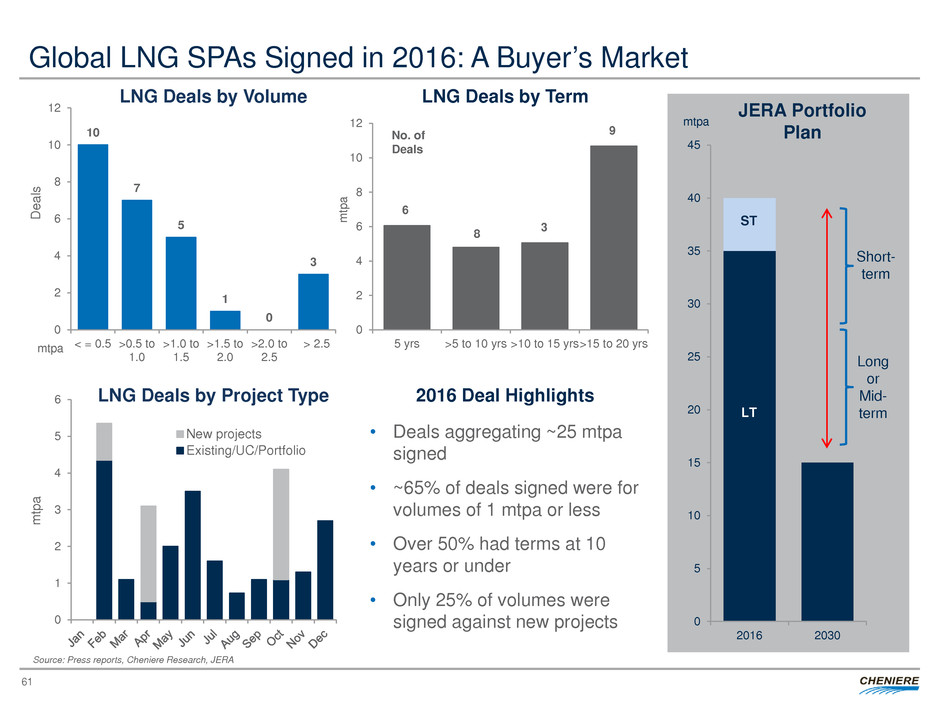
Global LNG SPAs Signed in 2016: A Buyer’s Market
61
0
1
2
3
4
5
6
m
tp
a
New projects
Existing/UC/Portfolio
10
7
5
1
0
3
0
2
4
6
8
10
12
< = 0.5 >0.5 to
1.0
>1.0 to
1.5
>1.5 to
2.0
>2.0 to
2.5
> 2.5
D
ea
ls
mtpa
0
2
4
6
8
10
12
5 yrs >5 to 10 yrs >10 to 15 yrs>15 to 20 yrs
m
tp
a
LNG Deals by Volume LNG Deals by Term
LNG Deals by Project Type
• Deals aggregating ~25 mtpa
signed
• ~65% of deals signed were for
volumes of 1 mtpa or less
• Over 50% had terms at 10
years or under
• Only 25% of volumes were
signed against new projects
2016 Deal Highlights
0
5
10
15
20
25
30
35
40
45
2016 2030
Short-
term
Long
or
Mid-
term
JERA Portfolio
Plan
Source: Press reports, Cheniere Research, JERA
No. of
Deals
6
8 3
9
ST
LT
mtpa
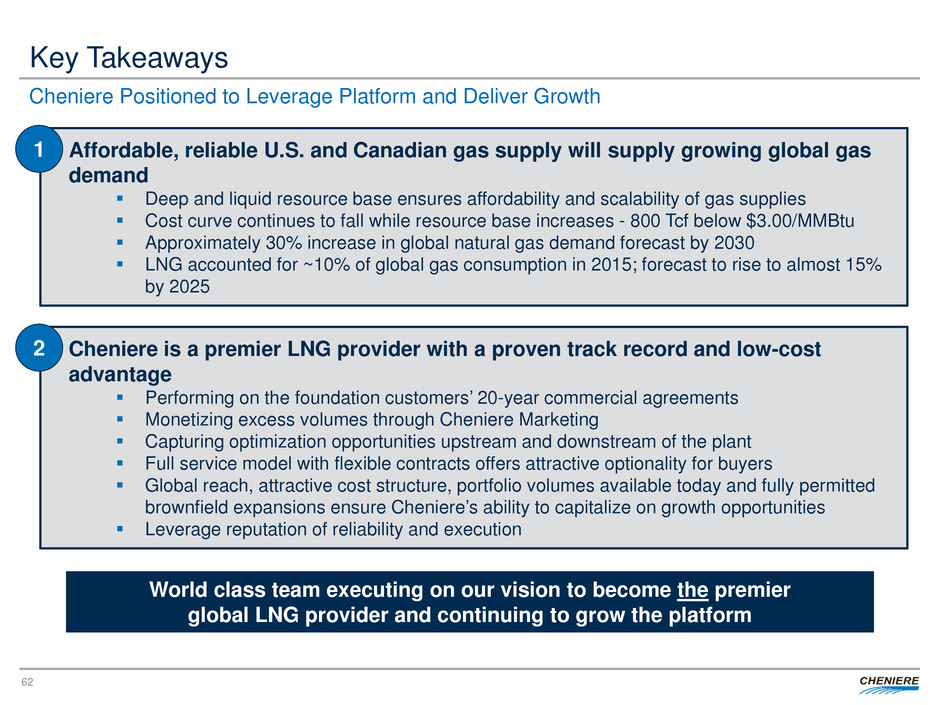
Key Takeaways
62
Affordable, reliable U.S. and Canadian gas supply will supply growing global gas
demand
Deep and liquid resource base ensures affordability and scalability of gas supplies
Cost curve continues to fall while resource base increases - 800 Tcf below $3.00/MMBtu
Approximately 30% increase in global natural gas demand forecast by 2030
LNG accounted for ~10% of global gas consumption in 2015; forecast to rise to almost 15%
by 2025
1
Cheniere is a premier LNG provider with a proven track record and low-cost
advantage
Performing on the foundation customers’ 20-year commercial agreements
Monetizing excess volumes through Cheniere Marketing
Capturing optimization opportunities upstream and downstream of the plant
Full service model with flexible contracts offers attractive optionality for buyers
Global reach, attractive cost structure, portfolio volumes available today and fully permitted
brownfield expansions ensure Cheniere’s ability to capitalize on growth opportunities
Leverage reputation of reliability and execution
2
Cheniere Positioned to Leverage Platform and Deliver Growth
World class team executing on our vision to become the premier
global LNG provider and continuing to grow the platform
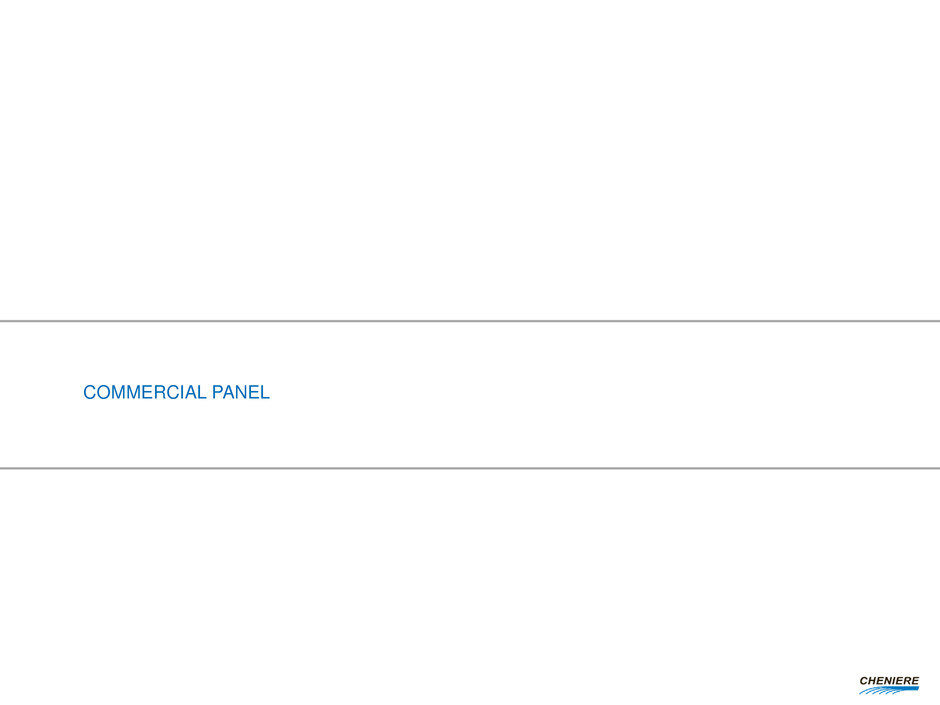
COMMERCIAL PANEL
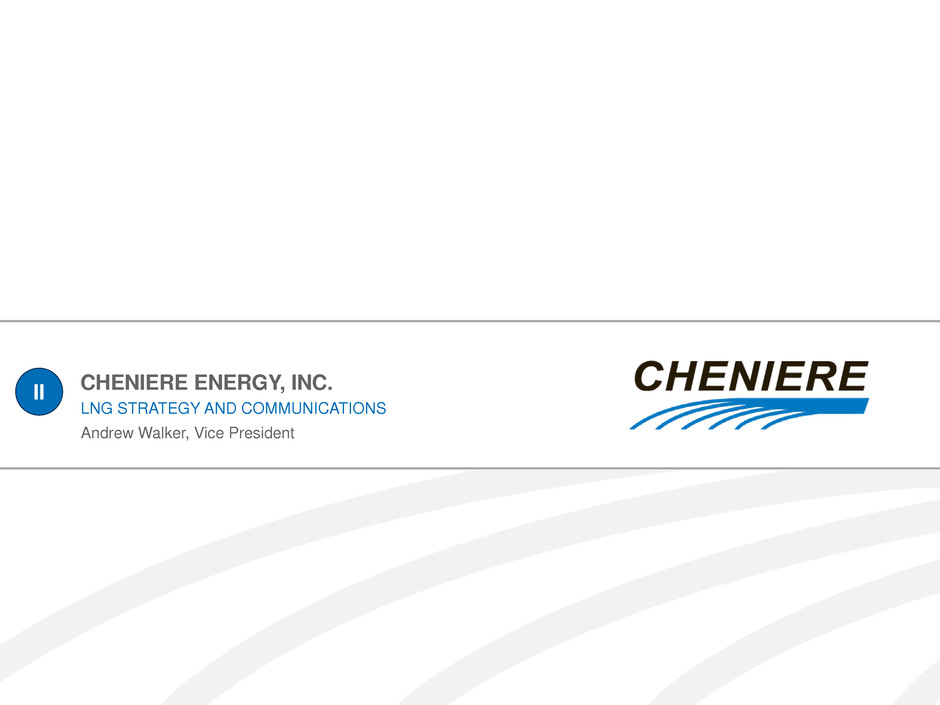
CHENIERE ENERGY, INC.
LNG STRATEGY AND COMMUNICATIONS
II
Andrew Walker, Vice President
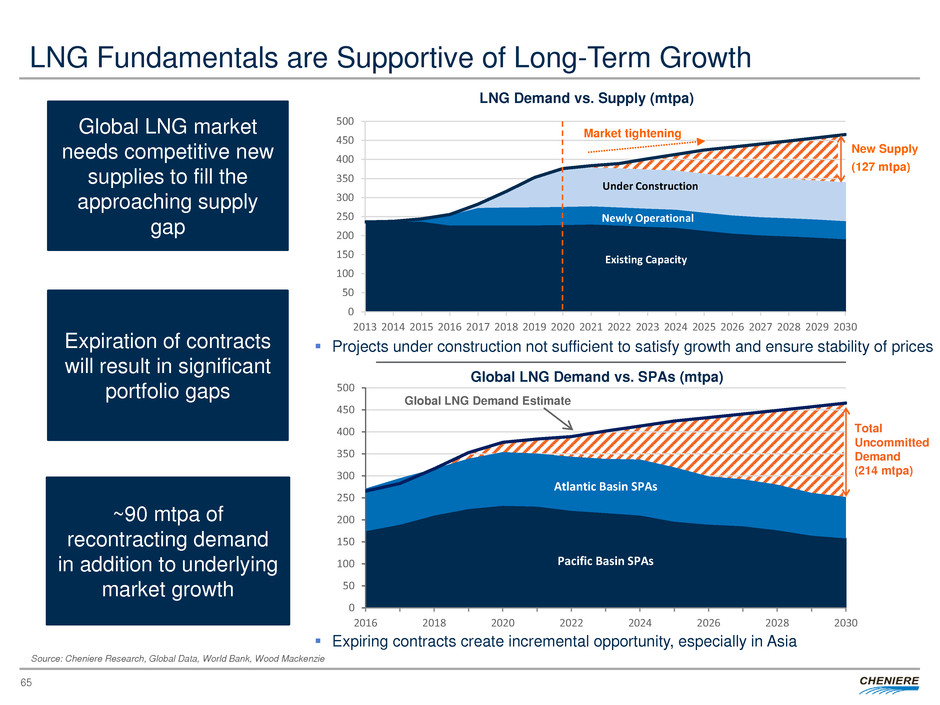
Pacific Basin SPAs
Atlantic Basin SPAs
0
50
100
150
200
250
300
350
400
450
500
2016 2018 2020 2022 2024 2026 2028 2030
Global LNG Demand vs. SPAs (mtpa)
Global LNG Demand Estimate
Existing Capacity
Newly Operational
Under Construction
0
50
100
150
200
250
300
350
400
450
500
2013 2014 2015 2016 2017 2018 2019 2020 2021 2022 2023 2024 2025 2026 2027 2028 2029 2030
LNG Demand vs. Supply (mtpa)
Market tightening
New Supply
(127 mtpa)
65
Source: Cheniere Research, Global Data, World Bank, Wood Mackenzie
Global LNG market
needs competitive new
supplies to fill the
approaching supply
gap
Expiration of contracts
will result in significant
portfolio gaps
~90 mtpa of
recontracting demand
in addition to underlying
market growth
LNG Fundamentals are Supportive of Long-Term Growth
Projects under construction not sufficient to satisfy growth and ensure stability of prices
Expiring contracts create incremental opportunity, especially in Asia
Total
Uncommitted
Demand
(214 mtpa)
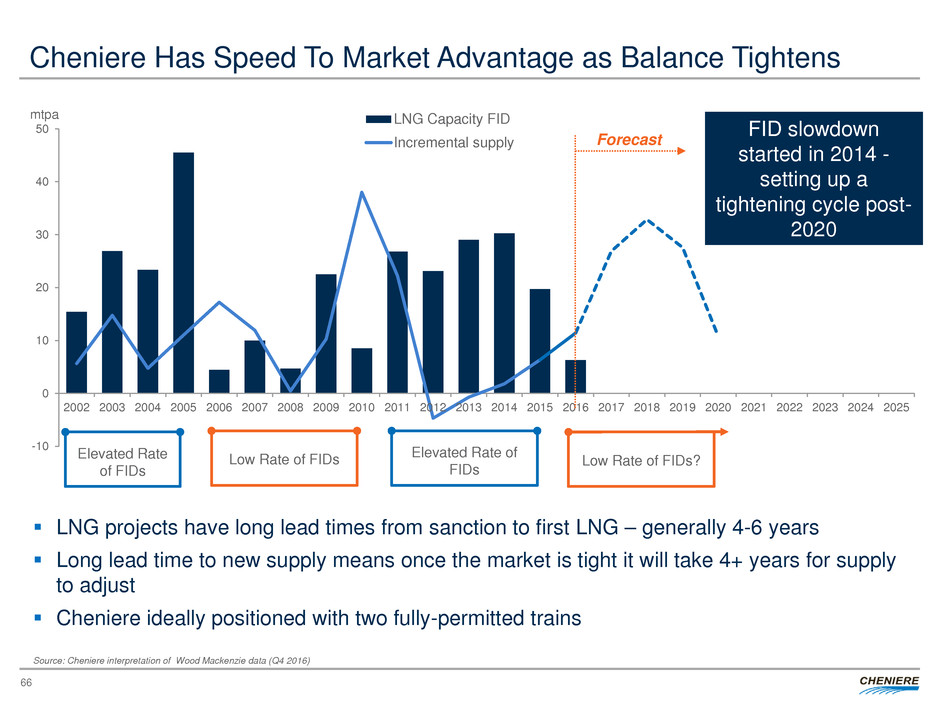
-10
0
10
20
30
40
50
2002 2003 2004 2005 2006 2007 2008 2009 2010 2011 2012 2013 2014 2015 2016 2017 2018 2019 2020 2021 2022 2023 2024 2025
mtpa LNG Capacity FID
Incremental supply Forecast
Source: Cheniere interpretation of Wood Mackenzie data (Q4 2016)
LNG projects have long lead times from sanction to first LNG – generally 4-6 years
Long lead time to new supply means once the market is tight it will take 4+ years for supply
to adjust
Cheniere ideally positioned with two fully-permitted trains
Elevated Rate of
FIDs
Low Rate of FIDs Low Rate of FIDs? Elevated Rate
of FIDs
FID slowdown
started in 2014 -
setting up a
tightening cycle post-
2020
66
Cheniere Has Speed To Market Advantage as Balance Tightens
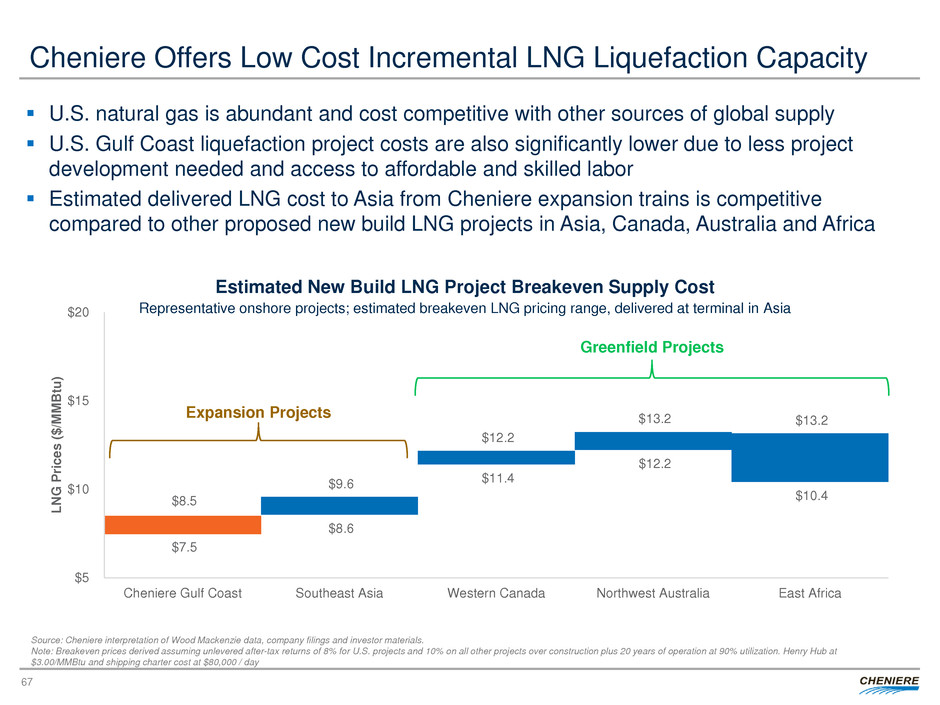
$7.5
$8.6
$11.4
$12.2
$10.4 $8.5
$9.6
$12.2
$13.2 $13.2
$5
$10
$15
$20
Cheniere Gulf Coast Southeast Asia Western Canada Northwest Australia East Africa
LN
G
P
ri
ce
s
($
/M
M
B
tu
)
67
U.S. natural gas is abundant and cost competitive with other sources of global supply
U.S. Gulf Coast liquefaction project costs are also significantly lower due to less project
development needed and access to affordable and skilled labor
Estimated delivered LNG cost to Asia from Cheniere expansion trains is competitive
compared to other proposed new build LNG projects in Asia, Canada, Australia and Africa
Representative onshore projects; estimated breakeven LNG pricing range, delivered at terminal in Asia
Source: Cheniere interpretation of Wood Mackenzie data, company filings and investor materials.
Note: Breakeven prices derived assuming unlevered after-tax returns of 8% for U.S. projects and 10% on all other projects over construction plus 20 years of operation at 90% utilization. Henry Hub at
$3.00/MMBtu and shipping charter cost at $80,000 / day
Cheniere Offers Low Cost Incremental LNG Liquefaction Capacity
Greenfield Projects
Expansion Projects
Estimated New Build LNG Project Breakeven Supply Cost
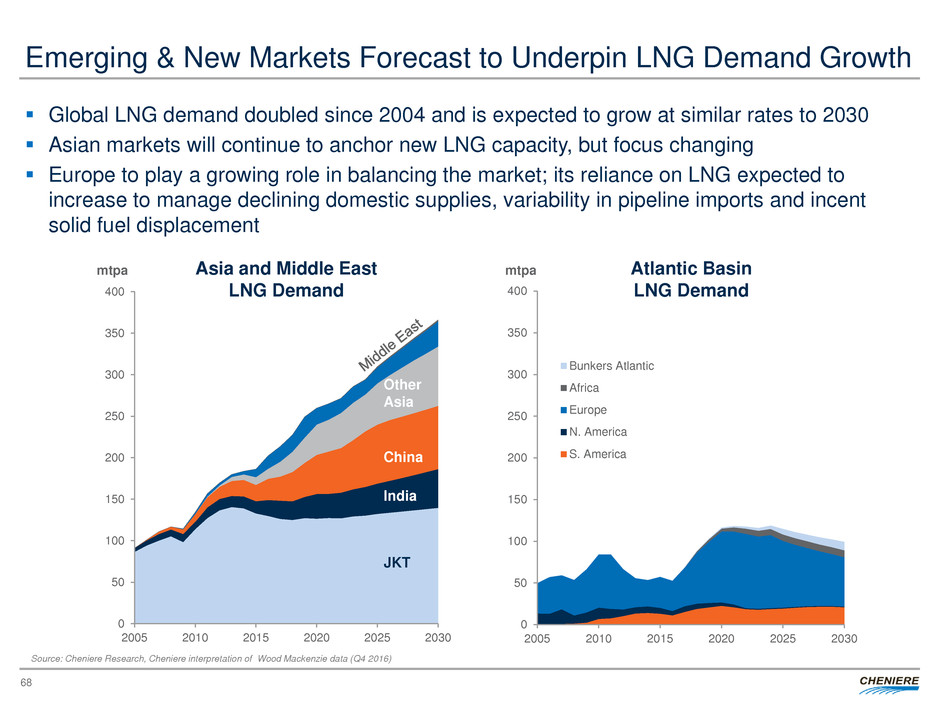
Emerging & New Markets Forecast to Underpin LNG Demand Growth
68
Source: Cheniere Research, Cheniere interpretation of Wood Mackenzie data (Q4 2016)
0
50
100
150
200
250
300
350
400
2005 2010 2015 2020 2025 2030
Bunkers Atlantic
Africa
Europe
N. America
S. America
0
50
100
150
200
250
300
350
400
2005 2010 2015 2020 2025 2030
mtpa
JKT
China
India
Other
Asia
Asia and Middle East
LNG Demand
Atlantic Basin
LNG Demand
mtpa
Global LNG demand doubled since 2004 and is expected to grow at similar rates to 2030
Asian markets will continue to anchor new LNG capacity, but focus changing
Europe to play a growing role in balancing the market; its reliance on LNG expected to
increase to manage declining domestic supplies, variability in pipeline imports and incent
solid fuel displacement
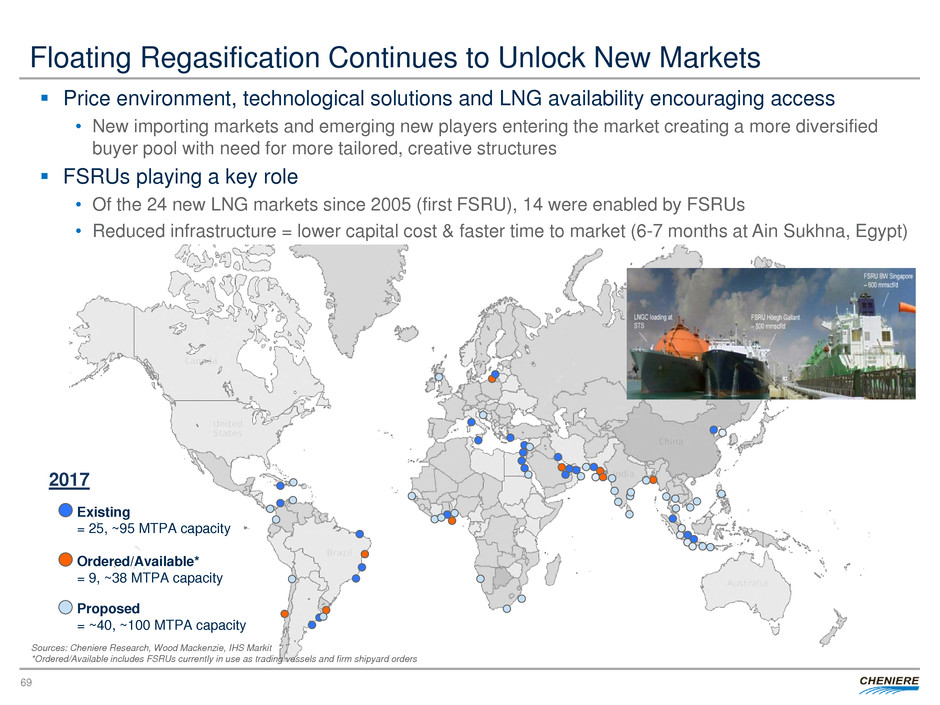
Floating Regasification Continues to Unlock New Markets
69
Existing
= 25, ~95 MTPA capacity
Ordered/Available*
= 9, ~38 MTPA capacity
2017
Proposed
= ~40, ~100 MTPA capacity
Price environment, technological solutions and LNG availability encouraging access
• New importing markets and emerging new players entering the market creating a more diversified
buyer pool with need for more tailored, creative structures
FSRUs playing a key role
• Of the 24 new LNG markets since 2005 (first FSRU), 14 were enabled by FSRUs
• Reduced infrastructure = lower capital cost & faster time to market (6-7 months at Ain Sukhna, Egypt)
Sources: Cheniere Research, Wood Mackenzie, IHS Markit
*Ordered/Available includes FSRUs currently in use as trading vessels and firm shipyard orders
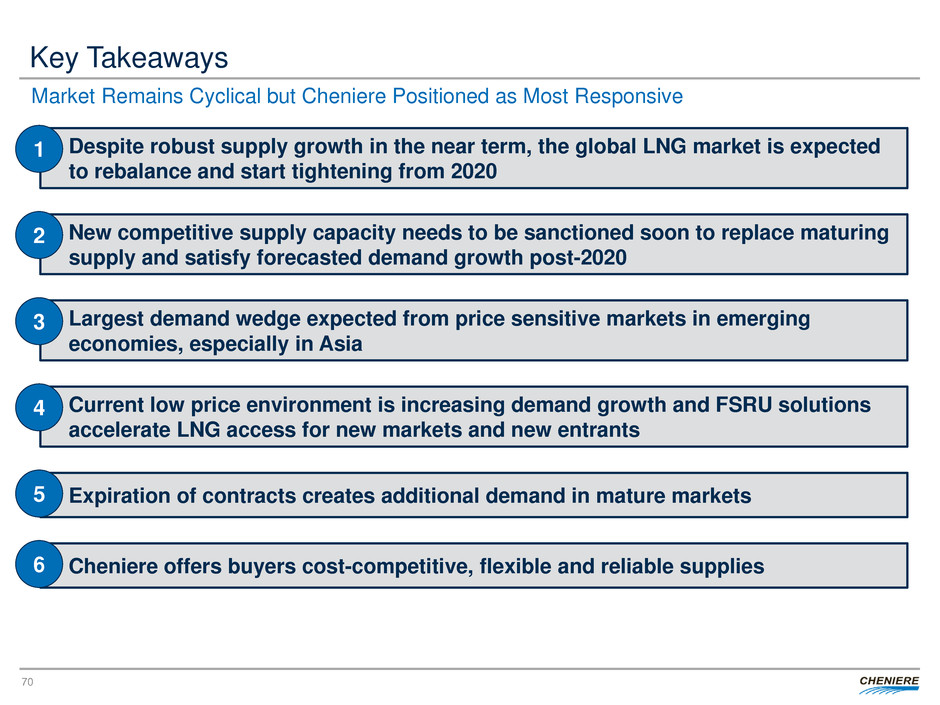
Key Takeaways
70
Despite robust supply growth in the near term, the global LNG market is expected
to rebalance and start tightening from 2020
1
Market Remains Cyclical but Cheniere Positioned as Most Responsive
New competitive supply capacity needs to be sanctioned soon to replace maturing
supply and satisfy forecasted demand growth post-2020
2
Largest demand wedge expected from price sensitive markets in emerging
economies, especially in Asia
3
Current low price environment is increasing demand growth and FSRU solutions
accelerate LNG access for new markets and new entrants
4
Expiration of contracts creates additional demand in mature markets 5
Cheniere offers buyers cost-competitive, flexible and reliable supplies 6
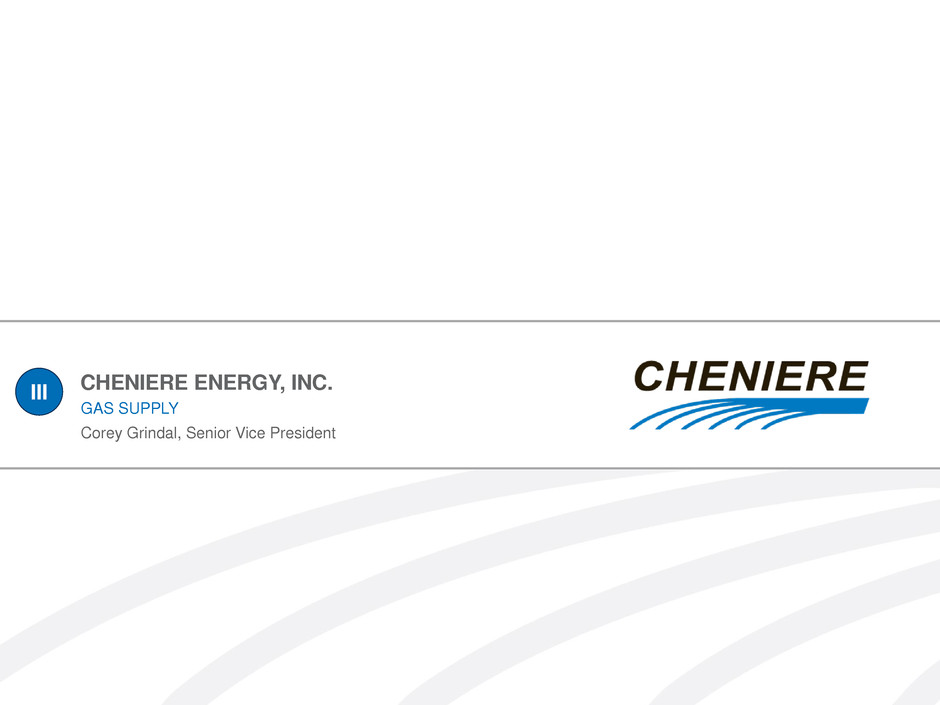
CHENIERE ENERGY, INC.
GAS SUPPLY
III
Corey Grindal, Senior Vice President
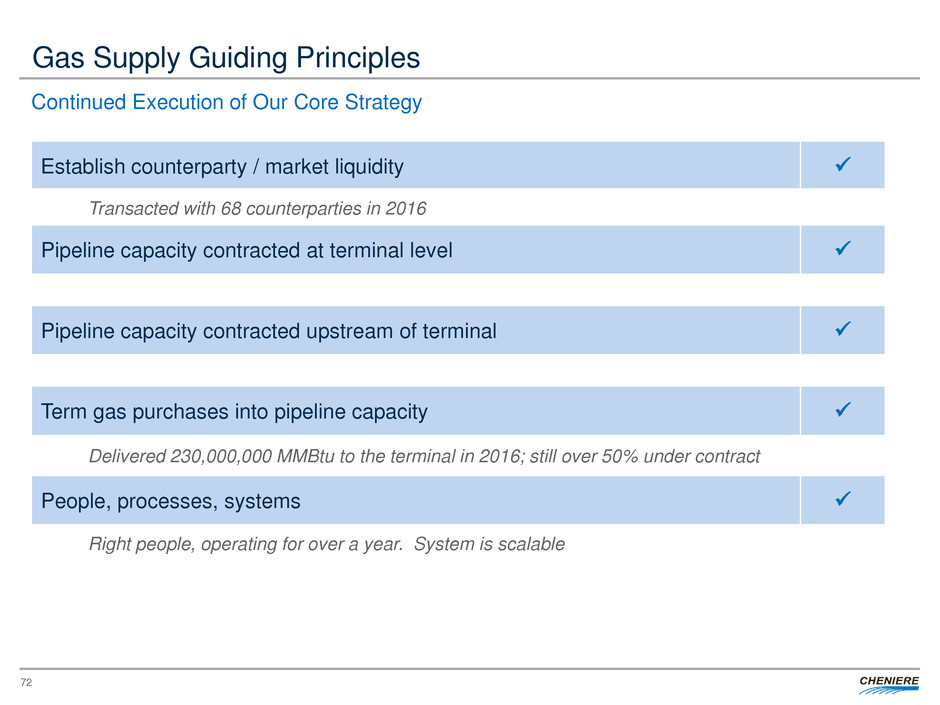
Establish counterparty / market liquidity
Transacted with 68 counterparties in 2016
Pipeline capacity contracted at terminal level
Pipeline capacity contracted upstream of terminal
Term gas purchases into pipeline capacity
Delivered 230,000,000 MMBtu to the terminal in 2016; still over 50% under contract
People, processes, systems
Right people, operating for over a year. System is scalable
Gas Supply Guiding Principles
Continued Execution of Our Core Strategy
72

Sabine Pass Liquefaction Gas Supply
73
Delivered over 300 TBtu to the terminal with 99.9% scheduling efficiency
Outperformed delivered supply cost target of 105% of Henry Hub
Assets in place enable effective management of changing day-to-day plant
consumption related to commercial operations and commissioning; supply volumes have
experienced day-over-day volatility of 200,000+ Dth/day
Storage assets and relationships with infrastructure partners have been key to managing
dynamic volume requirements
Pine Prairie storage deal will ensure that assets are in place to manage growing portfolio
0.0
0.5
1.0
1.5
2.0
2.5
3.0
Jan-16 Apr-16 Jul-16 Oct-16 Jan-17 Apr-17
TB
tu
/d
ay
Pipeline Volumes Delivered to Sabine Pass Liquefaction
CTPL deliveries to SPL NGPL Deliveries to SPL Transco deliveries to SPL

Managing Changing Feed Gas Needs
74
1.6
1.8
2.0
2.2
2.4
Weds Jan 11 Thurs Jan 12 Fri Jan 13 Sat Jan 14 Sun Jan 15
TB
tu
Expected Sabine Pass Feed Gas Requirements for January 15, 2017
Production forecast and daily flows can be highly variable
Adjustments to Production Forecast During Train 3 Commissioning
Actual E&C
Contractor
Estimates

75
Sabine Pass Gas Supply Infrastructure Advantage
Transportation into SPL (TBtu/day)
Pipeline Contracted Capacity
Total
Capacity
CTPL 1.530 1.530
NGPL 0.550 0.750
Transco 1.200 1.500
KMLP 0.600 1.200
Total 3.880 4.980
Diverse and redundant pipeline network has allowed SPL to adapt to changing
market conditions and manage upstream interruptions
SPL has transacted at 36 different locations on 13 different pipelines
SPL has ~25% redundancy on pipeline deliverability to the terminal
Sabine Pass Facility
C
TP
L
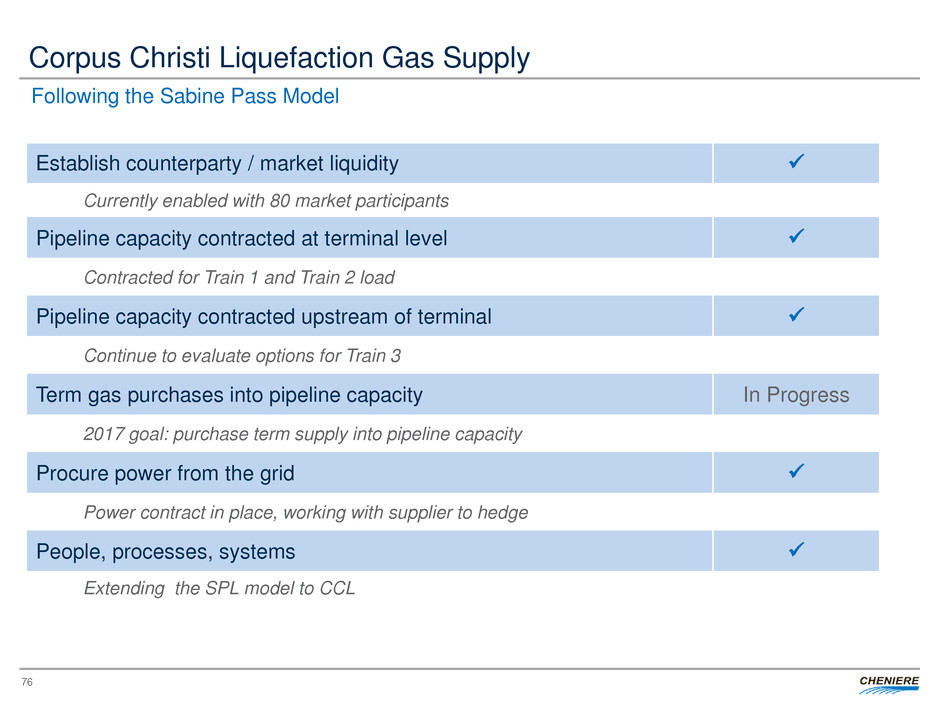
Establish counterparty / market liquidity
Currently enabled with 80 market participants
Pipeline capacity contracted at terminal level
Contracted for Train 1 and Train 2 load
Pipeline capacity contracted upstream of terminal
Continue to evaluate options for Train 3
Term gas purchases into pipeline capacity In Progress
2017 goal: purchase term supply into pipeline capacity
Procure power from the grid
Power contract in place, working with supplier to hedge
People, processes, systems
Extending the SPL model to CCL
Corpus Christi Liquefaction Gas Supply
Following the Sabine Pass Model
76

Corpus Christi Liquefaction Pipeline Infrastructure Secured
Sufficient firm pipeline capacity for Train
1 and Train 2 operations secured
Once CCPL is completed by end of
2017, Gas Supply ready to commission
pipeline and compression needed for
CCL commissioning in 2018
CCL has built out a geographically
diverse infrastructure portfolio that
reaches back to multiple supply sources
Building multiple paths into CCPL
Prepared for execution of additional
commitments when commercialization of
Train 3 is reached
77
NGPL
Tennessee Gas
HPL
KM Tejas
Transco
Potential
Supply Points

Key Takeaways
78
People, systems, and processes are in place to manage supply and logistics
Scalable, difficult to replicate
Management of intra-month price and gas supply volatility requires fully staffed trade floor in-
tune with plant operations
Competitive pipeline capacity and term supply procurement requires expertise
1
Supply and trading infrastructure platform can service all commercialized
liquefaction capacity and support future growth
Redundancy ensures reliability
Market touch and leading position leads to future supply plan development and opportunities
– Midship pipeline development is an example
SPL’s and CCL’s comprehensive platform will be key as the market changes and additional
LNG projects come to market
2
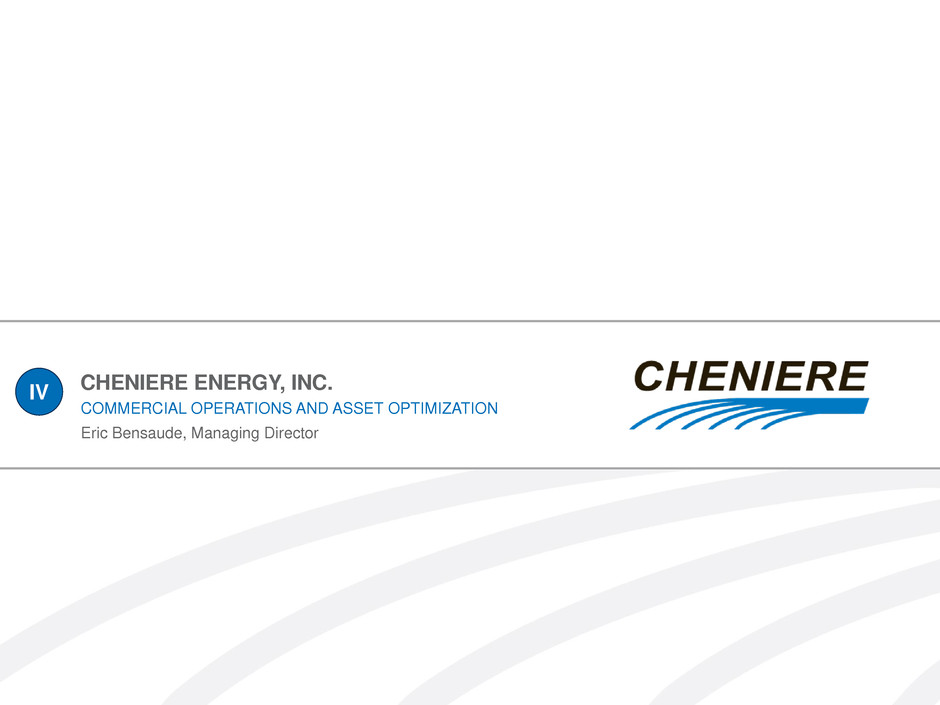
CHENIERE ENERGY, INC.
COMMERCIAL OPERATIONS AND ASSET OPTIMIZATION
IV
Eric Bensaude, Managing Director
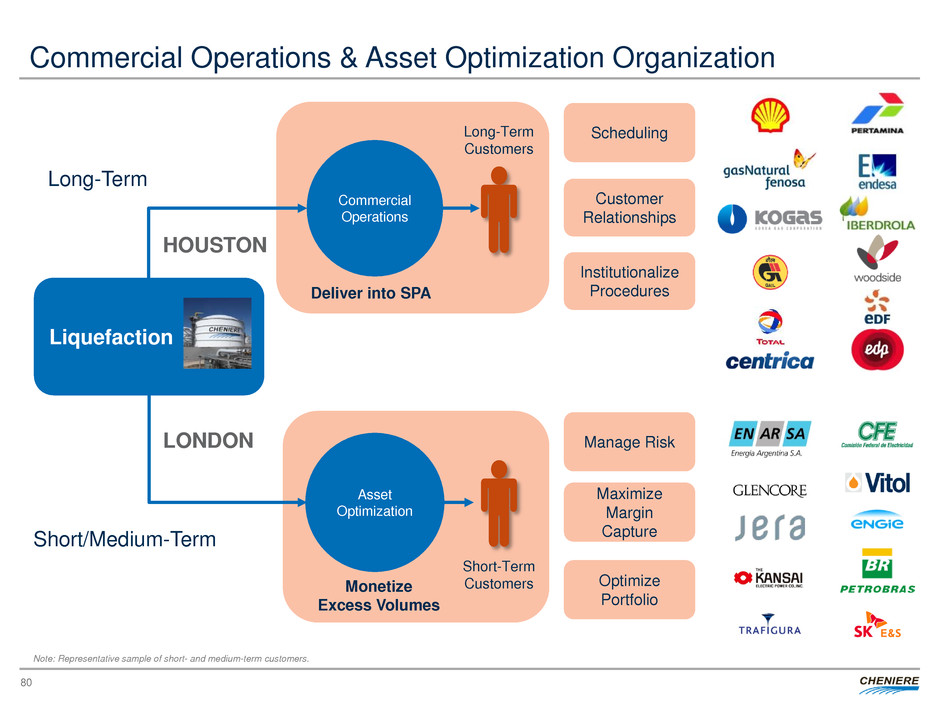
Commercial Operations & Asset Optimization Organization
80
Liquefaction
Asset
Optimization
Long-Term
Short/Medium-Term
Monetize
Excess Volumes
Short-Term
Customers
Long-Term
Customers
Commercial
Operations
Deliver into SPA
Scheduling
Customer
Relationships
Manage Risk
Maximize
Margin
Capture
Optimize
Portfolio
Institutionalize
Procedures
HOUSTON
LONDON
Note: Representative sample of short- and medium-term customers.
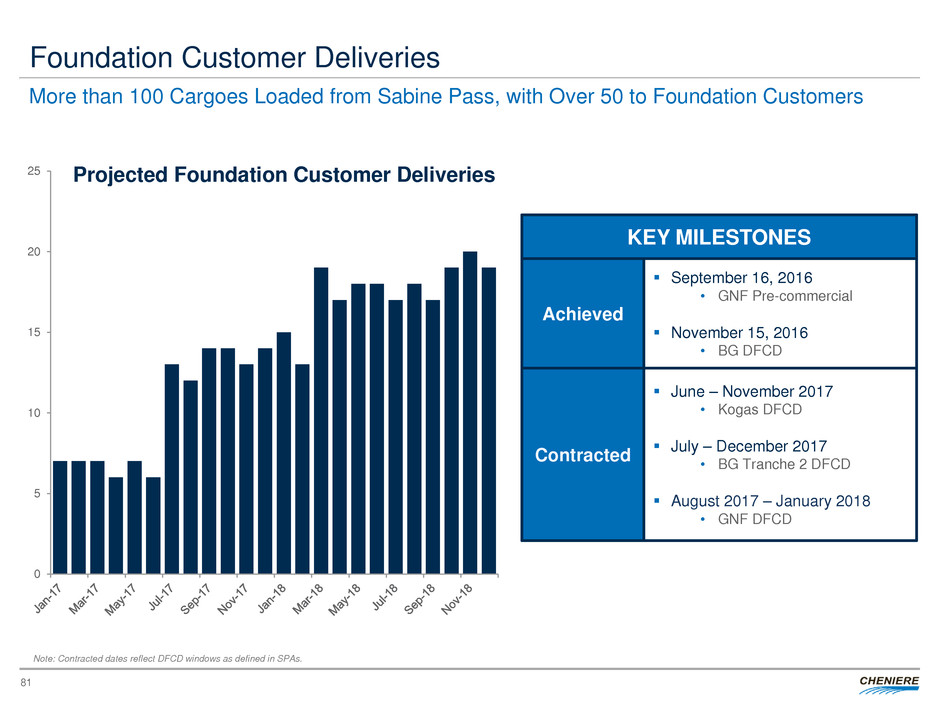
Foundation Customer Deliveries
81
More than 100 Cargoes Loaded from Sabine Pass, with Over 50 to Foundation Customers
0
5
10
15
20
25 Projected Foundation Customer Deliveries
KEY MILESTONES
Achieved
Contracted
September 16, 2016
• GNF Pre-commercial
November 15, 2016
• BG DFCD
June – November 2017
• Kogas DFCD
July – December 2017
• BG Tranche 2 DFCD
August 2017 – January 2018
• GNF DFCD
Note: Contracted dates reflect DFCD windows as defined in SPAs.
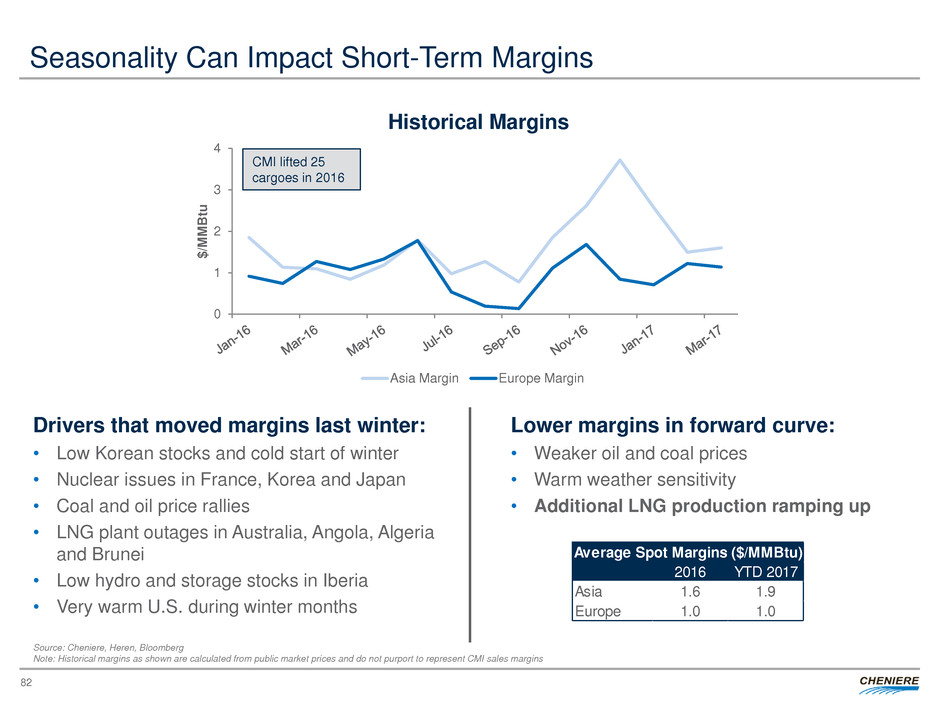
0
1
2
3
4
$/
M
M
B
tu
Historical Margins
Asia Margin Europe Margin
Seasonality Can Impact Short-Term Margins
82
Lower margins in forward curve:
• Weaker oil and coal prices
• Warm weather sensitivity
• Additional LNG production ramping up
Drivers that moved margins last winter:
• Low Korean stocks and cold start of winter
• Nuclear issues in France, Korea and Japan
• Coal and oil price rallies
• LNG plant outages in Australia, Angola, Algeria
and Brunei
• Low hydro and storage stocks in Iberia
• Very warm U.S. during winter months
CMI lifted 25
cargoes in 2016
Source: Cheniere, Heren, Bloomberg
Note: Historical margins as shown are calculated from public market prices and do not purport to represent CMI sales margins
2016 YTD 2017
Asia 1.6 1.9
Europe 1.0 1.0
Average Spot Margins ($/MMBtu)
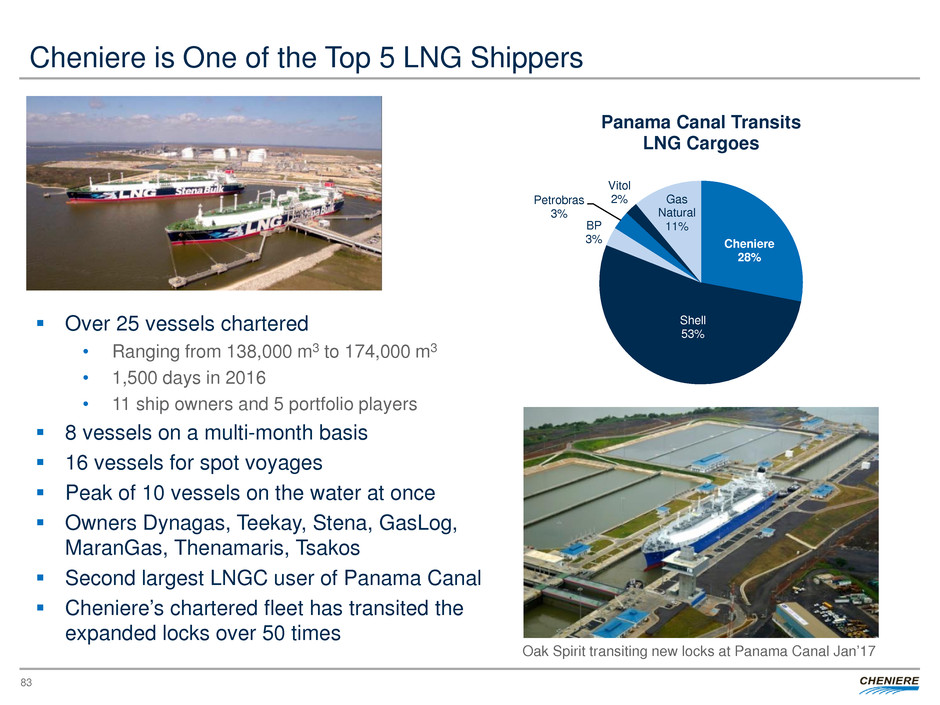
Cheniere is One of the Top 5 LNG Shippers
83
Oak Spirit transiting new locks at Panama Canal Jan’17
Over 25 vessels chartered
• Ranging from 138,000 m3 to 174,000 m3
• 1,500 days in 2016
• 11 ship owners and 5 portfolio players
8 vessels on a multi-month basis
16 vessels for spot voyages
Peak of 10 vessels on the water at once
Owners Dynagas, Teekay, Stena, GasLog,
MaranGas, Thenamaris, Tsakos
Second largest LNGC user of Panama Canal
Cheniere’s chartered fleet has transited the
expanded locks over 50 times
Cheniere
28%
Shell
53%
BP
3%
Petrobras
3%
Vitol
2% Gas
Natural
11%
Panama Canal Transits
LNG Cargoes
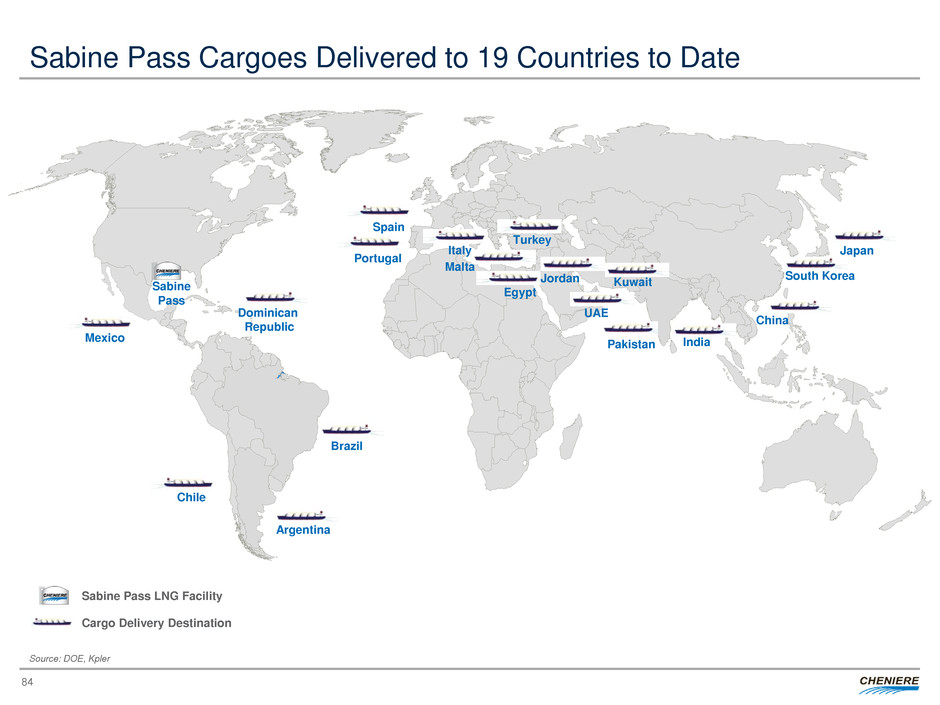
Sabine Pass Cargoes Delivered to 19 Countries to Date
84
Sabine Pass LNG Facility
Portugal
Kuwait
India
Brazil
Argentina
Cargo Delivery Destination
China
Spain
Sabine
Pass
Chile
Mexico
Jordan
Dominican
Republic
Turkey
Egypt
Japan
South Korea
Italy
UAE
Source: DOE, Kpler
Malta
Pakistan
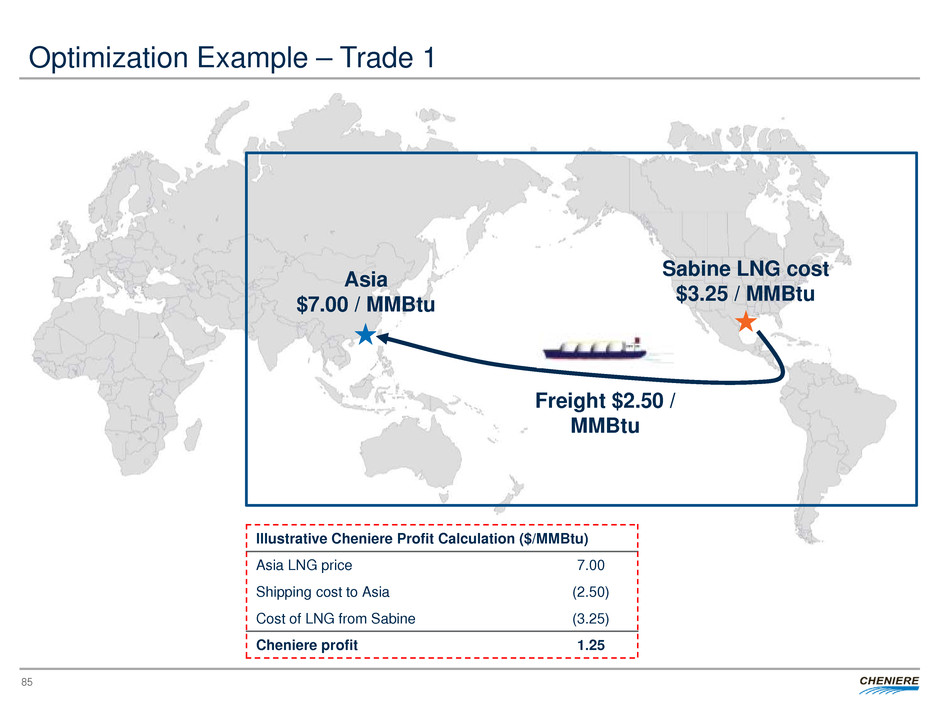
Optimization Example – Trade 1
Sabine LNG cost
$3.25 / MMBtu
Asia
$7.00 / MMBtu
Freight $2.50 /
MMBtu
Illustrative Cheniere Profit Calculation ($/MMBtu)
Asia LNG price 7.00
Shipping cost to Asia (2.50)
Cost of LNG from Sabine (3.25)
Cheniere profit 1.25
85
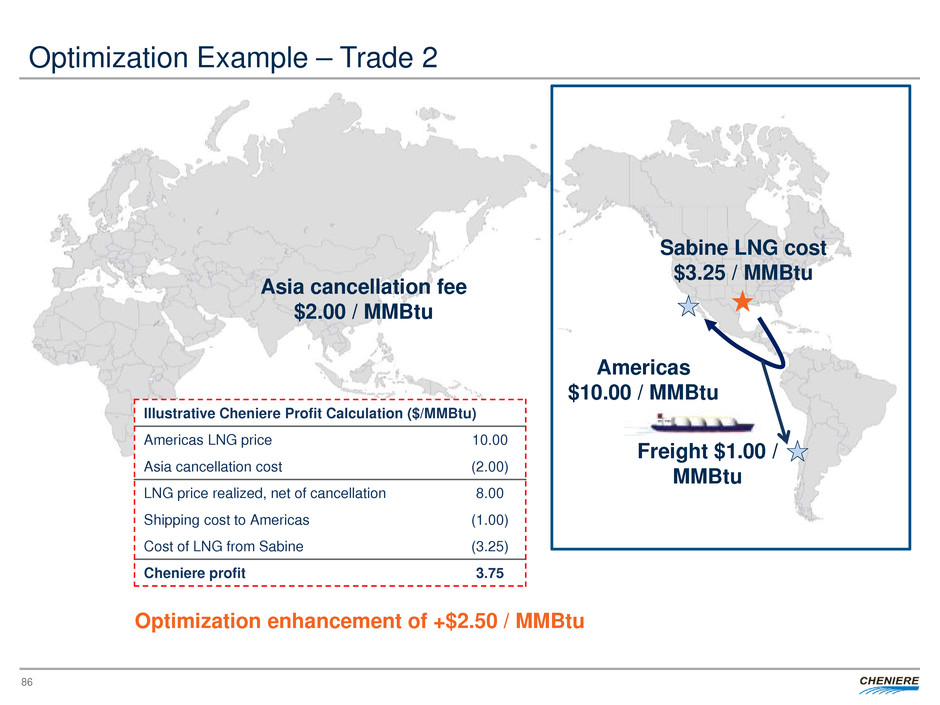
Optimization Example – Trade 2
Freight $1.00 /
MMBtu
Americas
$10.00 / MMBtu
Asia cancellation fee
$2.00 / MMBtu
Sabine LNG cost
$3.25 / MMBtu
Illustrative Cheniere Profit Calculation ($/MMBtu)
Americas LNG price 10.00
Asia cancellation cost (2.00)
LNG price realized, net of cancellation 8.00
Shipping cost to Americas (1.00)
Cost of LNG from Sabine (3.25)
Cheniere profit 3.75
Optimization enhancement of +$2.50 / MMBtu
86
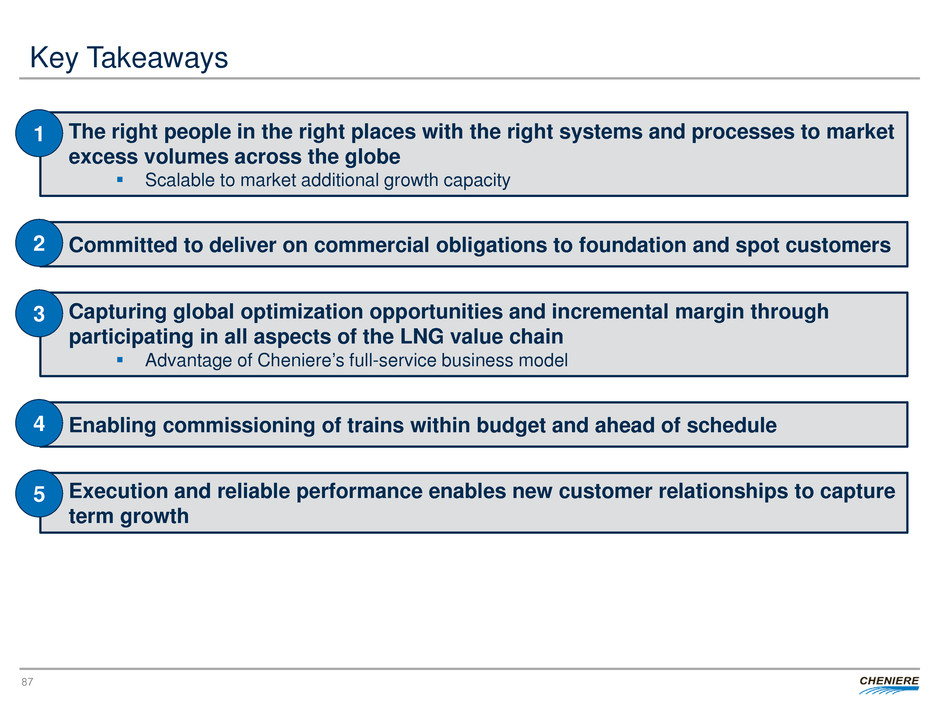
Key Takeaways
87
The right people in the right places with the right systems and processes to market
excess volumes across the globe
Scalable to market additional growth capacity
1
Committed to deliver on commercial obligations to foundation and spot customers 2
Capturing global optimization opportunities and incremental margin through
participating in all aspects of the LNG value chain
Advantage of Cheniere’s full-service business model
3
Enabling commissioning of trains within budget and ahead of schedule 4
Execution and reliable performance enables new customer relationships to capture
term growth
5
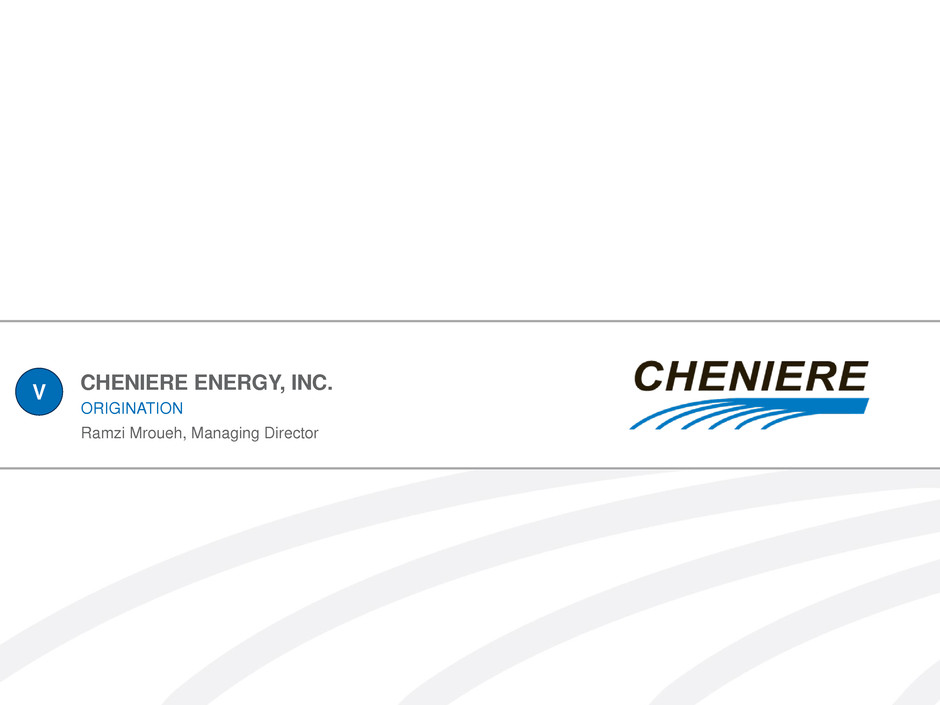
CHENIERE ENERGY, INC.
ORIGINATION
V
Ramzi Mroueh, Managing Director

Origination Group: A Strong Team in Place for Global Coverage
89
Singapore
Houston, TX
Santiago, Chile
London, U.K.
Origination Office
Americas EMEA Asia Pacific
Tokyo, Japan
Nationalities
Spanish, 7
French, 5
Chinese, 4
Russian, 3
German, 2
Arabic, 1
Dutch, 1
Hungarian, 1
Italian, 1
Japanese, 1
Malaysian, 1 Portuguese, 1
Languages
USA, 5
UK, 3
Argentinian, 1
Bolivia, 1
Chinese, 1
Dutch, 1
French, 1
Hungarian, 1
Japanese, 1
Lebanese, 1
Singaporean, 1
Spanish, 1
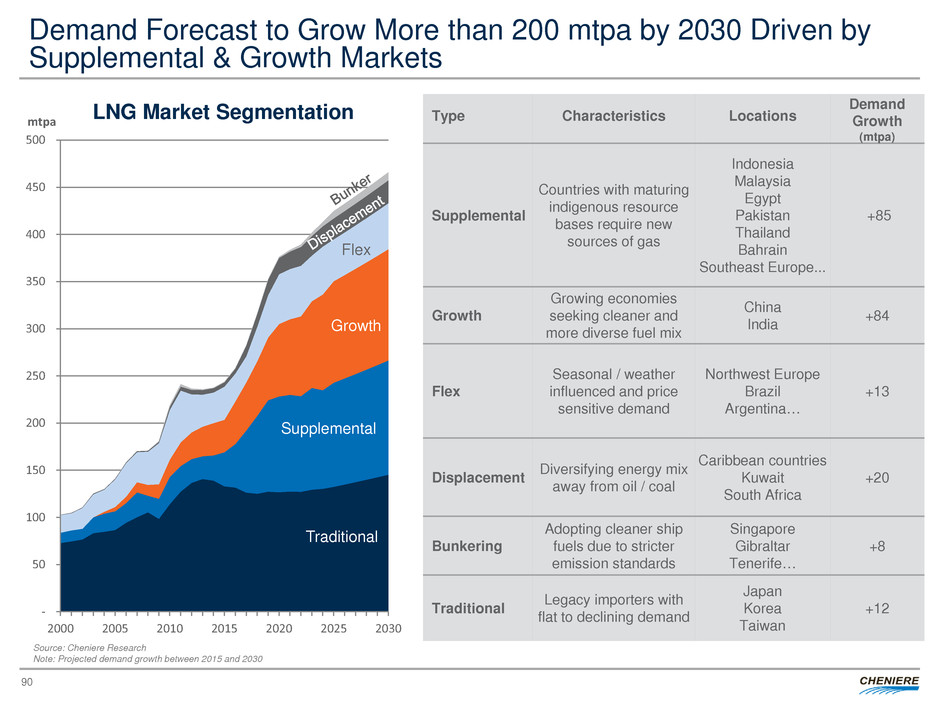
-
50
100
150
200
250
300
350
400
450
500
2000 2005 2010 2015 2020 2025 2030
mtpa
Demand Forecast to Grow More than 200 mtpa by 2030 Driven by
Supplemental & Growth Markets
90
LNG Market Segmentation
Traditional
Flex
Growth
Supplemental
Type
Characteristics
Locations
Demand
Growth
(mtpa)
Supplemental
Countries with maturing
indigenous resource
bases require new
sources of gas
Indonesia
Malaysia
Egypt
Pakistan
Thailand
Bahrain
Southeast Europe...
+85
Growth
Growing economies
seeking cleaner and
more diverse fuel mix
China
India +84
Flex
Seasonal / weather
influenced and price
sensitive demand
Northwest Europe
Brazil
Argentina…
+13
Displacement Diversifying energy mix away from oil / coal
Caribbean countries
Kuwait
South Africa
+20
Bunkering
Adopting cleaner ship
fuels due to stricter
emission standards
Singapore
Gibraltar
Tenerife…
+8
Traditional Legacy importers with flat to declining demand
Japan
Korea
Taiwan
+12
Source: Cheniere Research
Note: Projected demand growth between 2015 and 2030
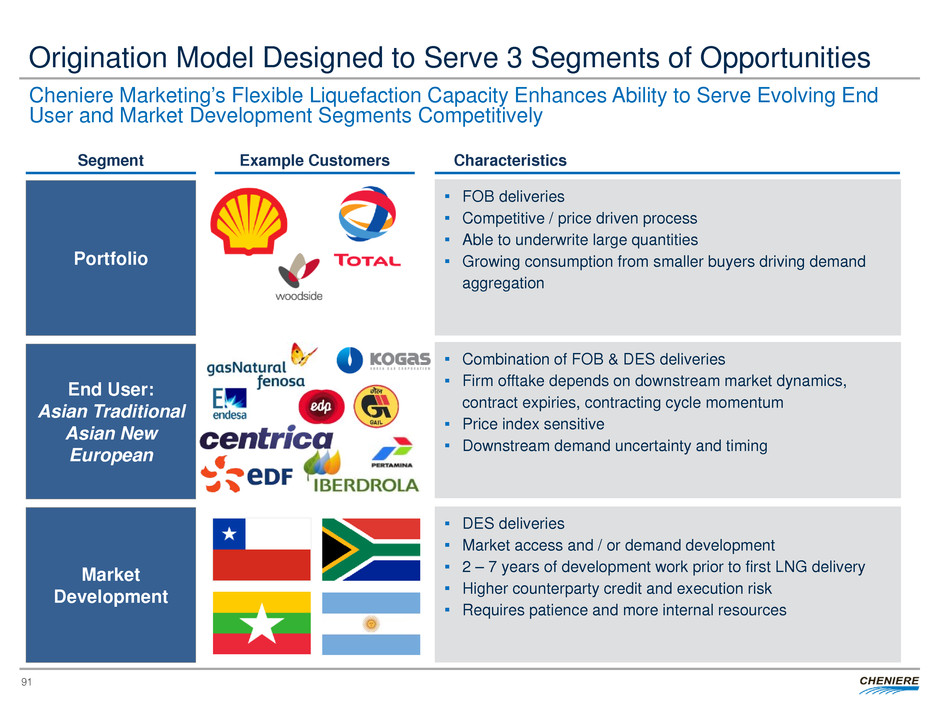
Origination Model Designed to Serve 3 Segments of Opportunities
91
Cheniere Marketing’s Flexible Liquefaction Capacity Enhances Ability to Serve Evolving End
User and Market Development Segments Competitively
Traditional
Supplemental
FOB deliveries
Competitive / price driven process
Able to underwrite large quantities
Growing consumption from smaller buyers driving demand
aggregation
Portfolio
Segment Example Customers Characteristics
End User:
Asian Traditional
Asian New
European
DES deliveries
Market access and / or demand development
2 – 7 years of development work prior to first LNG delivery
Higher counterparty credit and execution risk
Requires patience and more internal resources
Market
Development
Combination of FOB & DES deliveries
Firm offtake depends on downstream market dynamics,
contract expiries, contracting cycle momentum
Price index sensitive
Downstream demand uncertainty and timing

Key Takeaways
92
Cheniere professionals are strategically located across the globe to meet customer
needs
1
Active ongoing contracting discussions with multiple counterparties in the three
core market segments
2
Able to serve traditional portfolio customers as well as new end users in growth
and development markets
Cheniere is able to use its existing liquefaction capacity to offer unique and rapid solutions to
customers
Cheniere is able to provide solutions along the value chain: gas supply, LNG on an FOB or
DES basis, and downstream market developments
3
Market fundamentals are firmly positive and support long-term LNG demand
growth
4
Cheniere Ideally Positioned to Capture Significant Share of LNG Demand Growth
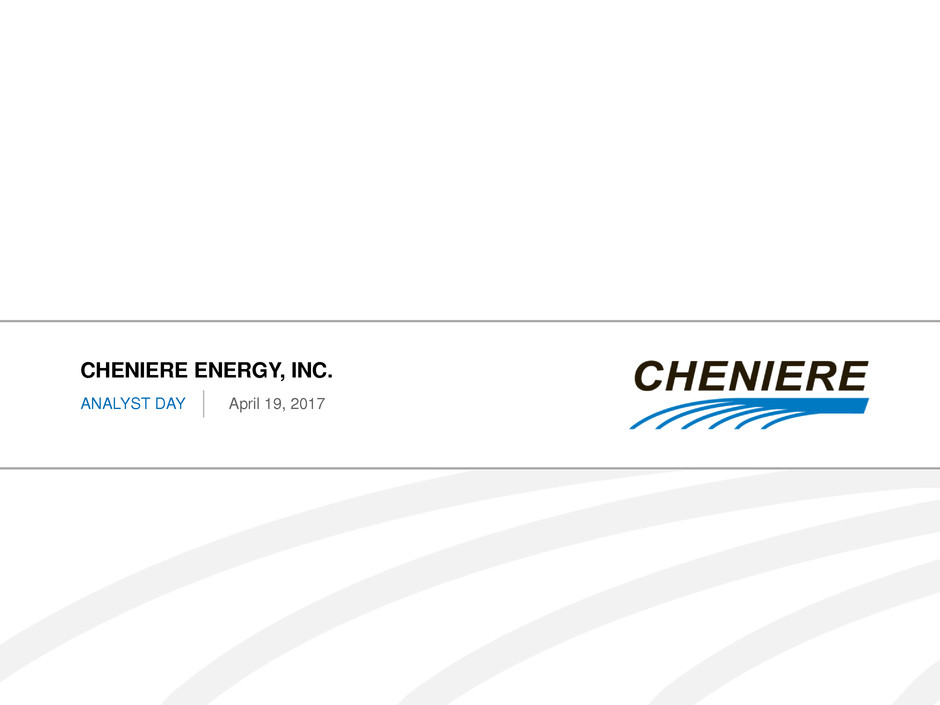
CHENIERE ENERGY, INC.
April 19, 2017 ANALYST DAY
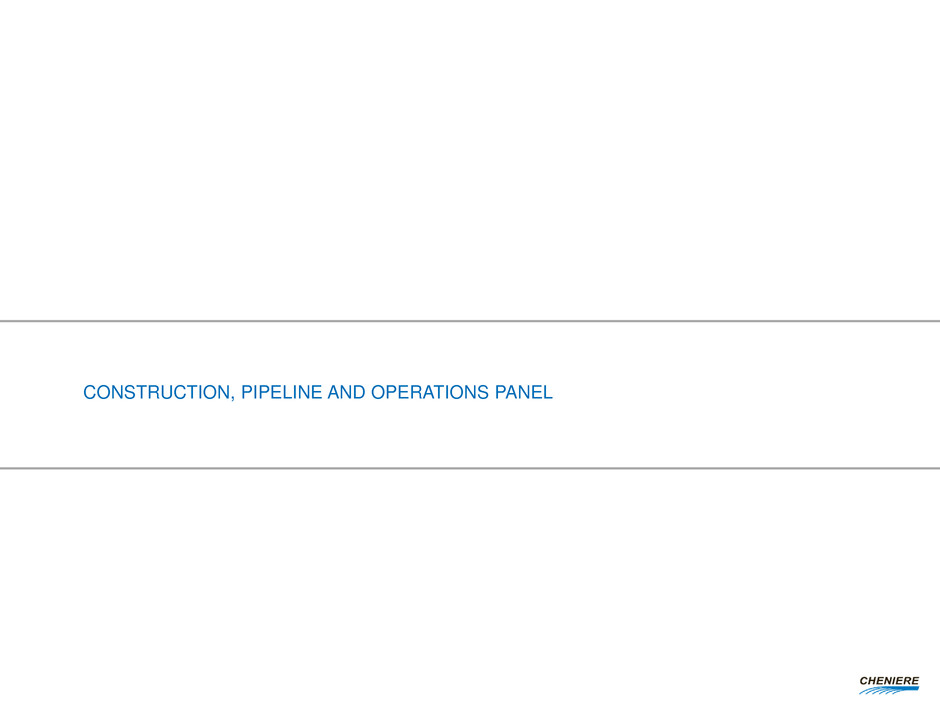
CONSTRUCTION, PIPELINE AND OPERATIONS PANEL
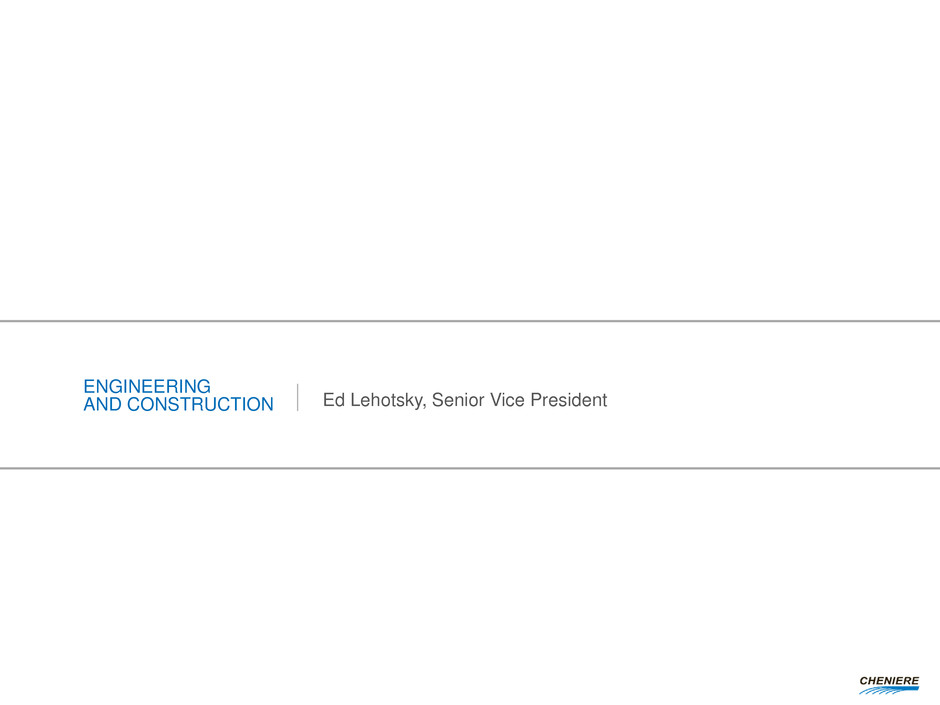
ENGINEERING
AND CONSTRUCTION Ed Lehotsky, Senior Vice President
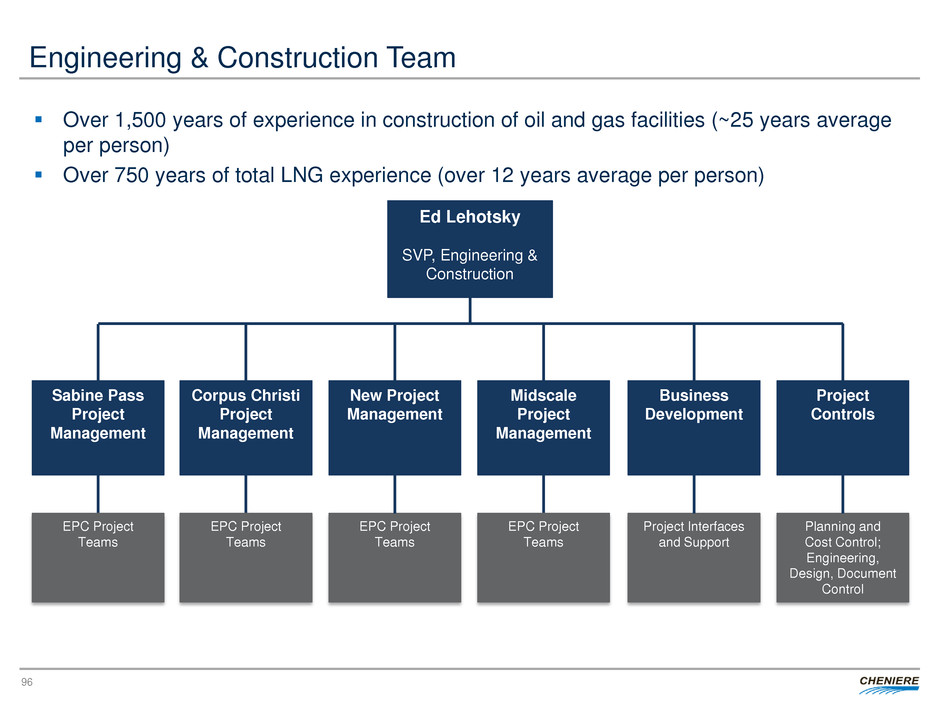
Engineering & Construction Team
96
Over 1,500 years of experience in construction of oil and gas facilities (~25 years average
per person)
Over 750 years of total LNG experience (over 12 years average per person)
Ed Lehotsky
SVP, Engineering &
Construction
New Project
Management
Project
Controls
Corpus Christi
Project
Management
Sabine Pass
Project
Management
Business
Development
Midscale
Project
Management
EPC Project
Teams
EPC Project
Teams
EPC Project
Teams
Planning and
Cost Control;
Engineering,
Design, Document
Control
Project Interfaces
and Support
EPC Project
Teams
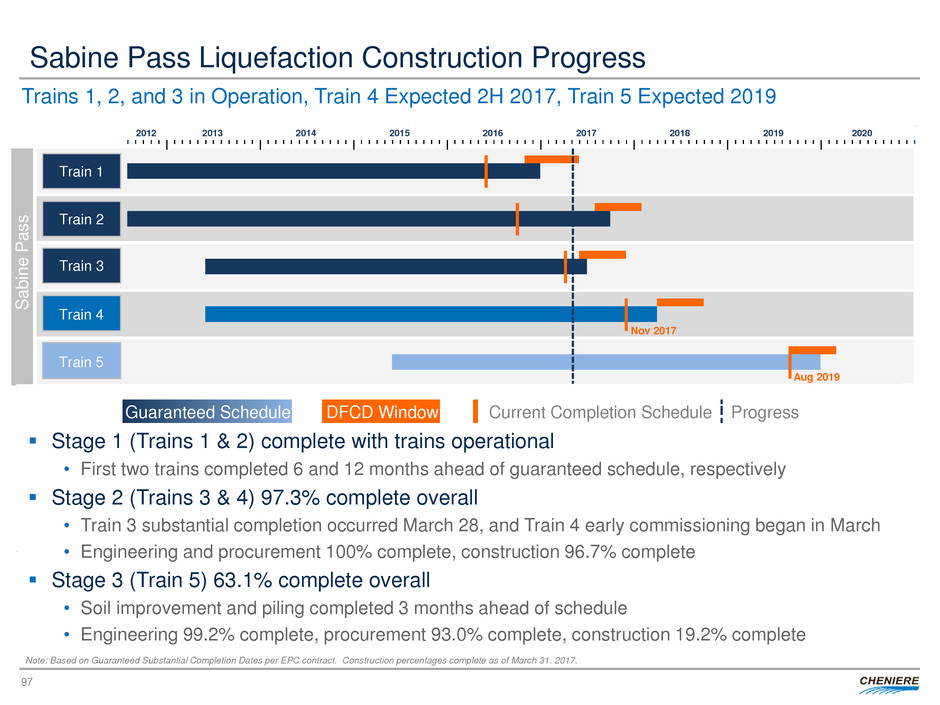
Sabine Pass Liquefaction Construction Progress
Trains 1, 2, and 3 in Operation, Train 4 Expected 2H 2017, Train 5 Expected 2019
Note: Based on Guaranteed Substantial Completion Dates per EPC contract. Construction percentages complete as of March 31. 2017.
DFCD Window Current Completion Schedule Progress Guaranteed Schedule
Nov 2017
S
ab
in
e
P
as
s
2020
Aug 2019
2018 2019 2012 2013 2014 2015 2016 2017
Train 1
Train 2
Train 3
Train 4
Train 5
Stage 1 (Trains 1 & 2) complete with trains operational
• First two trains completed 6 and 12 months ahead of guaranteed schedule, respectively
Stage 2 (Trains 3 & 4) 97.3% complete overall
• Train 3 substantial completion occurred March 28, and Train 4 early commissioning began in March
• Engineering and procurement 100% complete, construction 96.7% complete
Stage 3 (Train 5) 63.1% complete overall
• Soil improvement and piling completed 3 months ahead of schedule
• Engineering 99.2% complete, procurement 93.0% complete, construction 19.2% complete
97
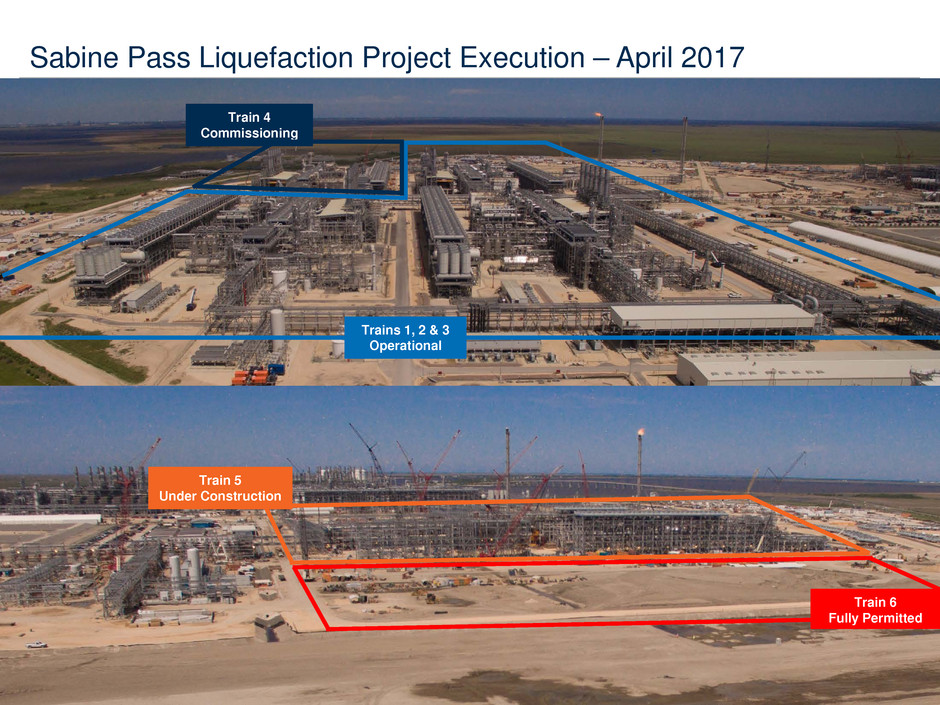
Sabine Pass Liquefaction Project Execution – April 2017
Trains 1, 2 & 3
Operational
Train 4
Commissioning
Train 5
Under Construction
Train 6
Fully Permitted
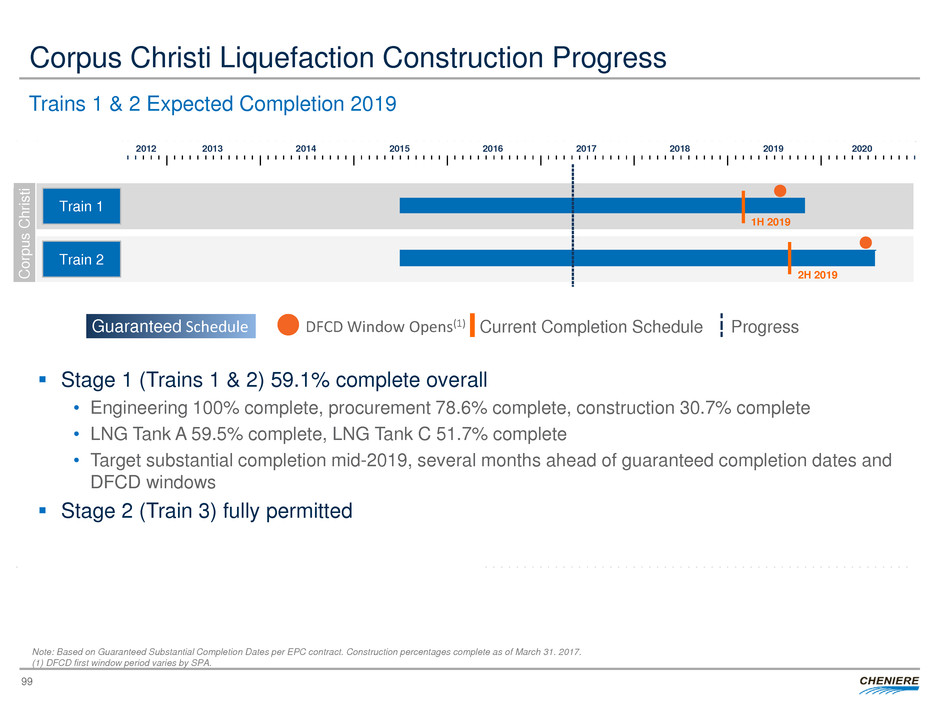
Corpus Christi Liquefaction Construction Progress
Trains 1 & 2 Expected Completion 2019
Stage 1 (Trains 1 & 2) 59.1% complete overall
• Engineering 100% complete, procurement 78.6% complete, construction 30.7% complete
• LNG Tank A 59.5% complete, LNG Tank C 51.7% complete
• Target substantial completion mid-2019, several months ahead of guaranteed completion dates and
DFCD windows
Stage 2 (Train 3) fully permitted
Note: Based on Guaranteed Substantial Completion Dates per EPC contract. Construction percentages complete as of March 31. 2017.
(1) DFCD first window period varies by SPA.
DFCD Window Opens(1) Current Completion Schedule Progress Guaranteed Schedule
2020
1H 2019
C
or
pu
s
C
hr
is
ti
2H 2019
2018 2019 2012 2013 2014 2015 2016 2017
Train 1
Train 2
99
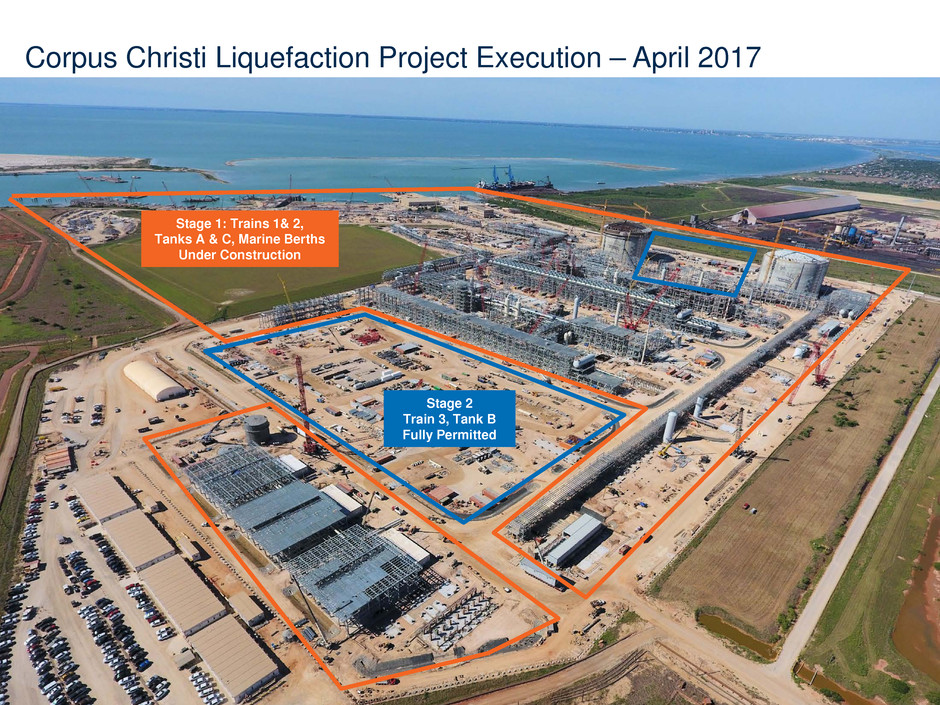
Corpus Christi Liquefaction Project Execution – April 2017
Stage 1: Trains 1& 2,
Tanks A & C, Marine Berths
Under Construction
Stage 2
Train 3, Tank B
Fully Permitted
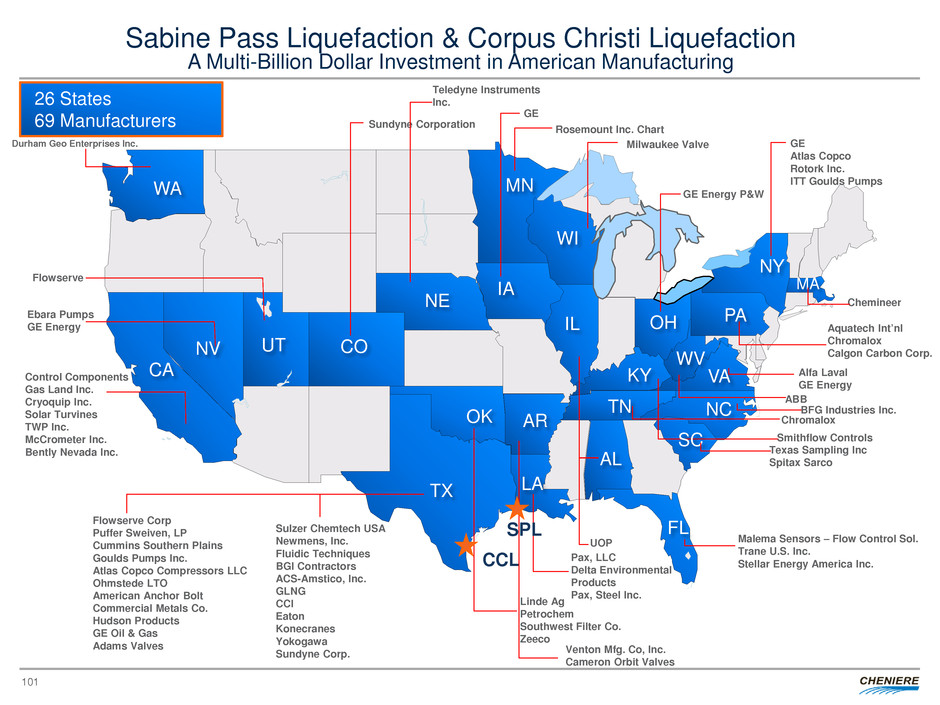
CA
CO
IA
LA
MN
NV
NY
OK
OH
TX
PA
VA
Flowserve
Ebara Pumps
GE Energy
Pax, LLC
Delta Environmental
Products
Pax, Steel Inc.
Rosemount Inc. Chart
GE
Linde Ag
Petrochem
Southwest Filter Co.
Zeeco
GE Energy P&W
Alfa Laval
GE Energy
Aquatech Int’nl
Chromalox
Calgon Carbon Corp.
GE
Atlas Copco
Rotork Inc.
ITT Goulds Pumps
Flowserve Corp
Puffer Sweiven, LP
Cummins Southern Plains
Goulds Pumps Inc.
Atlas Copco Compressors LLC
Ohmstede LTO
American Anchor Bolt
Commercial Metals Co.
Hudson Products
GE Oil & Gas
Adams Valves
Sulzer Chemtech USA
Newmens, Inc.
Fluidic Techniques
BGI Contractors
ACS-Amstico, Inc.
GLNG
CCI
Eaton
Konecranes
Yokogawa
Sundyne Corp.
Sundyne Corporation
26 States
69 Manufacturers
CCL
ABB
IL
WV
UT
Control Components
Gas Land Inc.
Cryoquip Inc.
Solar Turvines
TWP Inc.
McCrometer Inc.
Bently Nevada Inc.
TN
Chromalox
UOP
MA
Chemineer
AR
Venton Mfg. Co, Inc.
Cameron Orbit Valves
WI
Milwaukee Valve
FL
Malema Sensors – Flow Control Sol.
Trane U.S. Inc.
Stellar Energy America Inc.
AL
NE
Teledyne Instruments
Inc.
WA
Durham Geo Enterprises Inc.
KY
Smithflow Controls
NC
SC
BFG Industries Inc.
Texas Sampling Inc
Spitax Sarco
SPL
Sabine Pass Liquefaction & Corpus Christi Liquefaction
A Multi-Billion Dollar Investment in American Manufacturing
101
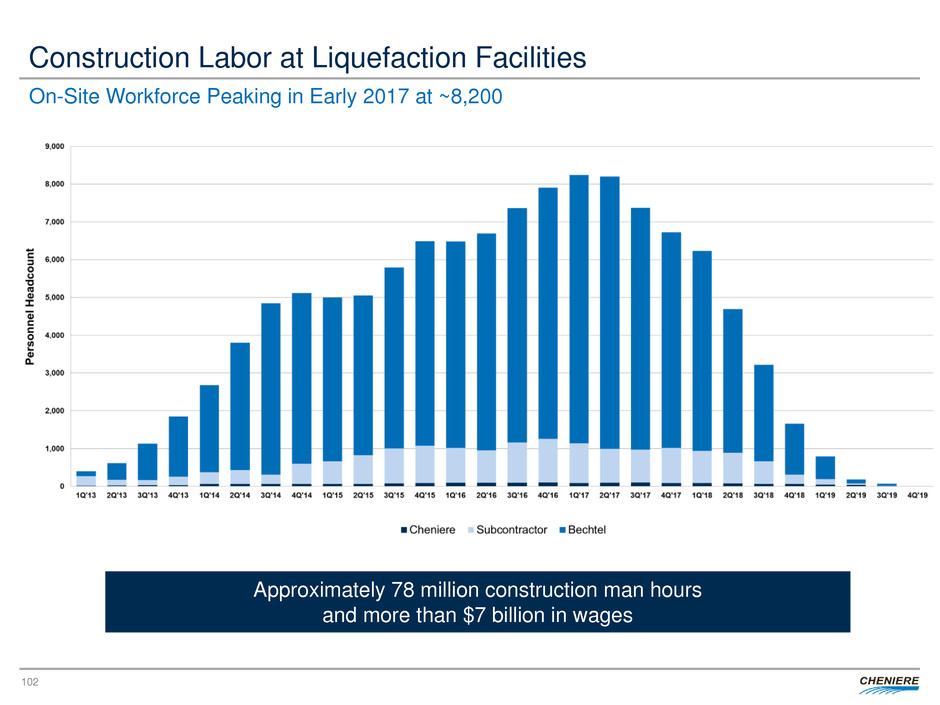
Construction Labor at Liquefaction Facilities
102
On-Site Workforce Peaking in Early 2017 at ~8,200
Approximately 78 million construction man hours
and more than $7 billion in wages
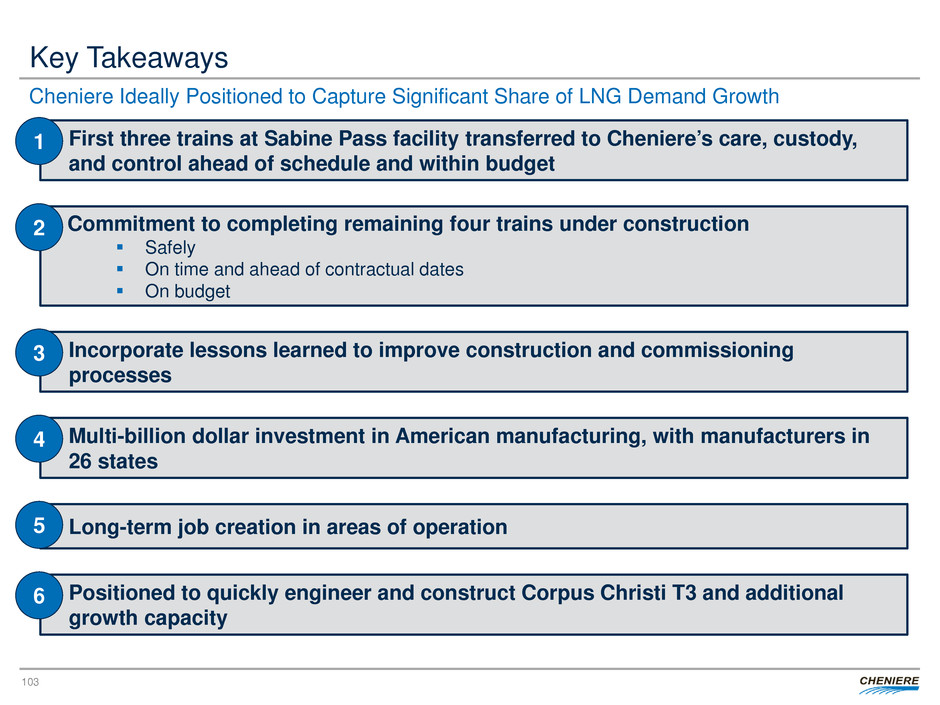
Key Takeaways
103
First three trains at Sabine Pass facility transferred to Cheniere’s care, custody,
and control ahead of schedule and within budget
1
Commitment to completing remaining four trains under construction
Safely
On time and ahead of contractual dates
On budget
2
Incorporate lessons learned to improve construction and commissioning
processes
3
Cheniere Ideally Positioned to Capture Significant Share of LNG Demand Growth
Multi-billion dollar investment in American manufacturing, with manufacturers in
26 states
4
Positioned to quickly engineer and construct Corpus Christi T3 and additional
growth capacity
6
Long-term job creation in areas of operation 5
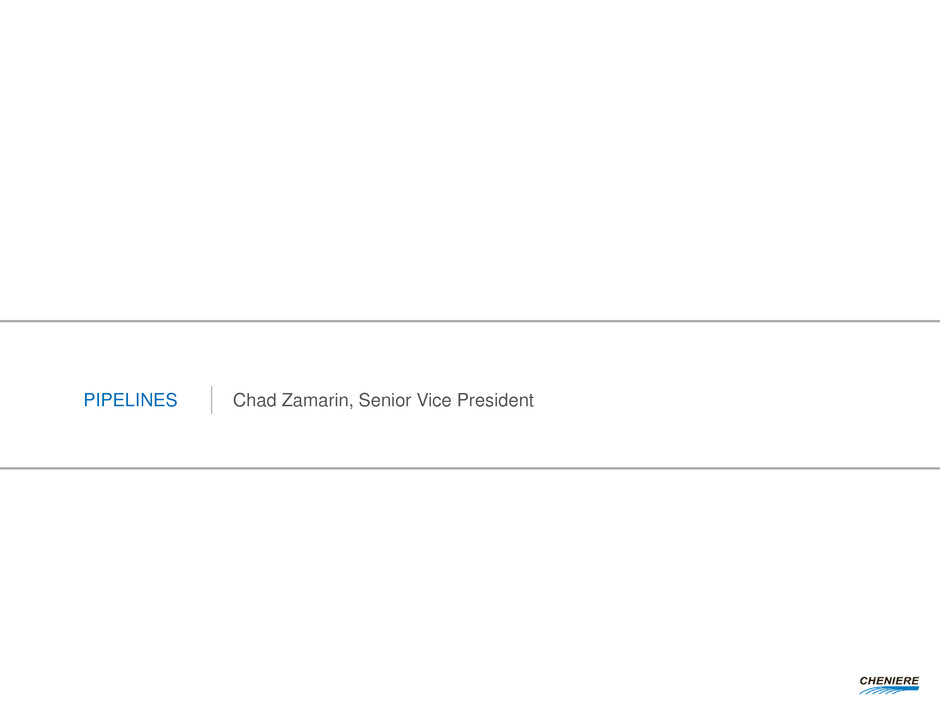
PIPELINES Chad Zamarin, Senior Vice President
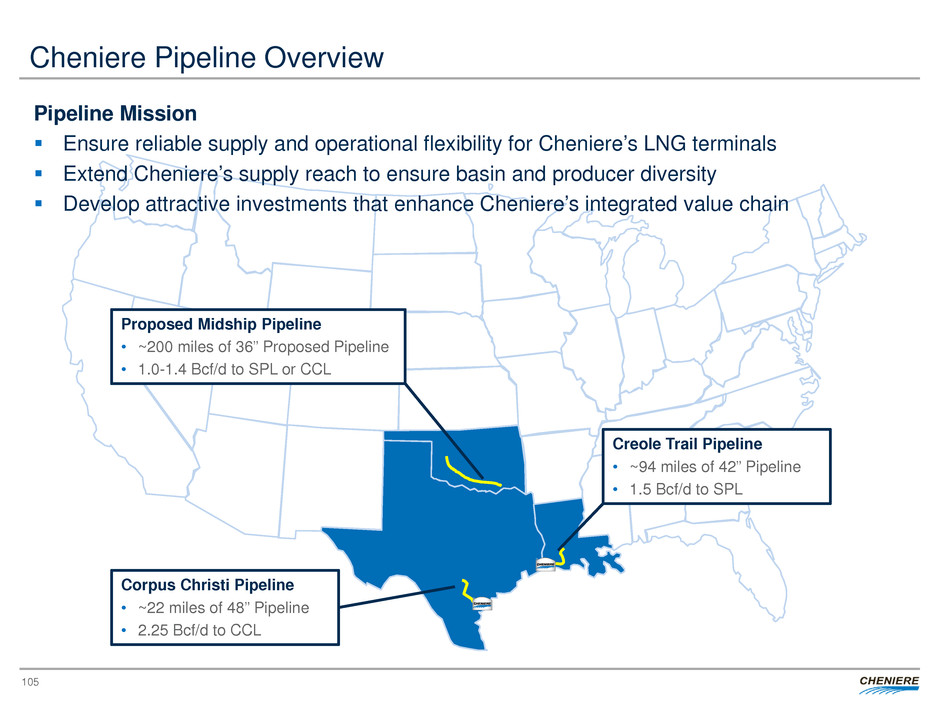
Cheniere Pipeline Overview
105
Pipeline Mission
Ensure reliable supply and operational flexibility for Cheniere’s LNG terminals
Extend Cheniere’s supply reach to ensure basin and producer diversity
Develop attractive investments that enhance Cheniere’s integrated value chain
Proposed Midship Pipeline
• ~200 miles of 36” Proposed Pipeline
• 1.0-1.4 Bcf/d to SPL or CCL
Creole Trail Pipeline
• ~94 miles of 42” Pipeline
• 1.5 Bcf/d to SPL
Corpus Christi Pipeline
• ~22 miles of 48” Pipeline
• 2.25 Bcf/d to CCL

Creole Trail Pipeline: Critical Infrastructure Serving Sabine Pass
Overview:
94 miles of 42” pipeline, 53,000 HP of
Compression
Interconnections with Trunkline, Transco
and TETCO
Design Rate: 1,500,000 Dth/d
Centralized gas control operations
Can provide ‘swing’ capacity to assist in
managing imbalances to terminal
-
200,000
400,000
600,000
800,000
1,000,000
1,200,000
1,400,000
1,600,000
1,800,000
Oct-16 Nov-16 Dec-16 Jan-17 Feb-17 Mar-17
D
th
/D
Creole Trail Pipeline Flows to Sabine Pass Facility
Safety:
Zero Lost Time, Reportable, and First
Aid cases
Ongoing safety initiative; championing
an “Own it; Live it” safety campaign
Annual safety summit and project
specific safety alignment for
employees and construction
contractors
Actively leading in industry forums on
pipeline safety matters
106
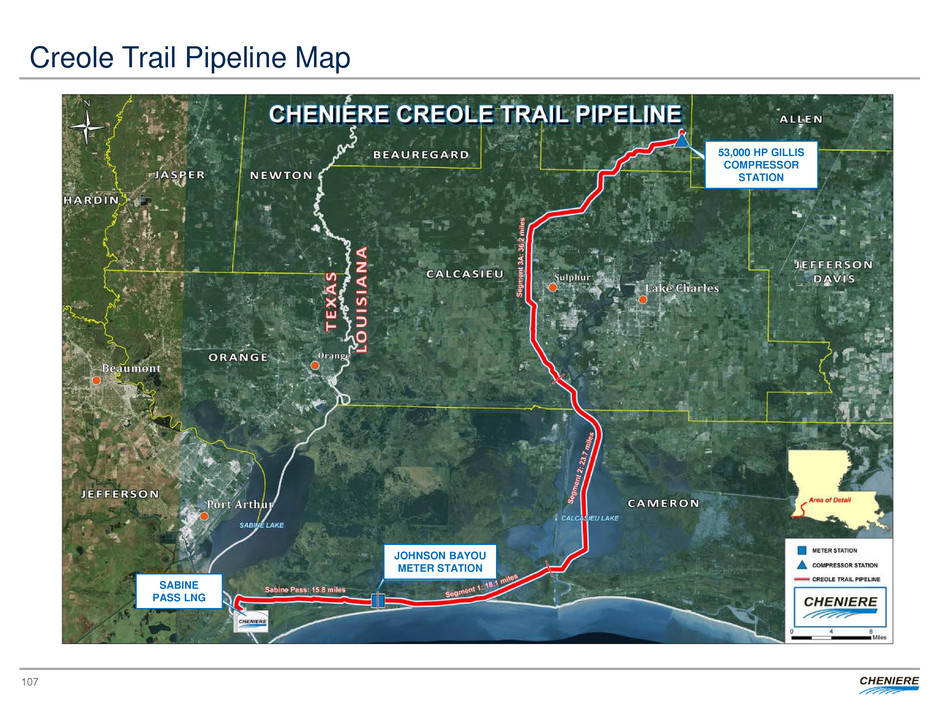
Creole Trail Pipeline Map
107
SABINE
PASS LNG
JOHNSON BAYOU
METER STATION
53,000 HP GILLIS
COMPRESSOR
STATION
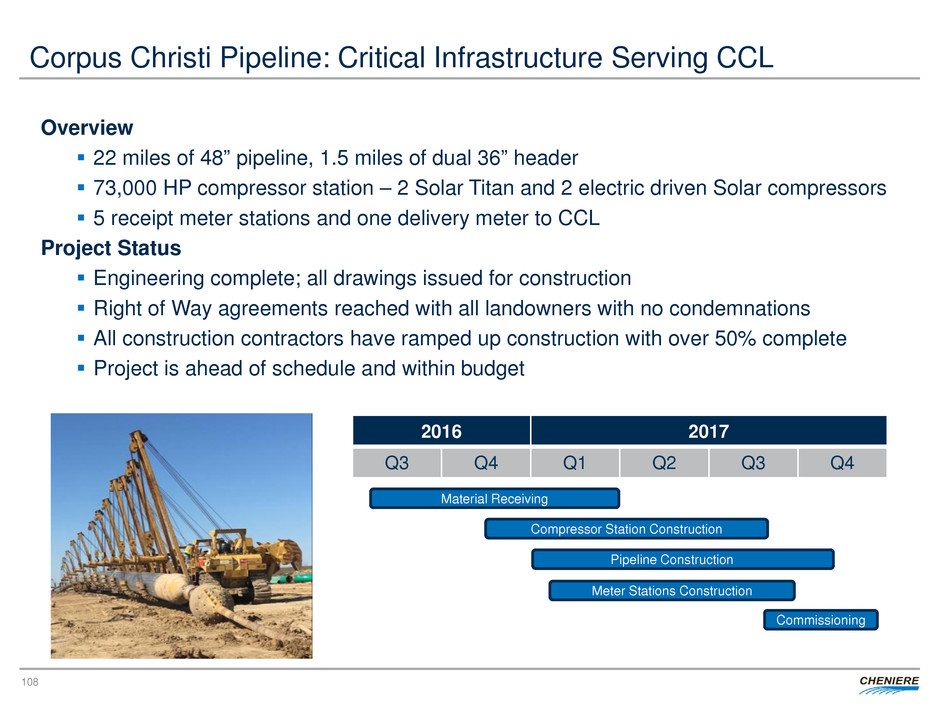
Corpus Christi Pipeline: Critical Infrastructure Serving CCL
Overview
22 miles of 48” pipeline, 1.5 miles of dual 36” header
73,000 HP compressor station – 2 Solar Titan and 2 electric driven Solar compressors
5 receipt meter stations and one delivery meter to CCL
Project Status
Engineering complete; all drawings issued for construction
Right of Way agreements reached with all landowners with no condemnations
All construction contractors have ramped up construction with over 50% complete
Project is ahead of schedule and within budget
108
2016 2017
Q3 Q4 Q1 Q2 Q3 Q4
Material Receiving
Commissioning
Meter Stations Construction
Pipeline Construction
Compressor Station Construction
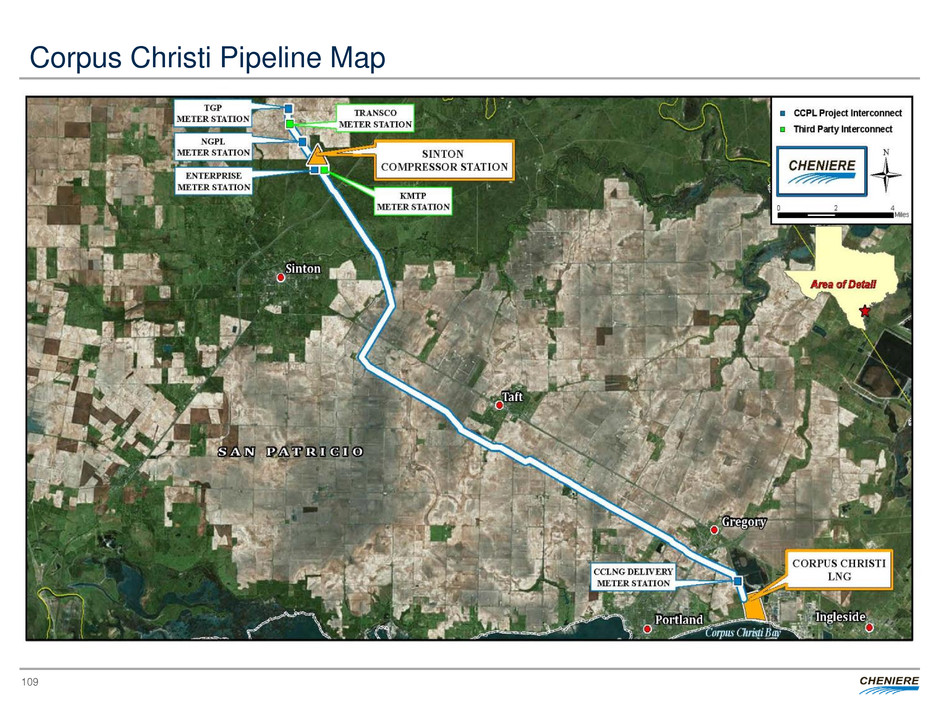
Corpus Christi Pipeline Map
109

Proposed Midship Pipeline: Extending and Diversifying
Cheniere’s Supply Reach
200 miles of mainline and 33 miles of laterals
originating in Kingfisher County, OK and
terminating in Bryan County, OK
Initial capacity of 1 Bcf/d, expandable to 1.4 Bcf/d
through addition of horsepower
Deliveries to Sabine Pass and Corpus Christi
facilities through Cheniere’s existing NGPL FT
capacity
Nine (9) receipt and four (4) delivery meter
stations
Three (3) compressor stations totaling 56,600 HP
110
Key Regulatory Milestones Target
Date
FERC meeting to provide project
overview
10/20/16
Initiation of Local, State, and Federal
agency contacts
10/20/16
Submittal of FERC Pre-Filing Request
Letter
10/28/16
FERC approval to proceed with Pre-Filing 11/9/16
4 Open Houses across project footprint 11/16/16
Filed draft Resource Reports 1 and 10 12/9/16
4 FERC Scoping meetings across project
footprint
2/14/17
Filed remaining Resource Reports 3/16/17
File FERC 7(c) Application 4/28/17
Receive FERC 7(c) Certification Est. 2018
Expected FERC Notice to Proceed Est. 2018
0
1
2
3
4
5
6
2016 2017 2018 2019 2020
G
as
P
ro
du
ct
io
n
(B
cf
/d
)
STACK (Cana Woodford) SCOOP
Forecasted STACK/SCOOP Production (Bcf/d)*
*Forecasted production from BTU Analytics.

Proposed Midship Pipeline Map
111
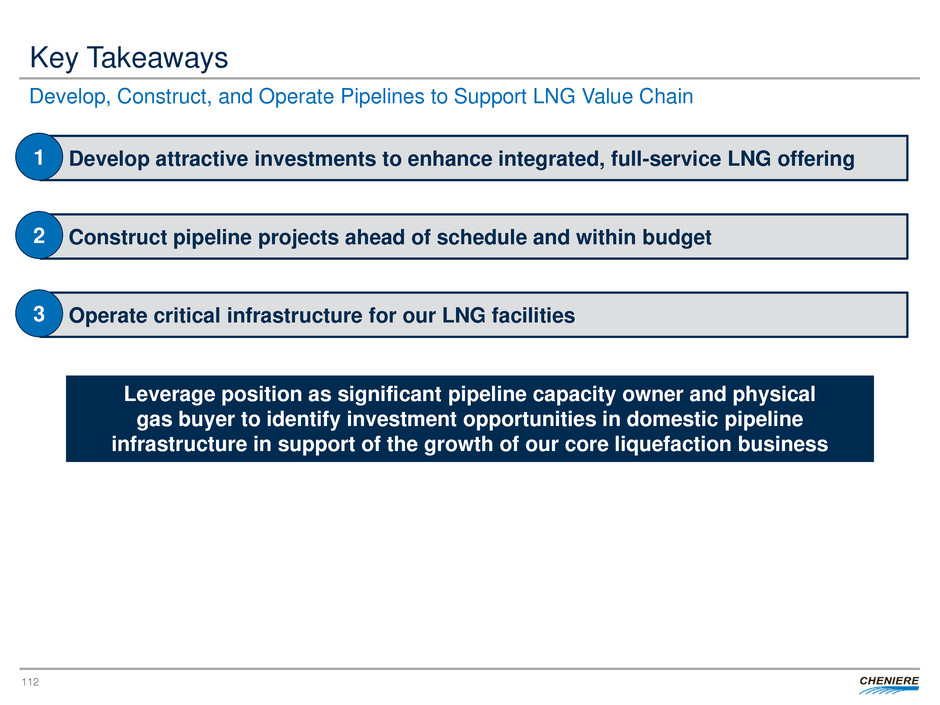
Key Takeaways
112
Develop attractive investments to enhance integrated, full-service LNG offering 1
Construct pipeline projects ahead of schedule and within budget 2
Operate critical infrastructure for our LNG facilities 3
Develop, Construct, and Operate Pipelines to Support LNG Value Chain
Leverage position as significant pipeline capacity owner and physical
gas buyer to identify investment opportunities in domestic pipeline
infrastructure in support of the growth of our core liquefaction business
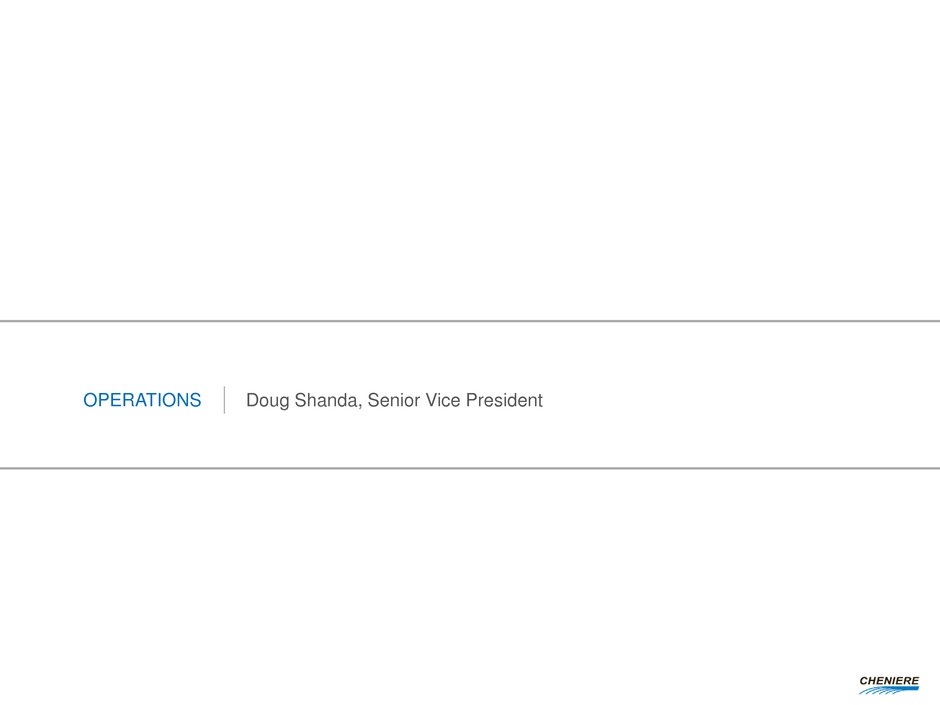
OPERATIONS Doug Shanda, Senior Vice President
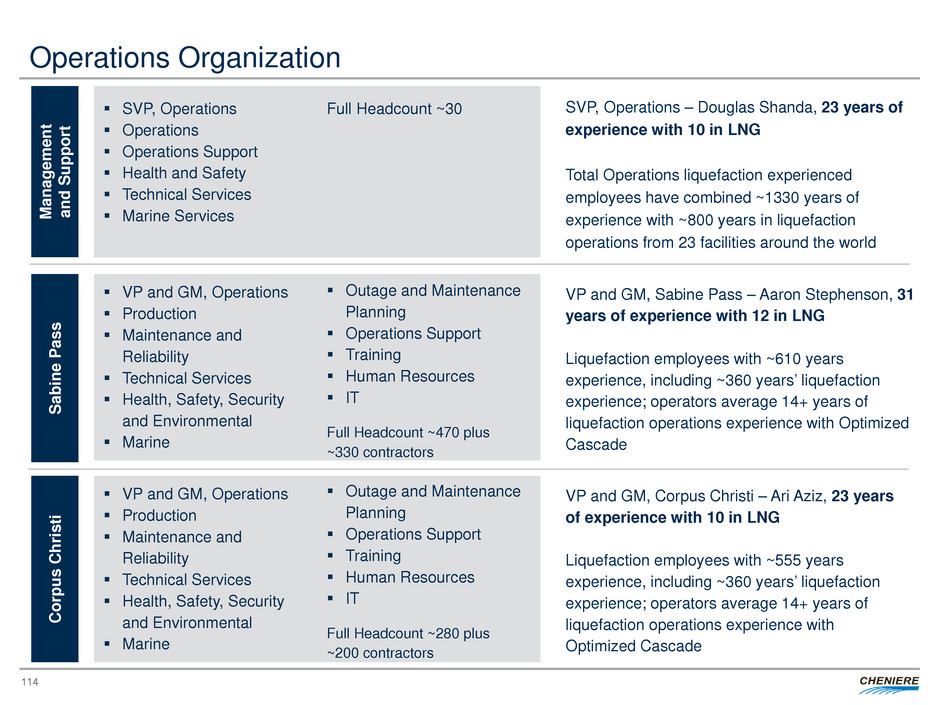
Operations Organization
M
an
ag
em
en
t
an
d
S
up
po
rt
S
ab
in
e
P
as
s
SVP, Operations – Douglas Shanda, 23 years of
experience with 10 in LNG
Total Operations liquefaction experienced
employees have combined ~1330 years of
experience with ~800 years in liquefaction
operations from 23 facilities around the world
VP and GM, Sabine Pass – Aaron Stephenson, 31
years of experience with 12 in LNG
Liquefaction employees with ~610 years
experience, including ~360 years’ liquefaction
experience; operators average 14+ years of
liquefaction operations experience with Optimized
Cascade
VP and GM, Corpus Christi – Ari Aziz, 23 years
of experience with 10 in LNG
Liquefaction employees with ~555 years
experience, including ~360 years’ liquefaction
experience; operators average 14+ years of
liquefaction operations experience with
Optimized Cascade
SVP, Operations
Operations
Operations Support
Health and Safety
Technical Services
Marine Services
C
or
pu
s
C
hr
is
ti
VP and GM, Operations
Production
Maintenance and
Reliability
Technical Services
Health, Safety, Security
and Environmental
Marine
Outage and Maintenance
Planning
Operations Support
Training
Human Resources
IT
Full Headcount ~470 plus
~330 contractors
VP and GM, Operations
Production
Maintenance and
Reliability
Technical Services
Health, Safety, Security
and Environmental
Marine
Outage and Maintenance
Planning
Operations Support
Training
Human Resources
IT
Full Headcount ~280 plus
~200 contractors
Full Headcount ~30
114
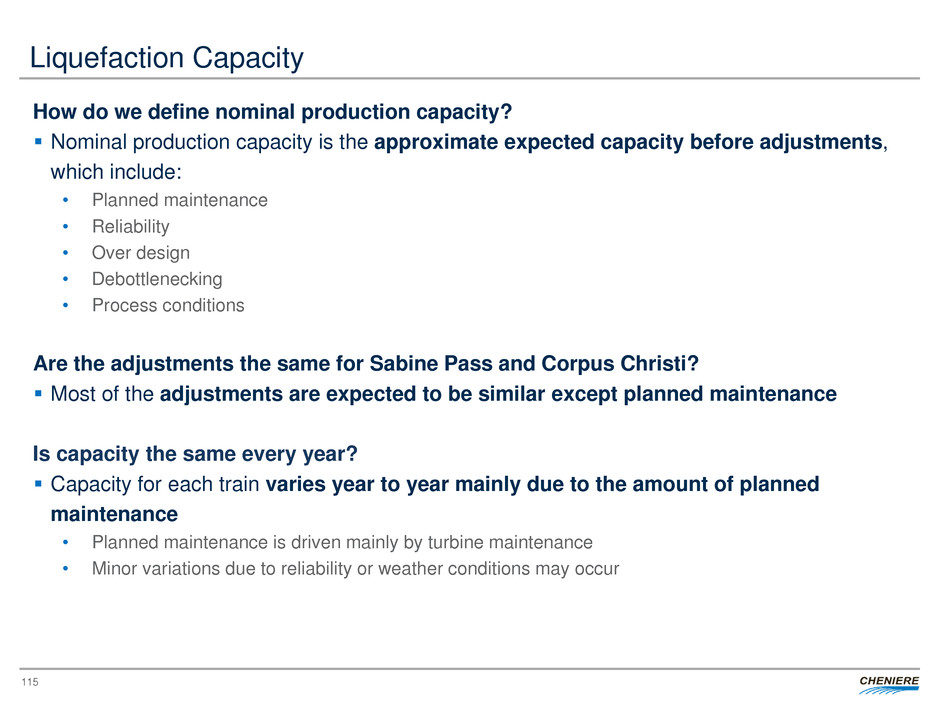
Liquefaction Capacity
115
How do we define nominal production capacity?
Nominal production capacity is the approximate expected capacity before adjustments,
which include:
• Planned maintenance
• Reliability
• Over design
• Debottlenecking
• Process conditions
Are the adjustments the same for Sabine Pass and Corpus Christi?
Most of the adjustments are expected to be similar except planned maintenance
Is capacity the same every year?
Capacity for each train varies year to year mainly due to the amount of planned
maintenance
• Planned maintenance is driven mainly by turbine maintenance
• Minor variations due to reliability or weather conditions may occur
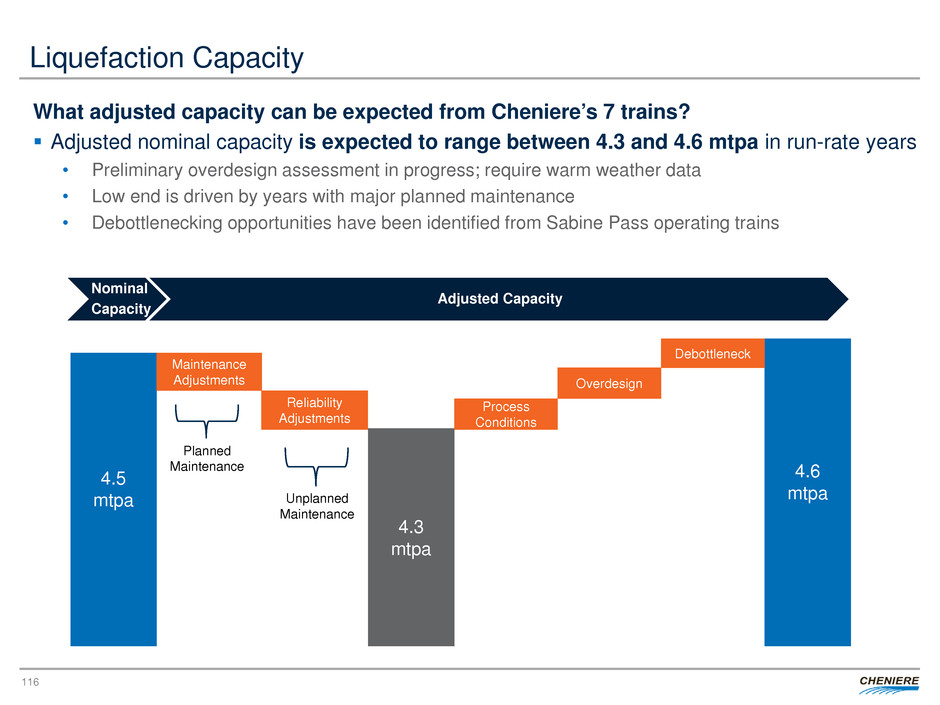
Liquefaction Capacity
116
4.5
mtpa
Maintenance
Adjustments
Reliability
Adjustments
4.3
mtpa
4.6
mtpa
Planned
Maintenance
Unplanned
Maintenance
Nominal
Capacity
Adjusted Capacity
What adjusted capacity can be expected from Cheniere’s 7 trains?
Adjusted nominal capacity is expected to range between 4.3 and 4.6 mtpa in run-rate years
• Preliminary overdesign assessment in progress; require warm weather data
• Low end is driven by years with major planned maintenance
• Debottlenecking opportunities have been identified from Sabine Pass operating trains
Debottleneck
Overdesign
Process
Conditions
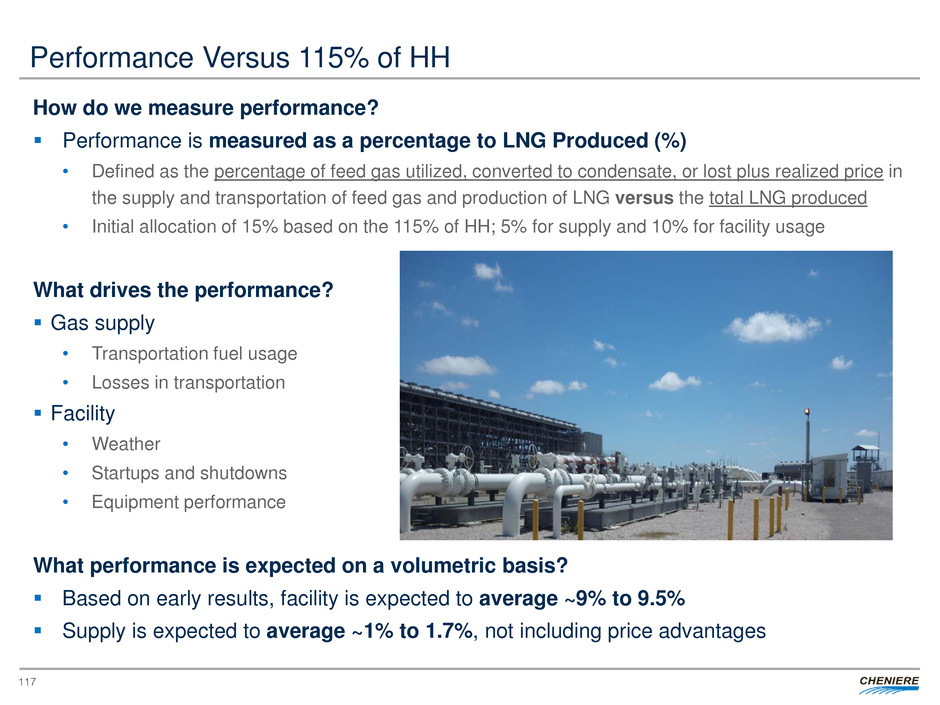
Performance Versus 115% of HH
How do we measure performance?
Performance is measured as a percentage to LNG Produced (%)
• Defined as the percentage of feed gas utilized, converted to condensate, or lost plus realized price in
the supply and transportation of feed gas and production of LNG versus the total LNG produced
• Initial allocation of 15% based on the 115% of HH; 5% for supply and 10% for facility usage
What drives the performance?
Gas supply
• Transportation fuel usage
• Losses in transportation
Facility
• Weather
• Startups and shutdowns
• Equipment performance
What performance is expected on a volumetric basis?
Based on early results, facility is expected to average ~9% to 9.5%
Supply is expected to average ~1% to 1.7%, not including price advantages
117
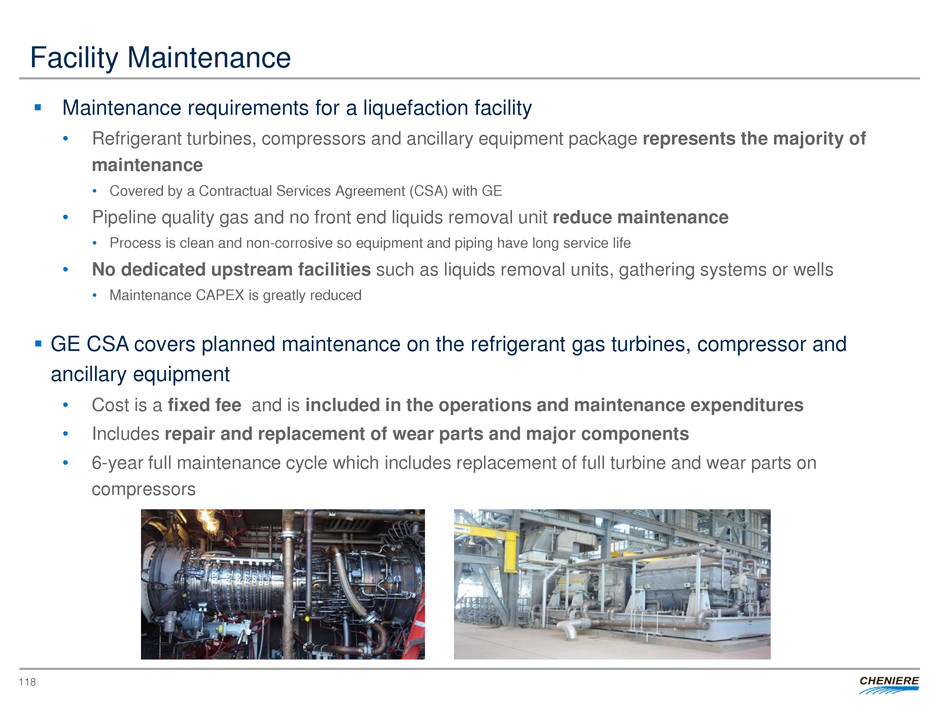
Facility Maintenance
Maintenance requirements for a liquefaction facility
• Refrigerant turbines, compressors and ancillary equipment package represents the majority of
maintenance
• Covered by a Contractual Services Agreement (CSA) with GE
• Pipeline quality gas and no front end liquids removal unit reduce maintenance
• Process is clean and non-corrosive so equipment and piping have long service life
• No dedicated upstream facilities such as liquids removal units, gathering systems or wells
• Maintenance CAPEX is greatly reduced
GE CSA covers planned maintenance on the refrigerant gas turbines, compressor and
ancillary equipment
• Cost is a fixed fee and is included in the operations and maintenance expenditures
• Includes repair and replacement of wear parts and major components
• 6-year full maintenance cycle which includes replacement of full turbine and wear parts on
compressors
118
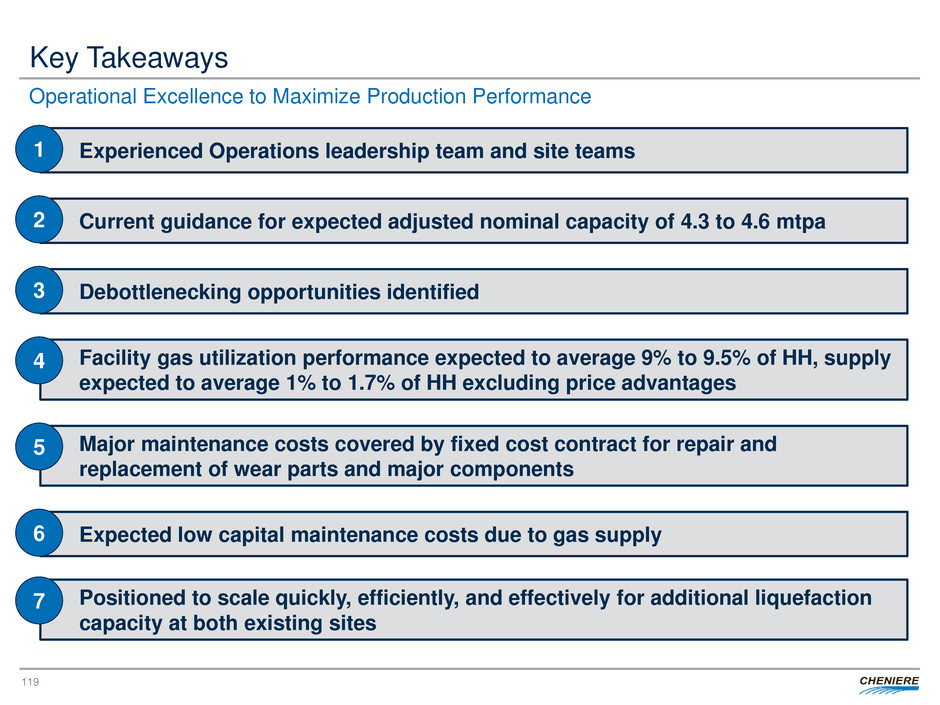
Key Takeaways
119
Experienced Operations leadership team and site teams 1
Current guidance for expected adjusted nominal capacity of 4.3 to 4.6 mtpa 2
Debottlenecking opportunities identified 3
Operational Excellence to Maximize Production Performance
Facility gas utilization performance expected to average 9% to 9.5% of HH, supply
expected to average 1% to 1.7% of HH excluding price advantages
4
Major maintenance costs covered by fixed cost contract for repair and
replacement of wear parts and major components
5
Expected low capital maintenance costs due to gas supply 6
Positioned to scale quickly, efficiently, and effectively for additional liquefaction
capacity at both existing sites
7

CHENIERE ENERGY, INC.
April 19, 2017 ANALYST DAY
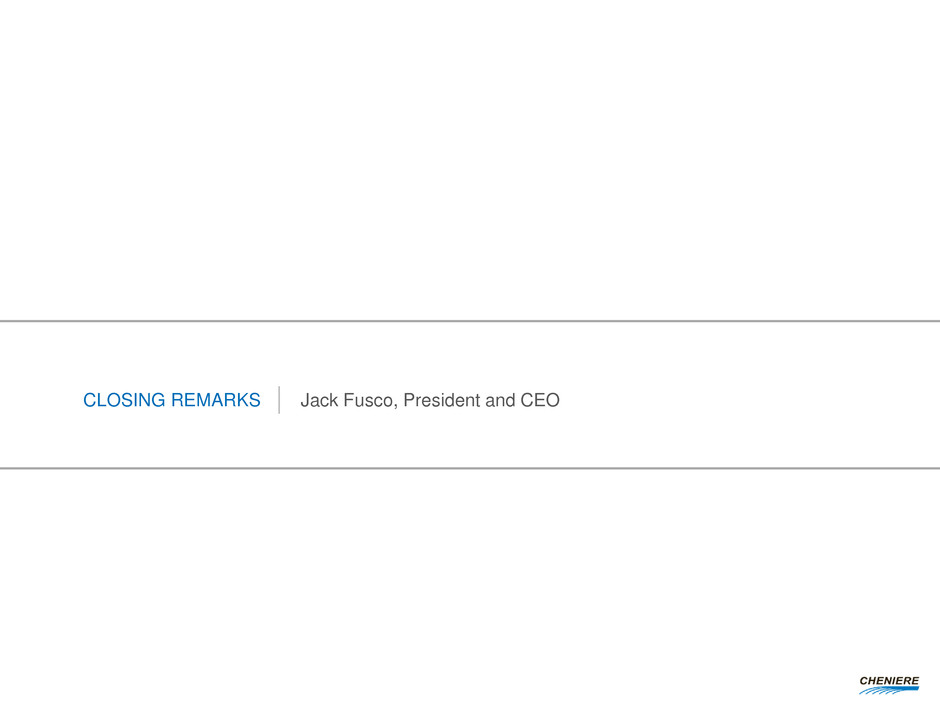
CLOSING REMARKS Jack Fusco, President and CEO
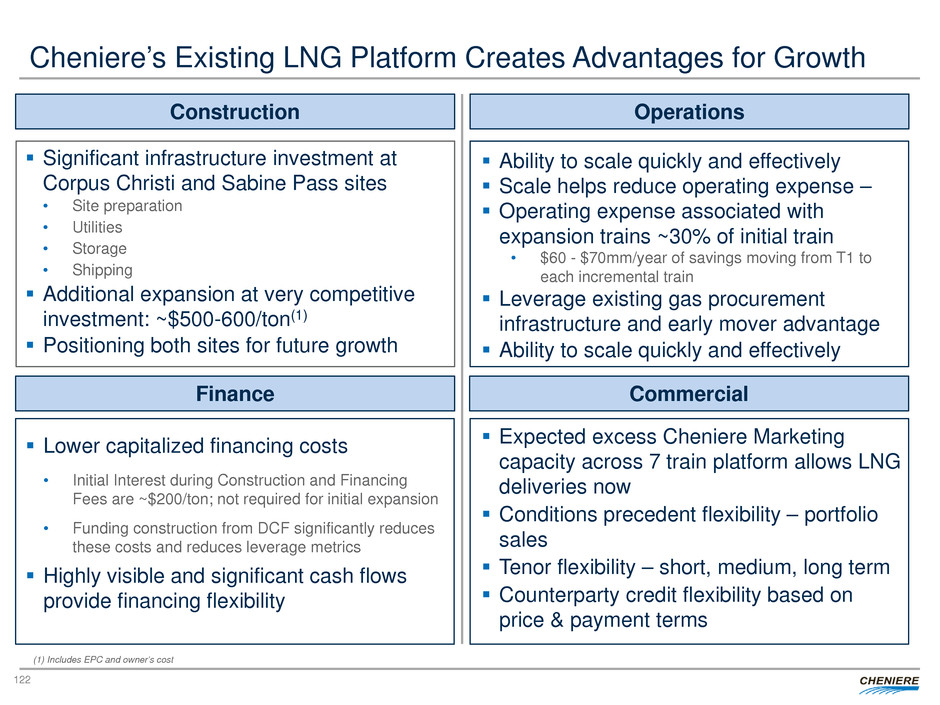
Cheniere’s Existing LNG Platform Creates Advantages for Growth
Construction Operations
Significant infrastructure investment at
Corpus Christi and Sabine Pass sites
• Site preparation
• Utilities
• Storage
• Shipping
Additional expansion at very competitive
investment: ~$500-600/ton(1)
Positioning both sites for future growth
Ability to scale quickly and effectively
Scale helps reduce operating expense –
Operating expense associated with
expansion trains ~30% of initial train
• $60 - $70mm/year of savings moving from T1 to
each incremental train
Leverage existing gas procurement
infrastructure and early mover advantage
Ability to scale quickly and effectively
Finance Commercial
Expected excess Cheniere Marketing
capacity across 7 train platform allows LNG
deliveries now
Conditions precedent flexibility – portfolio
sales
Tenor flexibility – short, medium, long term
Counterparty credit flexibility based on
price & payment terms
Lower capitalized financing costs
• Initial Interest during Construction and Financing
Fees are ~$200/ton; not required for initial expansion
• Funding construction from DCF significantly reduces
these costs and reduces leverage metrics
Highly visible and significant cash flows
provide financing flexibility
(1) Includes EPC and owner’s cost
122

CHENIERE ENERGY, INC.
April 19, 2017 ANALYST DAY
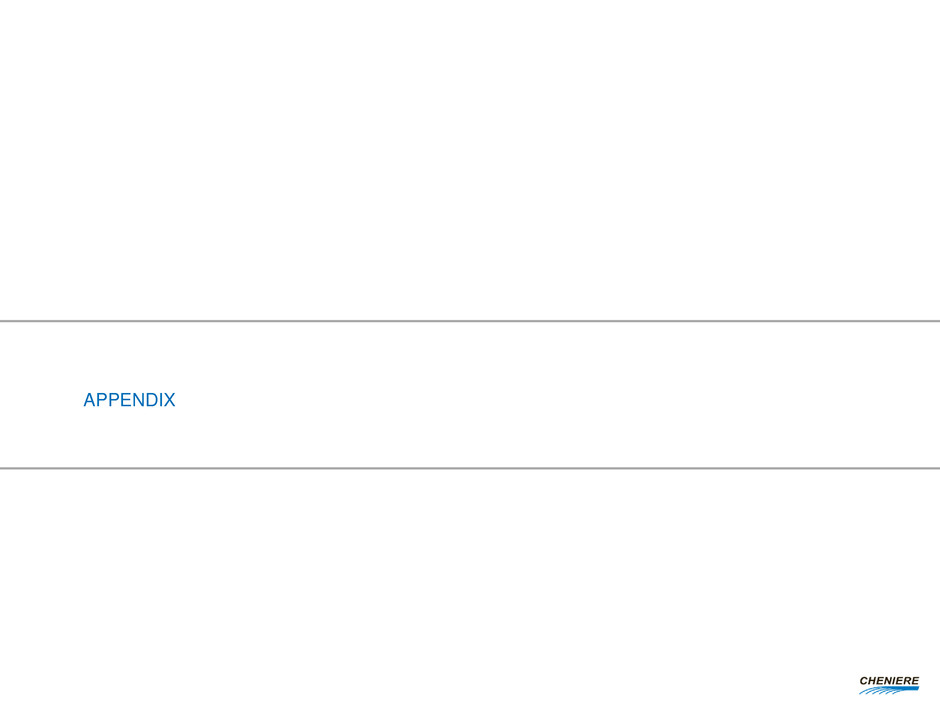
APPENDIX
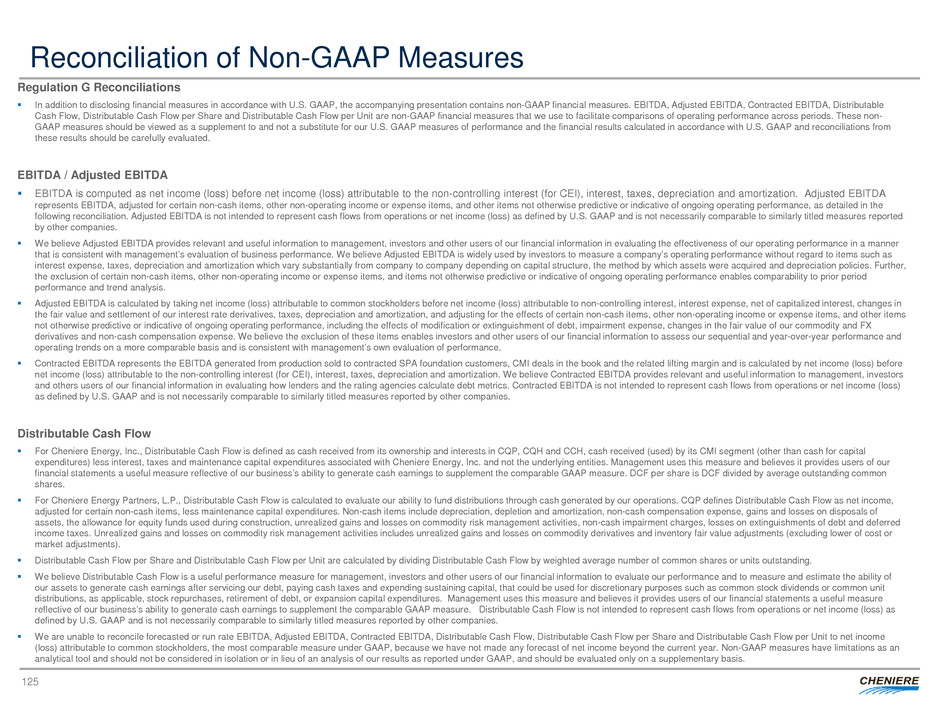
Reconciliation of Non-GAAP Measures
125
Regulation G Reconciliations
In addition to disclosing financial measures in accordance with U.S. GAAP, the accompanying presentation contains non-GAAP financial measures. EBITDA, Adjusted EBITDA, Contracted EBITDA, Distributable
Cash Flow, Distributable Cash Flow per Share and Distributable Cash Flow per Unit are non-GAAP financial measures that we use to facilitate comparisons of operating performance across periods. These non-
GAAP measures should be viewed as a supplement to and not a substitute for our U.S. GAAP measures of performance and the financial results calculated in accordance with U.S. GAAP and reconciliations from
these results should be carefully evaluated.
EBITDA / Adjusted EBITDA
EBITDA is computed as net income (loss) before net income (loss) attributable to the non-controlling interest (for CEI), interest, taxes, depreciation and amortization. Adjusted EBITDA
represents EBITDA, adjusted for certain non-cash items, other non-operating income or expense items, and other items not otherwise predictive or indicative of ongoing operating performance, as detailed in the
following reconciliation. Adjusted EBITDA is not intended to represent cash flows from operations or net income (loss) as defined by U.S. GAAP and is not necessarily comparable to similarly titled measures reported
by other companies.
We believe Adjusted EBITDA provides relevant and useful information to management, investors and other users of our financial information in evaluating the effectiveness of our operating performance in a manner
that is consistent with management’s evaluation of business performance. We believe Adjusted EBITDA is widely used by investors to measure a company’s operating performance without regard to items such as
interest expense, taxes, depreciation and amortization which vary substantially from company to company depending on capital structure, the method by which assets were acquired and depreciation policies. Further,
the exclusion of certain non-cash items, other non-operating income or expense items, and items not otherwise predictive or indicative of ongoing operating performance enables comparability to prior period
performance and trend analysis.
Adjusted EBITDA is calculated by taking net income (loss) attributable to common stockholders before net income (loss) attributable to non-controlling interest, interest expense, net of capitalized interest, changes in
the fair value and settlement of our interest rate derivatives, taxes, depreciation and amortization, and adjusting for the effects of certain non-cash items, other non-operating income or expense items, and other items
not otherwise predictive or indicative of ongoing operating performance, including the effects of modification or extinguishment of debt, impairment expense, changes in the fair value of our commodity and FX
derivatives and non-cash compensation expense. We believe the exclusion of these items enables investors and other users of our financial information to assess our sequential and year-over-year performance and
operating trends on a more comparable basis and is consistent with management’s own evaluation of performance.
Contracted EBITDA represents the EBITDA generated from production sold to contracted SPA foundation customers, CMI deals in the book and the related lifting margin and is calculated by net income (loss) before
net income (loss) attributable to the non-controlling interest (for CEI), interest, taxes, depreciation and amortization. We believe Contracted EBITDA provides relevant and useful information to management, investors
and others users of our financial information in evaluating how lenders and the rating agencies calculate debt metrics. Contracted EBITDA is not intended to represent cash flows from operations or net income (loss)
as defined by U.S. GAAP and is not necessarily comparable to similarly titled measures reported by other companies.
Distributable Cash Flow
For Cheniere Energy, Inc., Distributable Cash Flow is defined as cash received from its ownership and interests in CQP, CQH and CCH, cash received (used) by its CMI segment (other than cash for capital
expenditures) less interest, taxes and maintenance capital expenditures associated with Cheniere Energy, Inc. and not the underlying entities. Management uses this measure and believes it provides users of our
financial statements a useful measure reflective of our business’s ability to generate cash earnings to supplement the comparable GAAP measure. DCF per share is DCF divided by average outstanding common
shares.
For Cheniere Energy Partners, L.P., Distributable Cash Flow is calculated to evaluate our ability to fund distributions through cash generated by our operations. CQP defines Distributable Cash Flow as net income,
adjusted for certain non-cash items, less maintenance capital expenditures. Non-cash items include depreciation, depletion and amortization, non-cash compensation expense, gains and losses on disposals of
assets, the allowance for equity funds used during construction, unrealized gains and losses on commodity risk management activities, non-cash impairment charges, losses on extinguishments of debt and deferred
income taxes. Unrealized gains and losses on commodity risk management activities includes unrealized gains and losses on commodity derivatives and inventory fair value adjustments (excluding lower of cost or
market adjustments).
Distributable Cash Flow per Share and Distributable Cash Flow per Unit are calculated by dividing Distributable Cash Flow by weighted average number of common shares or units outstanding.
We believe Distributable Cash Flow is a useful performance measure for management, investors and other users of our financial information to evaluate our performance and to measure and estimate the ability of
our assets to generate cash earnings after servicing our debt, paying cash taxes and expending sustaining capital, that could be used for discretionary purposes such as common stock dividends or common unit
distributions, as applicable, stock repurchases, retirement of debt, or expansion capital expenditures. Management uses this measure and believes it provides users of our financial statements a useful measure
reflective of our business’s ability to generate cash earnings to supplement the comparable GAAP measure. Distributable Cash Flow is not intended to represent cash flows from operations or net income (loss) as
defined by U.S. GAAP and is not necessarily comparable to similarly titled measures reported by other companies.
We are unable to reconcile forecasted or run rate EBITDA, Adjusted EBITDA, Contracted EBITDA, Distributable Cash Flow, Distributable Cash Flow per Share and Distributable Cash Flow per Unit to net income
(loss) attributable to common stockholders, the most comparable measure under GAAP, because we have not made any forecast of net income beyond the current year. Non-GAAP measures have limitations as an
analytical tool and should not be considered in isolation or in lieu of an analysis of our results as reported under GAAP, and should be evaluated only on a supplementary basis.

Reconciliation of Non-GAAP Measures (Continued)
126
Note: Totals may not sum due to rounding
($bn, except per share amounts or unless otherwise noted) 2017
Net Income (Loss) Attributable to Common Stockholders ($0.5) - ($0.3)
Net Income (Loss) Attributable to Non-Controlling Interest $0.8 - $0.9
Income Tax Provision (Benefit) ($0.0)
Interest Expense, Net of Capitalized Interest $0.7
Loss on Early Extinguishment of Debt $0.0
Derivative Loss (Gain), Net $0.0
Other Income ($0.0)
Income (Loss) from Operations $1.1 - $1.3
Adjustments to Reconcile Income (Loss) from Operations to Adjusted EBITDA:
Depreciation and Amortization Expense $0.3
Gain from Changes in Fair Value of Commodity and FX Derivatives, Net $0.0
Total Non-Cash Compensation Expense $0.0
Impairment Expense $0.0
Adjusted EBITDA $1.4 - $1.7
CQP/CQH Minority Interest ($0.3) - ($0.4)
SPL and CQP Cash Retained / Interest Expense / Other ($0.6) - ($0.6)
CQP Interest Expense ($0.1)
CEI Interest Expense / Other ($0.0)
CEI Distributable Cash Flow $0.5 - $0.7
Weighted Average Number of Shares Outstanding (mm) 238
CEI Distributable Cash Flow per Share $2.10 - $2.80